inbox and environment news: Issue 576
March 19 - 25 2023: Issue 576
Mona Vale Woolworths Front Entrance Gets Garden Upgrade: A Few Notes On The Site's History
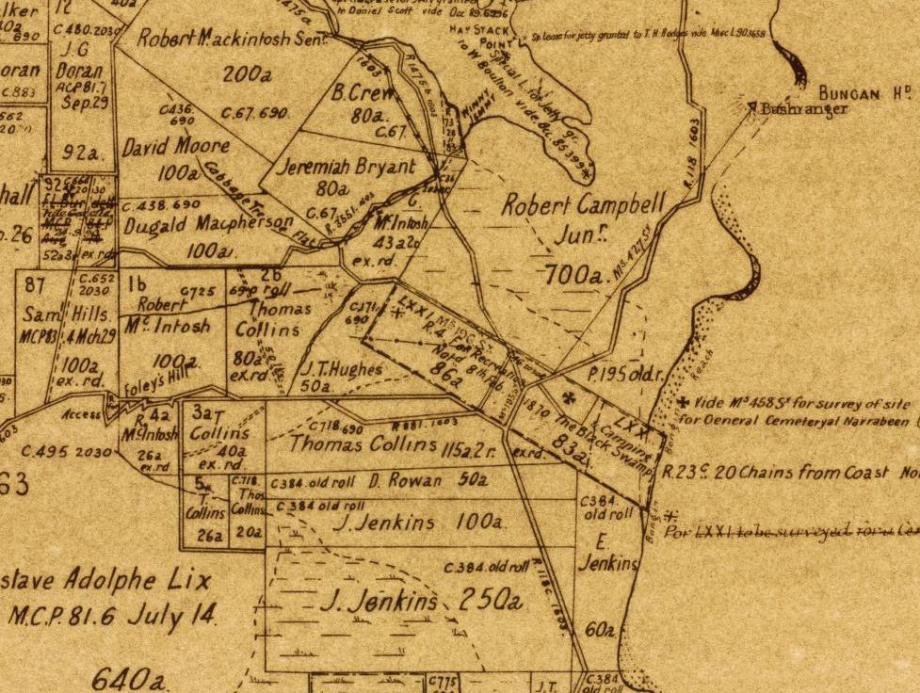
Parish of Narrabeen, County of Cumberland [cartographic material] : Metropolitan Land District, Eastern Division N.S.W. 1886. MAPG8971.G46 svar (Copy 1). Courtesy National Library of Australia
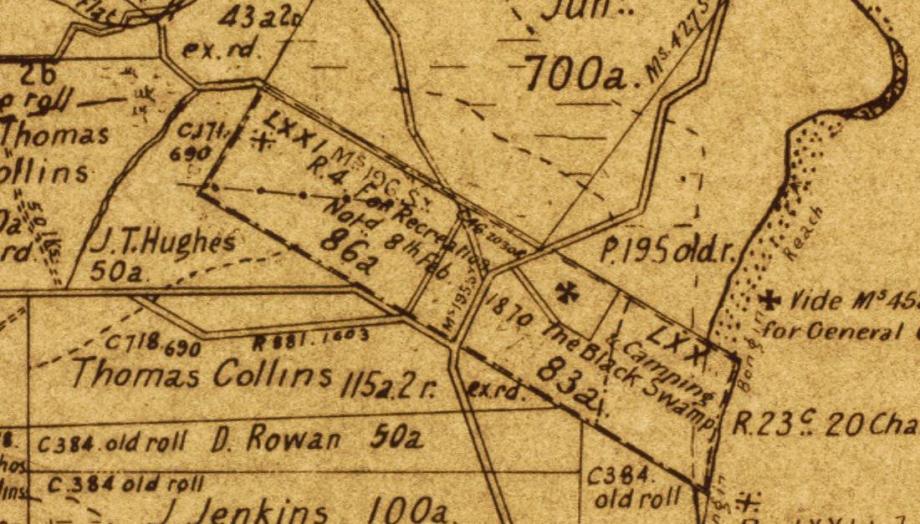
Prior to then an 1886 Land map indicates previous names for this 'Recreation Area' and that 86 acres and 83 acres were set aside on February 8th 1870 and it was envisioned people would go camping in a 'black swamp'. The water was black as there is peat under much of present day Mona Vale Golf Course. Creeks from the west, south west and south fed into the reserve to fill undulations in the landscape.
.jpg?timestamp=1679139660330)
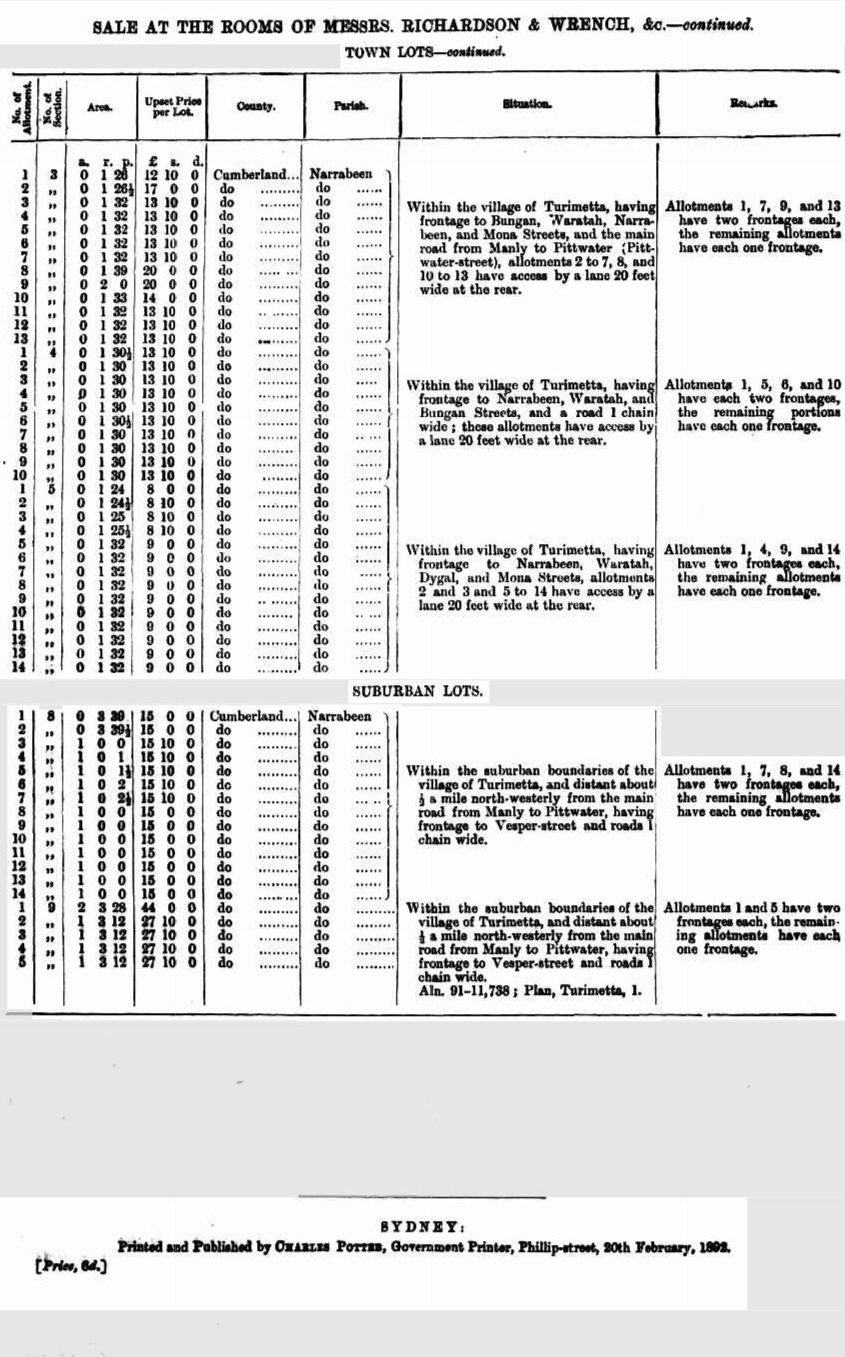

.jpg?timestamp=1679139769220)

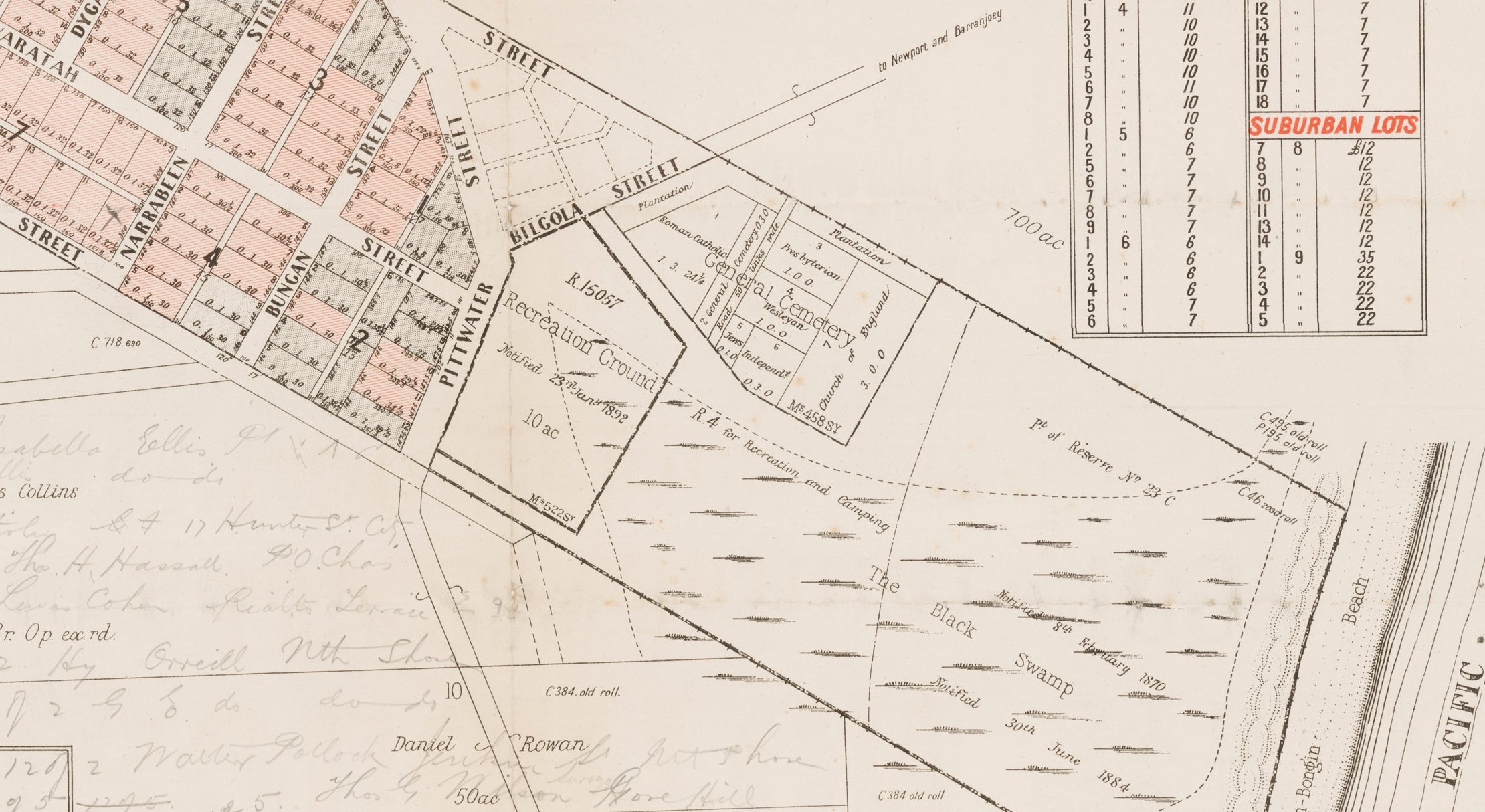
Plan of the Village of Turimetta and Suburban Lands - Parish of Narrabeen - Vesper St, Mona Street, Allen St, Pittwater St, Wangara St, 1897 “Village of Turimetta” with cemetery. Note the site of the farm known as “Mona Vale”, a name given to this place by early resident David Foley according to family records. Item c046820016, from Pittwater Subdivision records, courtesy State Library of NSW
Land sales:
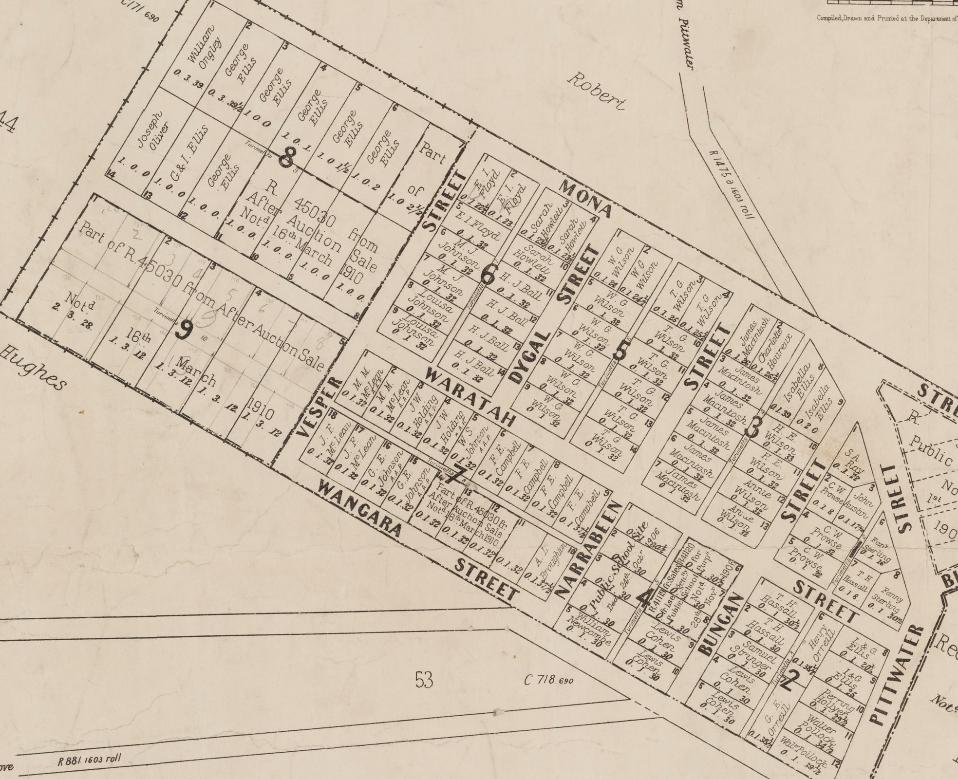
Interesting to note that the now Woolworths land area were selling for £11 per Lot in 1897, cheaper than those down around current day Mona Vale Village Park where it would flood. One pound in 1897 equates to around $3 417.77 Australian dollars in 2023, or around $37,595.47 per Lot - a substantial increase but nowhere near what units built on single Lots of land are selling for in Mona Vale presently. All up Mr. Macintosh's 6 Lots would command $225,572.82 at that scale.
Further, an The Australian Jewish News report from 1999 tells us:
Compare this sale with that of the Woolworths supermarket in Mona Vale sold to a Sydney investor for $16 million on a yield of 6.25 per cent. Launceston sale at $5.85 m (1999, September 10). The Australian Jewish News (Melbourne, Vic. : 1935 - 1999), p. 9 (Property and Investment). Retrieved from http://nla.gov.au/nla.news-article260923135
Woolworths record sale
AMP Henderson Global Investments has just completed a record sale of the freestanding Woolworths supermarket in Queanbeyan NSW. The property was part of the GIO portfolio and was sold off-market by Burgess Rawson & Associates Pty Ltd to a private investor from Melbourne.
The supermarket sold for $13.35 million on a yield of 8.4%. This is the biggest sale in value terms in Australia, outside Melbourne and Sydney and ranks as the third largest sale ever (Safeway Fitzroy sold last year for $13.55 million and Mona Vale in Sydney for $16 million two years ago).
According to Chris Burgess who acted for AMP Henderson in negotiating the sale... "the reasons for the record price are twofold; the successful turnover growth of the store, particularly in the last 3 years has resulted in high annual rental by way of a flat 2%; the low interest rate environment together with the general economic uncertainty has increased the demand for supermarkets where a large proportion of turnover is non-discretionary - rather than discretionary or non-essential spending and therefore immune from an economic downturn "
The deal was negotiated off market to a private investor, however, there was considerable competition from the institutional market resulting in a price considerably above AMP's book value.
Located at 27 Antill Street, Queanbeyan, NSW the store has competition from a new Aldi and an existing Coles. The site area is 1.346 Ha and the store has a GLA of 4,133 m2 with 208 on-grade car spaces.
The 20-year lease expires on 22 March 2002 and Woolworths have taken up the second last of its two 5-year options. Woolworths pay all outgoings making the yield a true net return. Woolworths record sale (2002, February 8). The Australian Jewish News (Sydney, NSW : 1990 - 2008), p. 2 (Property Review Weekly). Retrieved from http://nla.gov.au/nla.news-article262899467

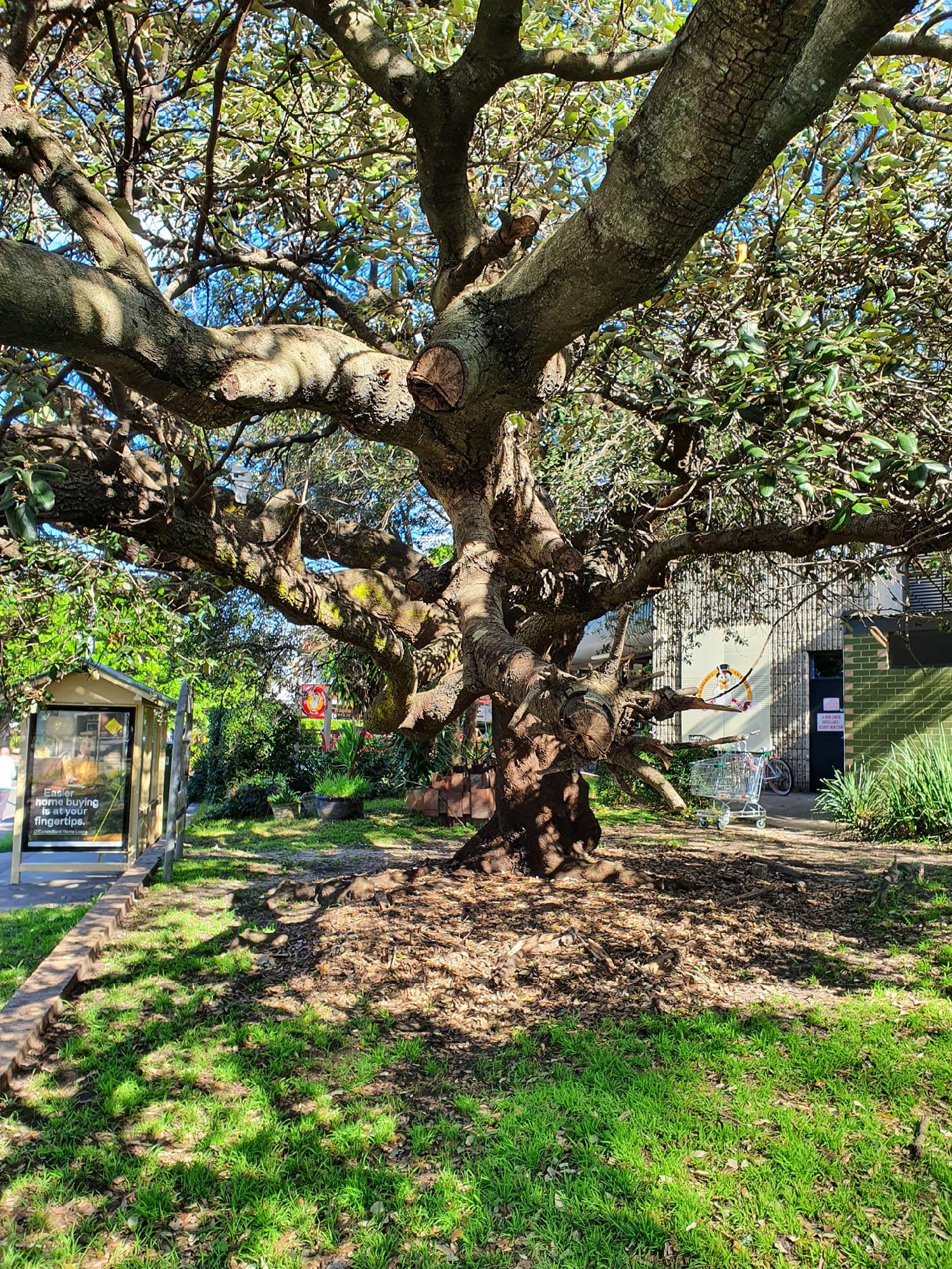
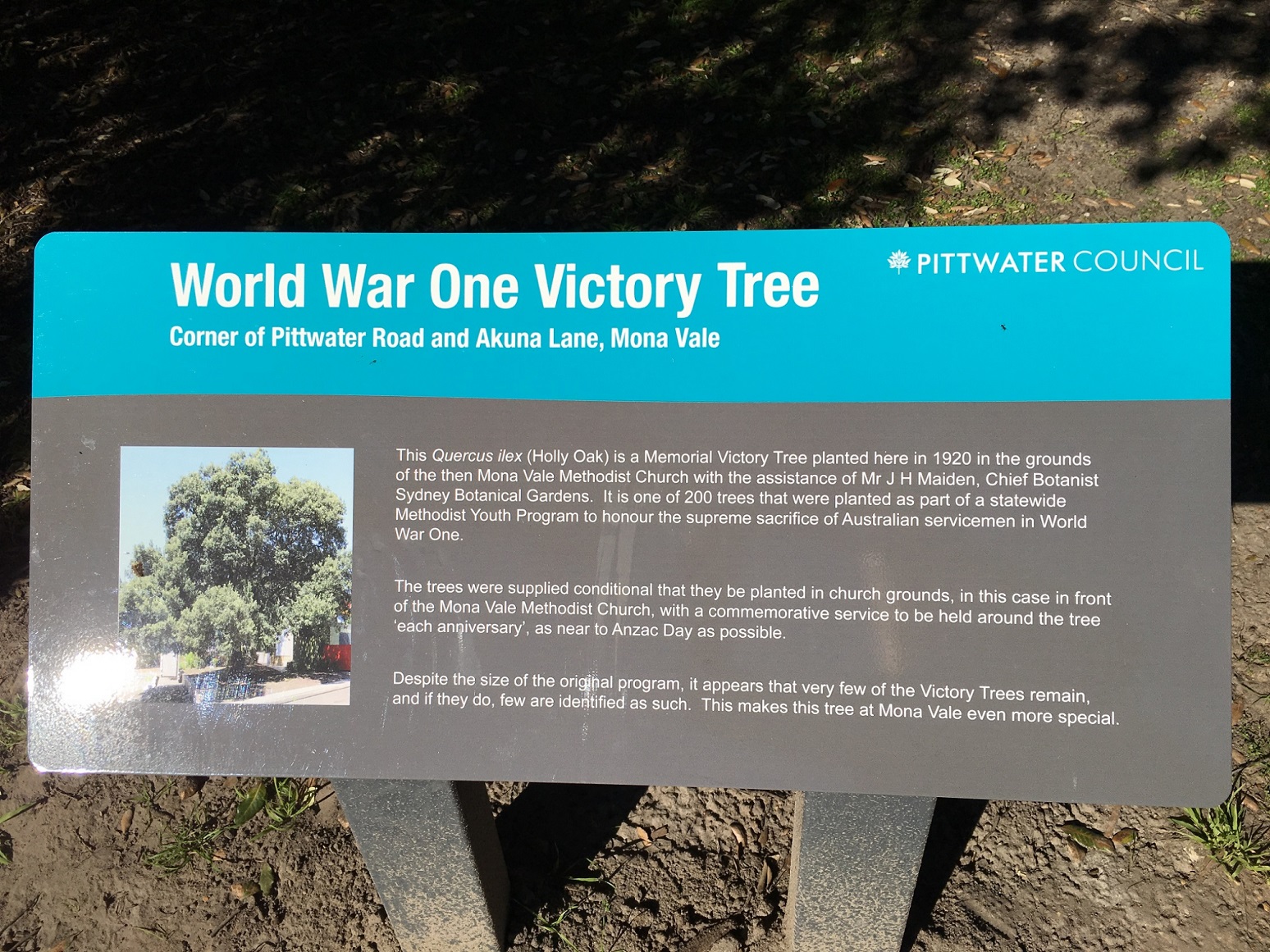
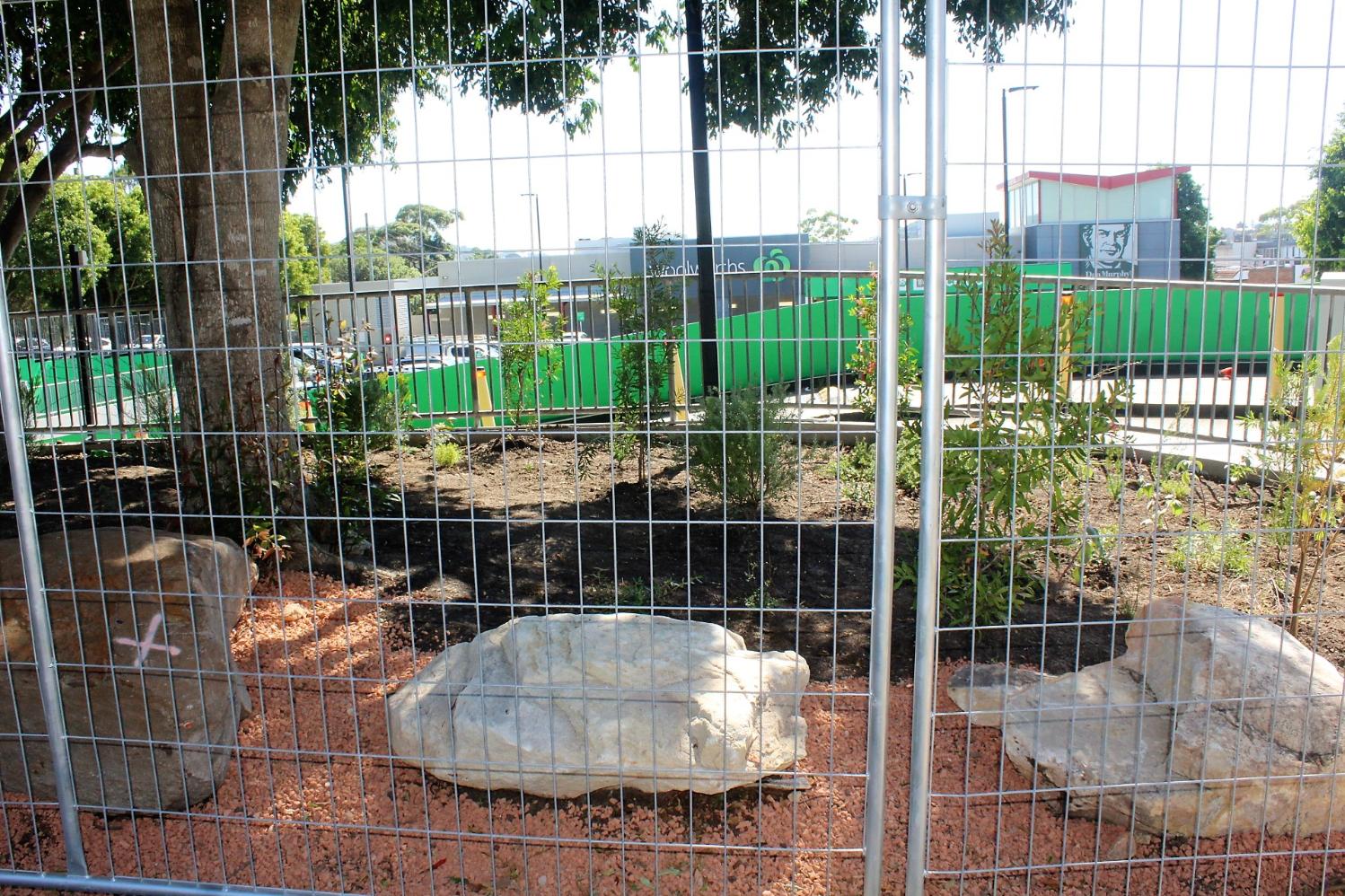
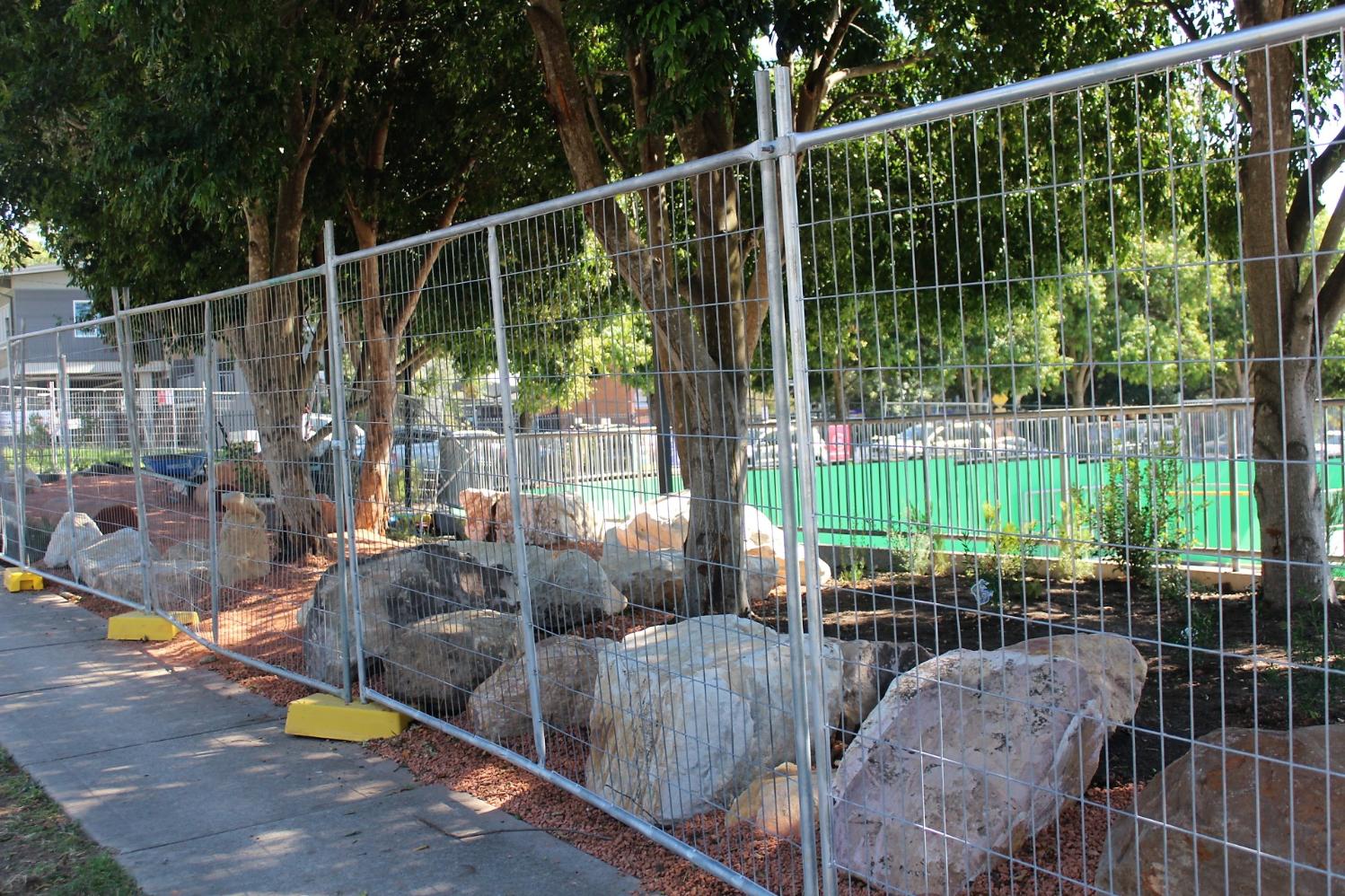
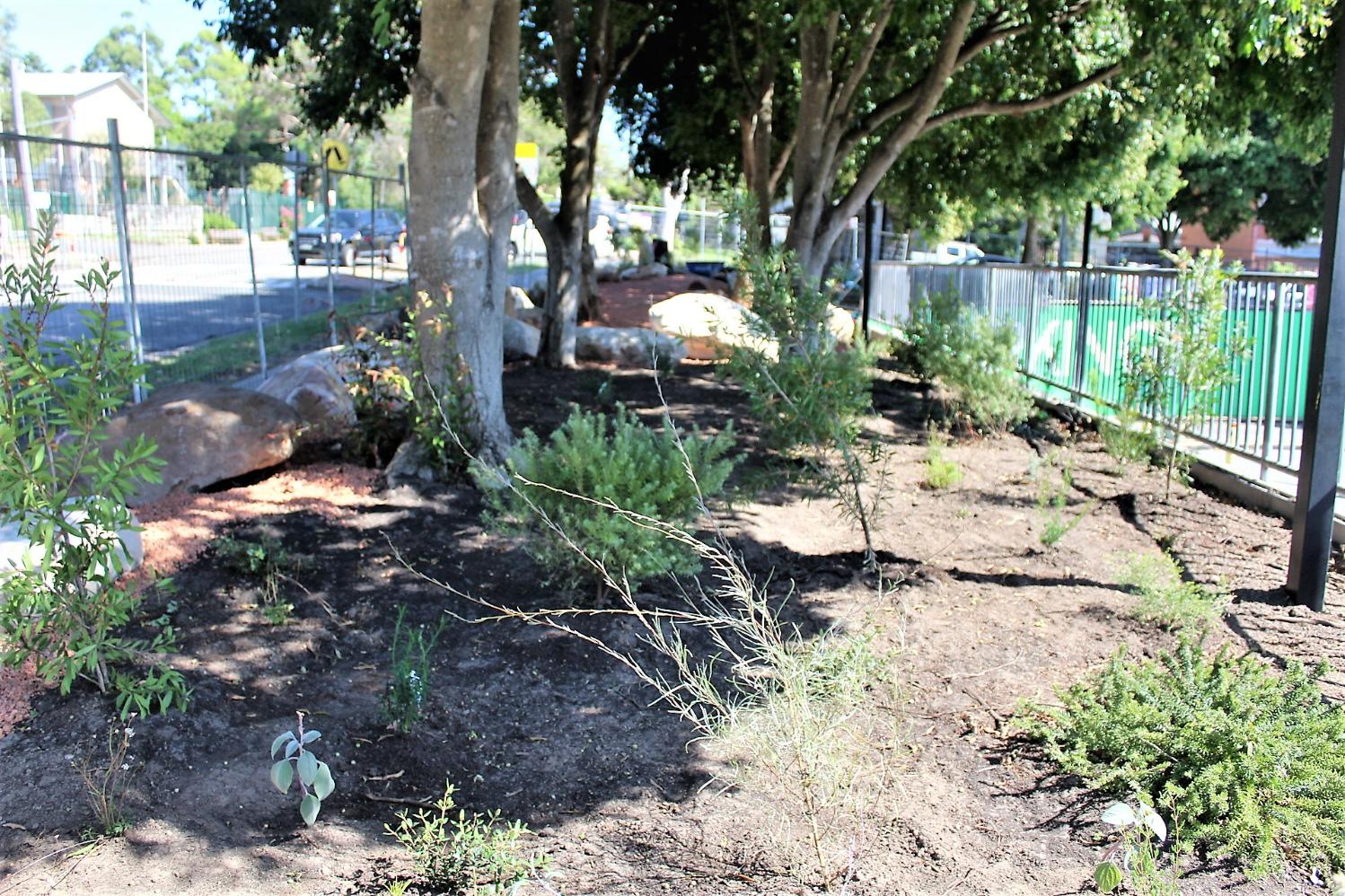

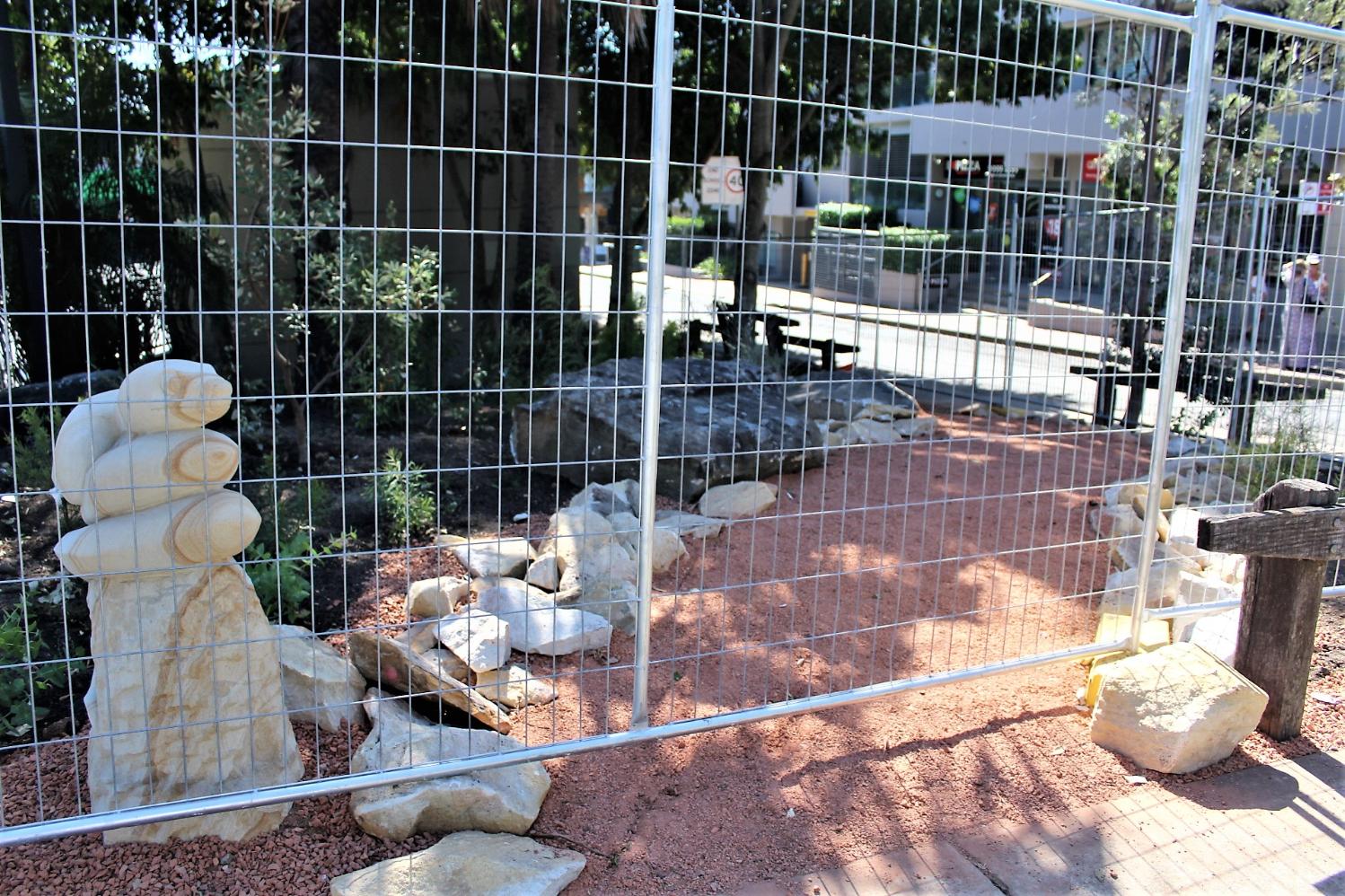
Narrabeen Creek Bird Gathering: Curious Juvenile Swamp Hen On Warriewood Boardwalk + Dusky Moorhens + Buff Banded Rails - Notes About Our Local Waterhens
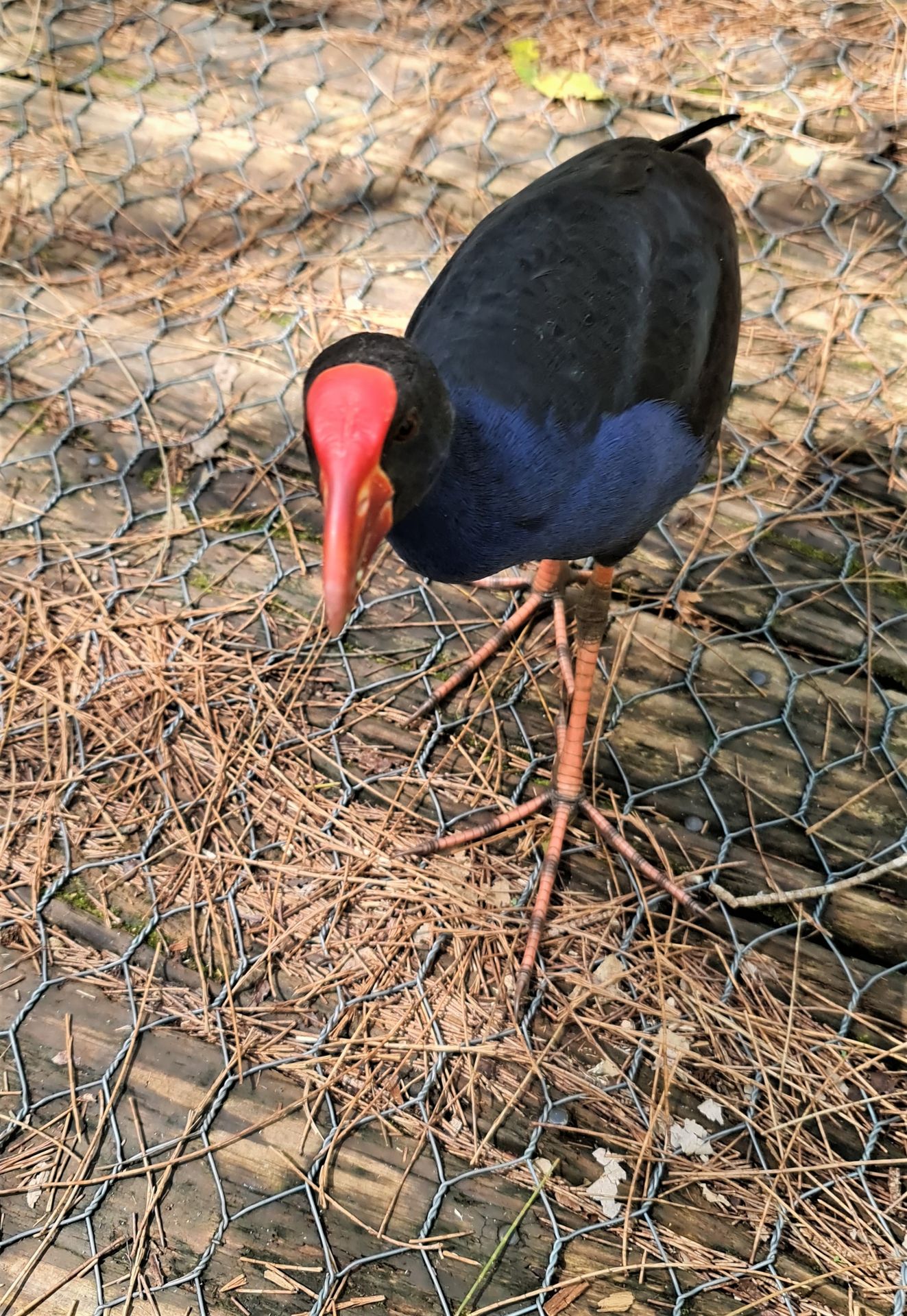
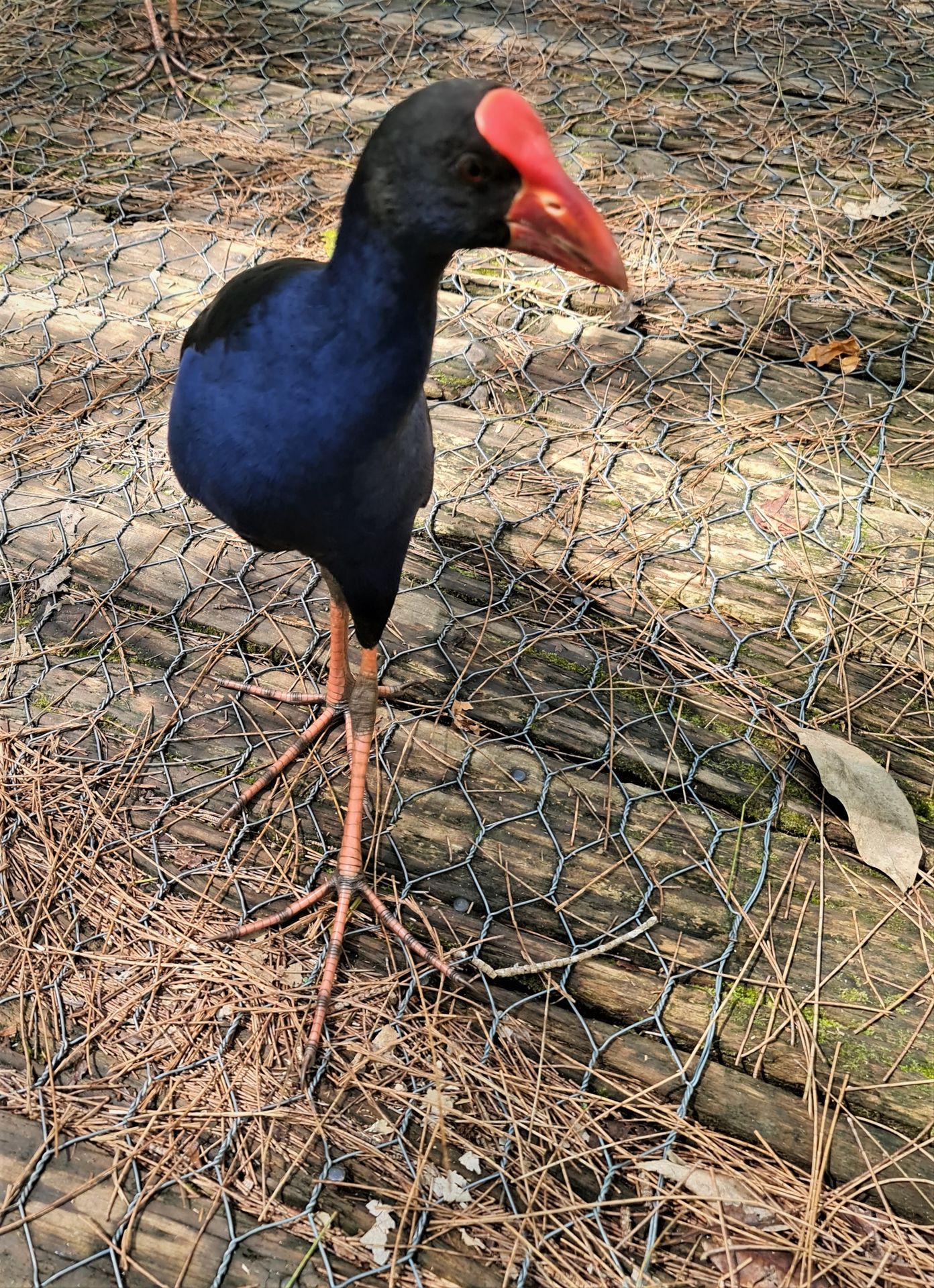
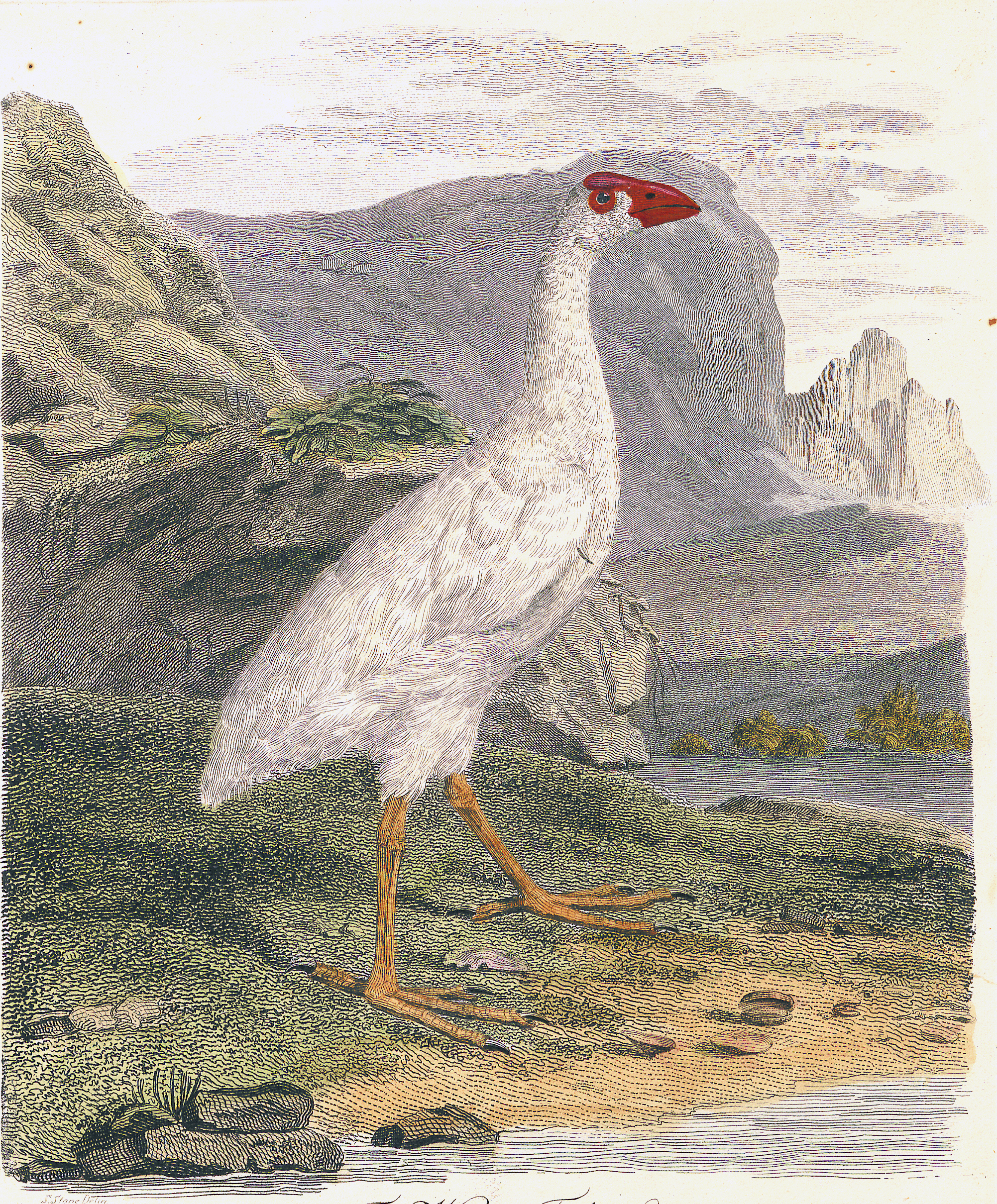
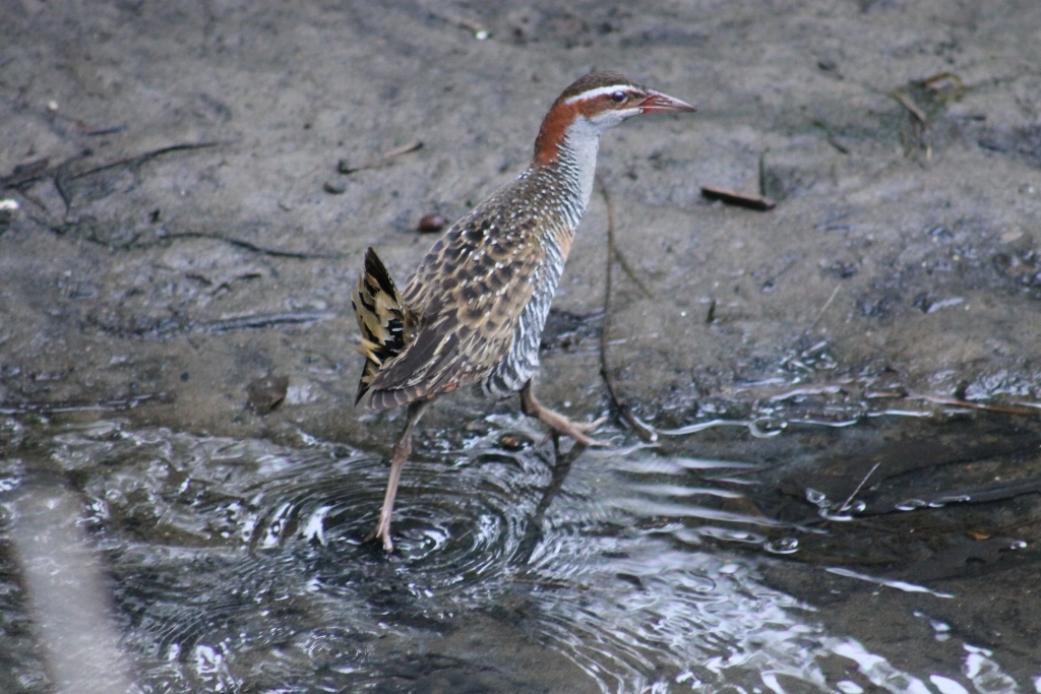
Buff-banded Rail pair (Gallirallus philippensis) - Careel Creek, December 2012. Photos: AJG
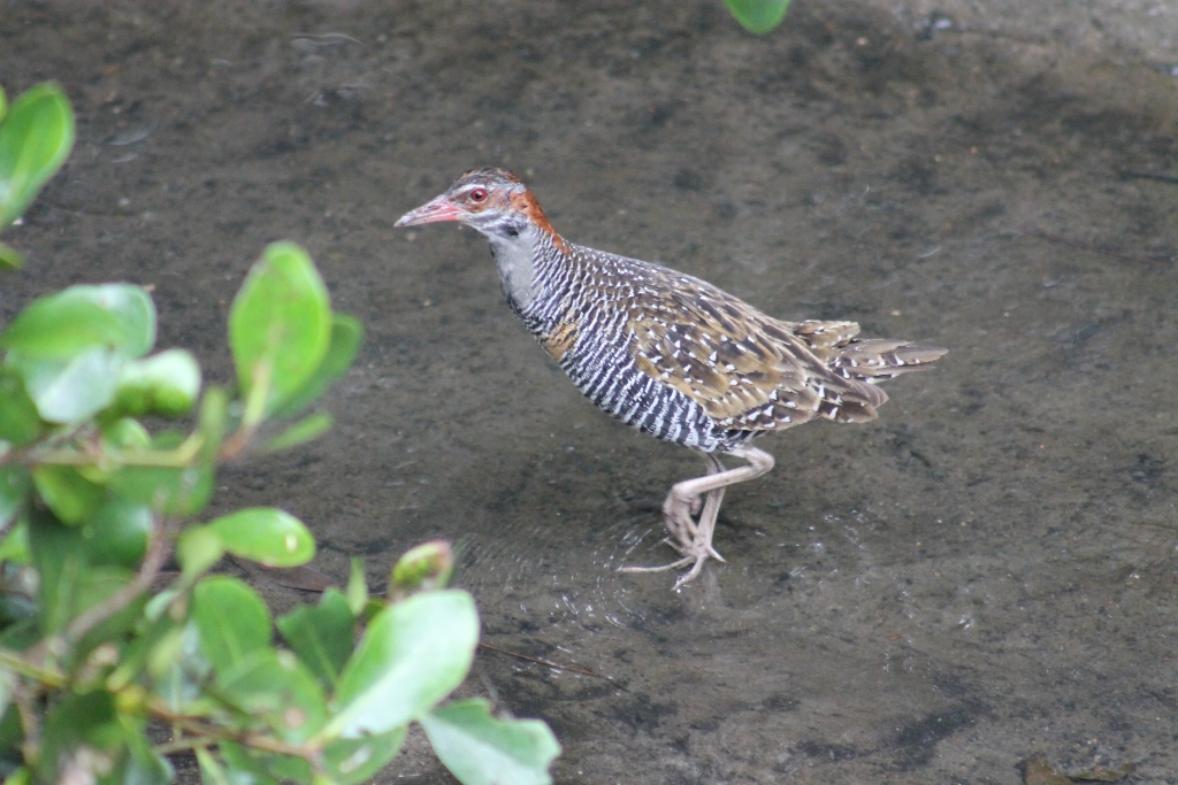
In December 2012 a pair of Buff-banded Rails and a single tiny black fluffy black chick were spotted on Careel Creek. While at first unconcerned about the presence of the bird-watcher, alarmed peeps came from who is obviously the mum of the pair when the baby began stumbling and so a quiet retreat was in order while making soothing noises. These pictures were snapped quickly so as not to alarm the pair or baby.
The sight of these birds, kindly identified for us by Marita Macrae of PNHA, has not occurred outside of the Warriewood wetlands or the Royal Botanic Gardens for some time. Thus our chant; please keep your dogs on their leashes when walking through or beside the habitat of these ground dwelling beautiful birds - and remember that Warriewood is a WPA (Wildlife Preservation Area) where no dogs are allowed.
These birds live ere, people just visit these places.
Their nests are usually situated in dense grassy or reedy vegetation close to water, with a clutch size of 3-4. Seeing only one chick with this pair, and their alarm at being seen, indicates something may have killed the others.
A pair has since been seen closer to the bay at Careel Bay itself.
The Buff-banded Rail is a distinctively coloured, highly dispersive, medium-sized rail of the family Rallidae. This species comprises several subspecies found throughout much of Australasia and the south-west Pacific region, including the Philippines(where it is known as Tikling), New Guinea, Australia, New Zealand (where it is known as the Banded Rail or Moho-pereru in Māori)
They feed on snails, crabs, spiders, beetles and worms, feeding at dawn, dusk and after high tide. They can run at great speed but seldom take to flight.
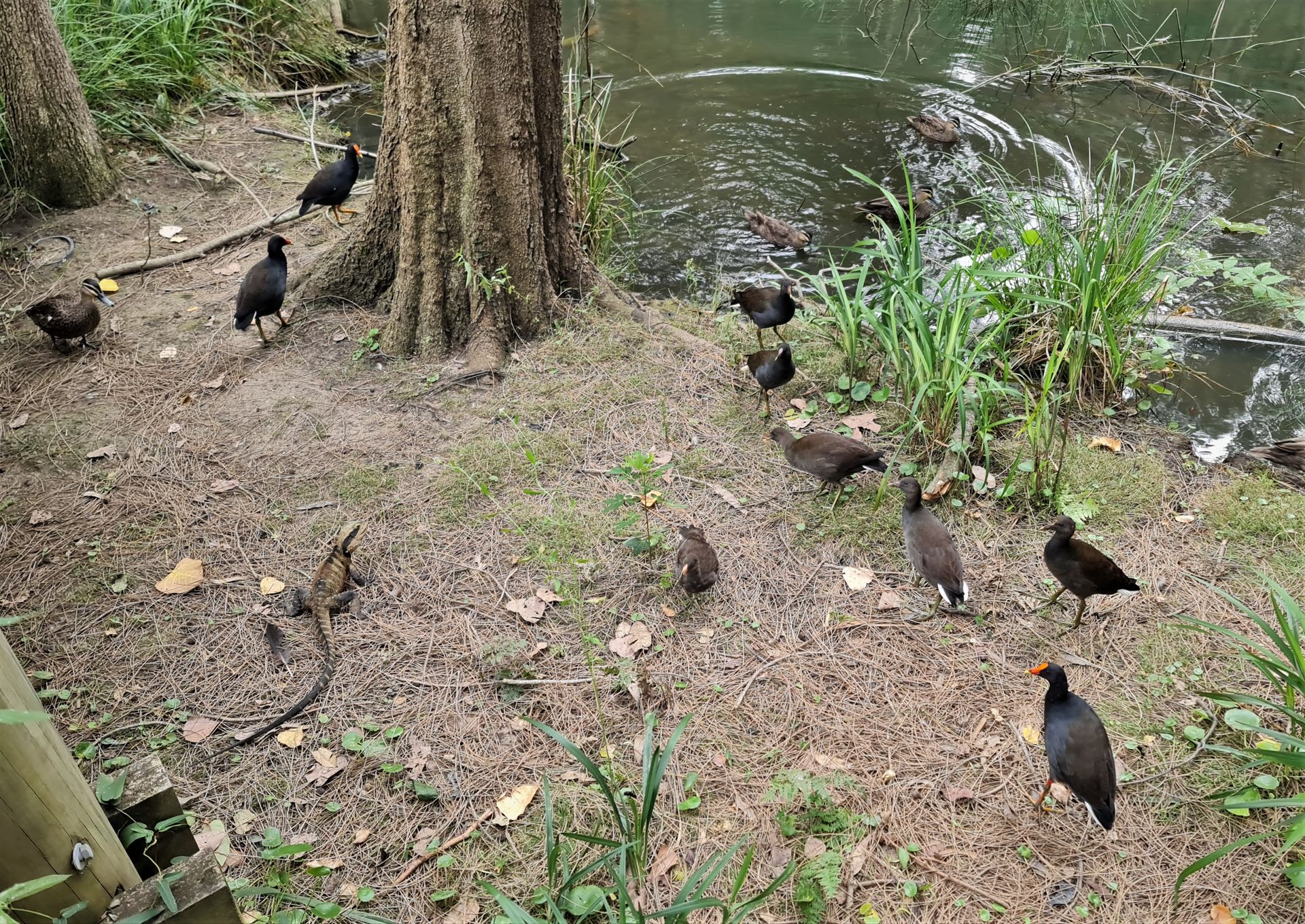
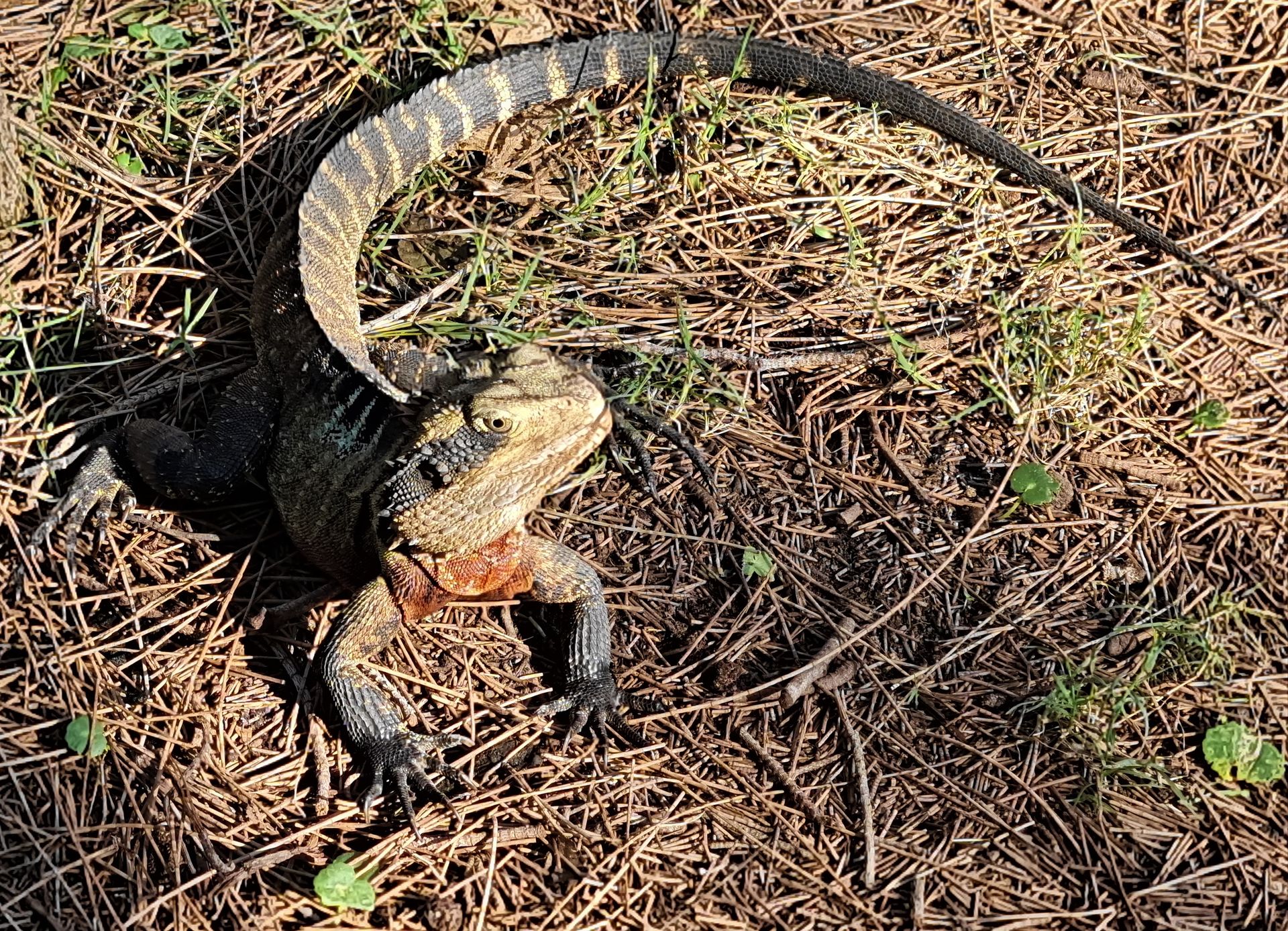
Swamp Wallaby At Palm Beach
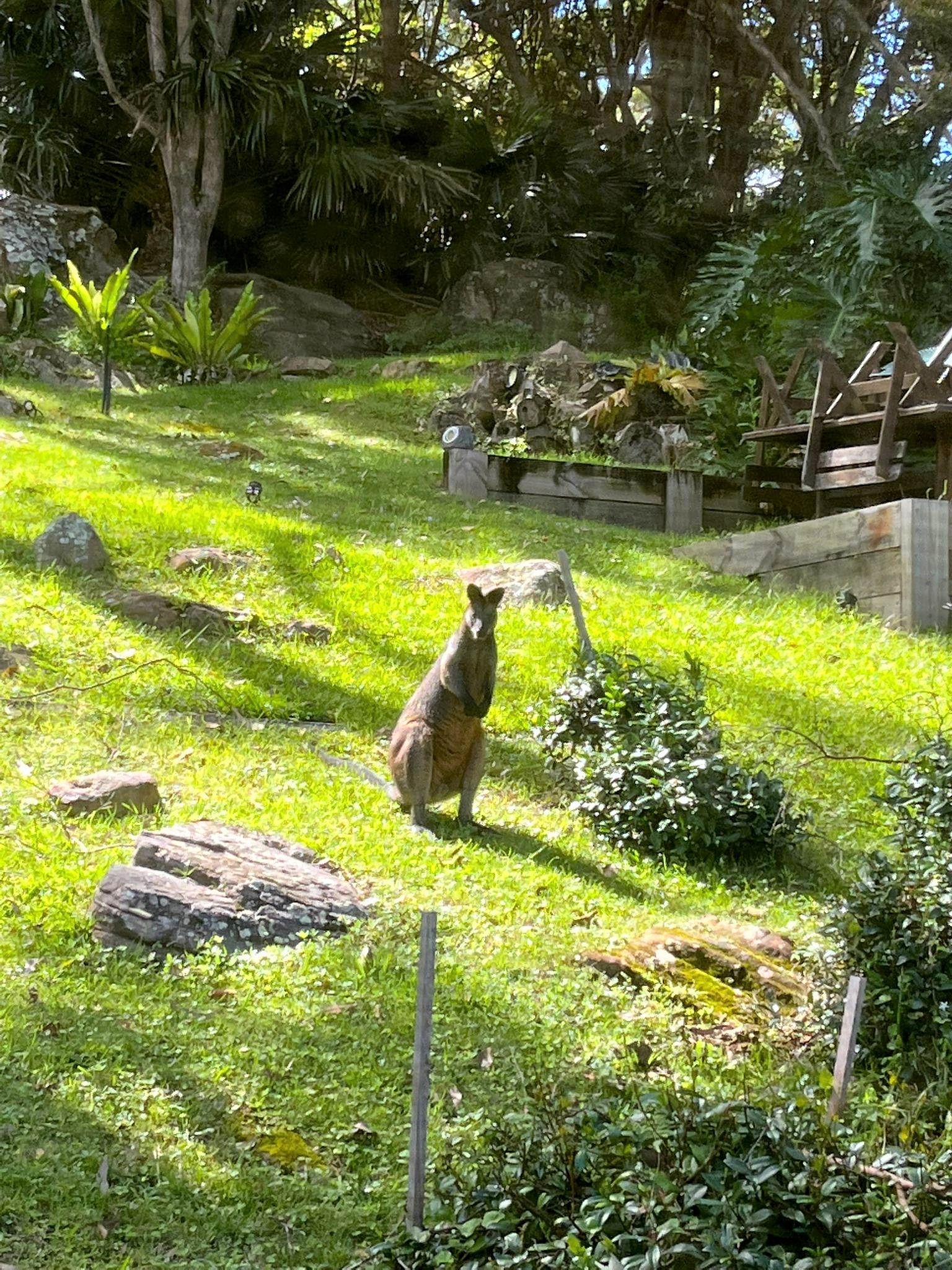
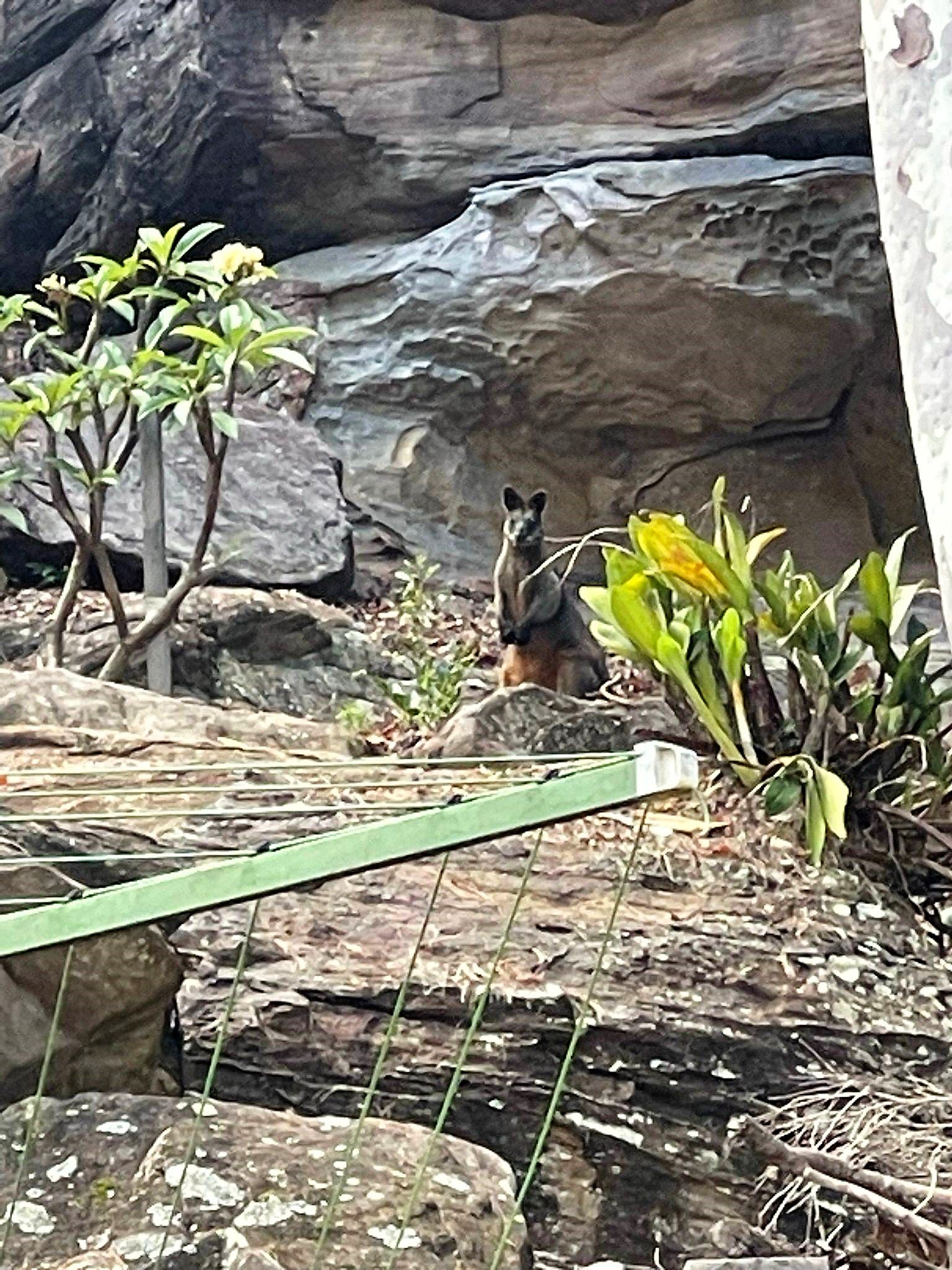
Urgent Action Needed To Avert Ecosystem Collapse Following Darling-Baaka Fish Kill: Greens
March 19, 2023
Cate Faehrmann, Greens MP and water spokesperson, is calling on the NSW and Federal Governments to take emergency action to remove the millions of dead fish from the river before they decompose and cause an ecological disaster.
Millions of fish have died and are currently choking the lower Darling-Baake river near Menindee, this situation is more severe than any of the large scale fish kill events that have occurred in recent times and represents an existential threat to the river’s health and community water security.
“This is categorically a catastrophe, regardless of whether this is a consequence of receding floods or water mismanagement, the NSW and Federal Governments should be acting now to clean up the millions of rotting fish which are spanning kilometres of the river,” said Cate Faehrmann
“We are experiencing a natural disaster in the Darling-Baaka river right now and government departments and agencies are ducking responsibility and writing this off as a natural event - that is utter nonsense and is doing nothing to help.
“Right now, every natural aspect of the river and the communities that rely on it for water are threatened with cascading collapse and these millions of fish that are rotting away are a harmful tragedy and will further degrade the system and quality of the water.
“The NSW and Federal Governments should be mobilising their considerable resources to avert the ecosystem harm that this fish kill will lead to. The State Emergency Service, the Army Reserve - whatever it takes to clean the Darling-Baaka needs to be happening right now. To suggest the scale is too difficult to deal with is unacceptable. We must get to work, like we would in any state emergency.
“While Dominic Perrottet is making Tik Toks in Sydney, the Murray Darling Basin is in a crisis of unprecedented proportions. Both levels of Government need to pull their fingers out and get these millions of dead fish out of the river before we are facing a compounding disaster that will reverberate along the entire river," said Cate Faehrmann
NSW DPI Fisheries released the following statement on Saturday March 18, 2023:
DPI is aware of a developing large-scale fish death event on the Lower Darling-Baaka below Menindee Main Weir through to Weir 32, adjacent to the Menindee township. It is estimated that millions of fish, predominantly Bony Herring (Bony Bream) have been affected, as well as smaller numbers of other large-bodied species such as Murray Cod, Golden Perch, Silver Perch and Carp.
This event is ongoing as a heatwave across western NSW continues to put further stress on a system that has experienced extreme conditions from wide-scale flooding.
NSW DPI understands that fish death events are distressing to the local community, particularly on the Lower Darling-Baaka.
The Bony Herring species typically booms and busts over time. It ‘booms’ in population numbers during flood times and can then experience significant mortalities or ‘busts’ when flows return to more normal levels. They can also be more susceptible to environmental stresses like low oxygen levels especially during extreme conditions such as increased temperatures currently being experienced in the area.
These fish deaths are related to low oxygen levels in the water (hypoxia) as flood waters recede. Significant volumes of fish including Carp and Bony Herring, nutrients and organic matter from the floodplain are being concentrated back into the river channel. The current hot weather in the region is also exacerbating hypoxia, as warmer water holds less oxygen than cold water, and fish have higher oxygen needs at warmer temperatures.
Multiple agencies across NSW and Commonwealth are continuing to work together on the response.
Community members are encouraged to report any fish deaths or observations through the Fishers Watch phoneline on 1800 043 536.
For more information on fish kills please visit: www.dpi.nsw.gov.au/fishing/habitat/threats/fish-kills
Not The First Time Millions Of Fish Have Died In This System
In January 2019, just before the state headed into one of the largest broad scale bushfire seasons in a generation, with fires commencing in July and culminating in the November to February 2020 disasters, NSW DPI were investigating another large fish kill at Menindee. The statement released then reads:
The NSW Department of Primary Industries (DPI) and WaterNSW are investigating a large fish kill at Menindee in Western NSW.
In recent weeks fish kills have occurred in the Namoi River below Keepit Dam, the Lachlan River at Wyangala Dam and also in the the Darling River at Menindee in a separate event in December.
DPI Senior Fisheries Manager, Anthony Townsend, said fisheries officers have visited the affected area downstream of Menindee today and are investigating the incident.
“The ongoing drought conditions across western NSW have resulted in fish kills in a number of waterways recently and today our fisheries officers have confirmed a major fish kill event in the Darling River at Menindee affecting hundreds of thousands of fish, including Golden Perch, Murray Cod and Bony Herring,” Mr Townsend said.
“After a very hot period, a sharp cool change hit the Menindee region over the weekend, with large temperature drops experienced.
“This sudden drop in temperature may have disrupted an existing algal bloom at Menindee, killing the algae and resulting in the depletion of dissolved oxygen.”
The incident follows an earlier fish kill in December, after intense rainfall events following hot weather, which disrupted algal blooms resulting in low dissolved oxygen levels conditions that exacerbated water quality for already stressed fish.
During the December event investigations by District Fisheries Officers from DPI revealed over 10,000 fish mortalities along a 40km stretch of the Darling River, including numerous Murray Cod, Golden Perch and Silver Perch, and native Bony Herring.
Mr Townsend said preliminary investigations by DPI into the current fish kill event suggest that hundreds of thousands of native fish have been impacted in the same stretch of waterway and further downstream.
“As a result of this incident, DPI will take this opportunity to learn more about our native fish to help improve their future management,” Mr Townsend said.
“Our fisheries experts are extracting otoliths (or the ear bone) from some of the Murray Cod killed during the event to improve our knowledge of the species.
“Otoliths allow us to work out how old a fish is and can be used to help establish age and length/weight relationships, as well as potentially unearth other secrets including where the fish was born and spent its life through microchemistry work.
“All of this new knowledge will help improve how we manage waterways and the fishery across the entire Murray-Darling Basin to help protect and improve native fish populations when conditions improve.
“Fisheries staff would like to thank local anglers and residents who have provided information.
“The current low flows and warming temperatures are likely to pose an ongoing threat to native fish throughout the summer.”
WaterNSW is continuing to monitor water quality throughout the dams and river systems.
Adrian Langdon, WaterNSW executive manager of systems operations said regional NSW is experiencing intense drought conditions, with the state’s Central West, Far West and North West regions the worst affected.
“Algal alerts have been in place for several weeks in the Menindee region and linked to this, low dissolved oxygen levels are likely to occur within slow flowing or no flow sections of the river,” Mr Langdon said.
“It is almost certain these impacts will persist and possibly increase further as summer proceeds if we don’t receive significant rainfall to generate replenishment flows.”
However, the locals, in a report run by The Land in January 2019 report, stated it was a disaster made by the MDBA and NSW Coalition government through over allocation of water from the river to a few. They were furious fish that were estimated to be around 100 years old were dead, furious this was being perpetuated and stated the policies of the then incumbent Federal and NSW State government were killing the river system, stating you could tell just by looking at the colour of the water that the rivers were ill.
An independent panel determined there were three main causes for the fish deaths in the Lower Darling in 2018 and 2019.
- not enough water flowing in the river
- poor water quality
- a sudden change in temperature.
The The Murray–Darling Basin Authority (MDBA) conducted an investigation which stated that between December 2018 and January 2019, three mass fish death events happened in the Lower Darling. Although this is often described as the Menindee Lakes fish kill, the events covered a 40km stretch of the Darling River, downstream of Menindee Lakes.
The exact number of fish deaths is unknown, but an independent panel chaired by Professor Rob Vertessy concluded that over a million fish may have died in the fish death events.
The main native fish that were affected were:
- bony herring
- Murray cod
- silver perch
- golden perch
The mass death events in the Lower Darling were caused by a combination of several factors, including:
- an extended period of very hot weather leading to layering of the water, with a layer of cooler water with very low oxygen levels near the bed of the river
- sudden temperature drop aided by other weather conditions caused this low oxygen water to mix depleting oxygen throughout the water below the threshold fish needed to breathe
- the lack of water flowing into the northern rivers due to low rainfall and high evaporation rates
- over-allocation of water resources in the Basin for many years.
When the Menindee lakes are full they are used by some native species as major 'nursery habitats' (areas which support young fish).
Heavy rainfall and flooding in 2012 and 2016 led to an increase in the numbers of fish living in the Barwon-Darling. By 2018, there were extremely high numbers of young and mature fish in the Menindee Lakes system and in the river.
However, from 2016 there were extended hot and dry weather conditions. The lack of water coming into the lakes (‘low inflows’) and reduced amounts of water being released from the lakes into the lower Darling River, resulted in poor water quality. By 2019 the remaining water in the Menindee Lakes and lower Darling River had dropped significantly and was of poor quality and so could not sustain high numbers of fish.
The Panel’s reports on the fish deaths are available here: www.mdba.gov.au/publications/mdba-reports/response-fish-deaths-lower-darling
In March 2019 Pittwater Online ran a new study out of the ANU which found billions of dollars are being wasted in water recovery subsidies to increase irrigation efficiency across the Murray-Darling Basin.
- An unprecedented breeding program, utilising government and private hatcheries, to ensure the long-term sustainability of the iconic Murray Cod and other native species, such as Trout Cod and Golden Perch;
- Artificial aeration, oxygenation and chemical treatments to support water quality and fish survival across river systems;
- Extra dedicated fish teams to conduct rescue operations during fish kill events ;
- A $4 million expansion of the Department of Primary Industries’ flagship Fisheries Hatchery and Research Centre in Narrandera, as well as other facilities, which will house many of the rescued fish; and
- The State’s largest restocking program in history of rescued and bred native fish once normal water conditions return.
- Environmental water. Inadequate protection of held environmental water especially in sub-catchments of the Upper Darling River. Current Water Sharing Plans on exhibition for public comment, as part of the Water Resource Plan consultation, have no rules to protect publicly owned environmental water from extraction.
- Drought of record. Water allocation decisions that are currently based on worst inflow records prior to 2004. This has resulted in over allocation of water resources in inland NSW causing water shortages in this current severe drought.
- Flood plain harvesting. The continued failure of government agencies to fully quantify and assess the environmental impact of floodplain water harvesting as part of the Healthy Floodplains Project.
- NSW SDL adjustment projects. The lack of substantial business cases for NSW Sustainable Diversion Limit adjustment mechanism projects (supply measure projects).
On the afternoon of February 3rd 2023 the NSW Government gazetted regulations to license floodplain harvesting after previous regulations were voted down for the 4th time by the NSW Legislative Council in September 2022. The timing meant the NSW Parliament would not have an opportunity to consider the regulations until after the NSW state election on 25 March.
The NSW Water Minister’s introduction of the floodplain harvesting regulations for a fifth time shortly before an election showed complete and utter contempt for the voters of NSW, Cate Faehrmann, Greens MP and water spokesperson, stated.
“This just shows complete contempt for the voters of NSW and for the traditional owners, downstream communities and farmers who have raised the alarm about these regulations for the entire last term of parliament,” says Ms Faehrmann.
“The National Party has effectively hamstrung the will of the parliament by introducing these regulations now knowing that we will have no opportunity to vote on them until well after the election.
“After each disallowance, I've called on the Water Minister to sit down and negotiate with the community instead of trying to shove the same laws down their throats again, but each time he’s done exactly that.
“These regulations are just about ensuring the National Party’s big irrigator mates in the north get handed $1 billion in water rights for free.
“We all want to see floodplain harvesting licensed, metered and measured, but it needs to be ecologically sustainable and within existing legal limits,” Cate Faehrmann said
Video posted on FB by Graeme McCrabb, who stated; ''Unbelievable!! Menindee NSW! 17/03/2023. Nearly all native dead fish. - Bonnie Bream, Golden perch, Silver Perch, Carp but not many.
Cat Owners Encouraged To Keep Their Pets Safe At Home
Wednesday, 1 March 2023
Northern Beaches residents are being encouraged to keep their pets safe at home as part of a new animal protection campaign.
According to RSPCA NSW, two out of three cat owners have lost a cat to a roaming-related accident, and one in three to a car accident. Northern Beaches Council is proud to be one of 11 councils partnering with RSPCA NSW as part of the Keeping Cats Safe at Home project.
Promoting responsible ownership, the new campaign goes beyond desexing and micro chipping of beloved cats and asks owners to consider keeping their cats at home.
Northern Beaches CEO Ray Brownlee said there’s a dual benefit to cats and local wildlife that flows directly from promoting responsible ownership of domesticated cats.
“Northern Beaches residents love their pets, but they’re also passionate about protecting the local environment,” Mr Brownlee said.
“Because pet cats occupy a special place in our hearts we need to educate the community on how have them microchip and desexed to keep them safe. This initiative has an educational focus. It aims to protect tiny native species like lizards, mammals, baby birds and frogs, while also preventing domesticated cats from falling prey to road accidents.”
In 2021, the NSW Government awarded a $2.5 million grant from the NSW Environmental Trust to RSPCA NSW to deliver the project.
To help promote the campaign, Council is asking cat-lovers living on the Northern Beaches to submit a photo of their cat or kitten living their best life at home and go in the draw to win one of 10 $1000 vouchers for a deluxe outdoor cat enclosure from Catnets. The competition opens on March 1st and closes on Sunday April 9th 2023. Finalists will be published in an online gallery.
For competition details visit www.northernbeaches.nsw.gov.au/environment/non-native-animals/cats/competition-keeping-cats-safe-home
Learn more about keeping cats safe at www.rspcansw.org.au/keeping-cats-safe

Photo: Greg Hume
Black Summer Vigil For Wildlife: April 2nd
The New South Wales Wildlife Council invites all wildlife carers, wildlife vets, vet nurses, first responders and supporters to the upcoming Black Summer Vigil for Wildlife on Sunday April 2nd 2023 starting at 2pm.
Please join us for the Black Summer Vigil, a three-year anniversary memorial service for the three billion animals who lost their lives in the fires – “one of the worst wildlife disasters in modern history”.
Attend online or in-person at Camperdown Memorial Rest Park (Sydney).
RSVP at: blacksummervigil.com
You’ll hear personal stories from the NSW Wildlife Council, Southern Cross Wildlife Care and other first responders across wildlife rescue, rural fire service, photojournalism, Aboriginal custodianship, veterinary medicine, ecology and more.
+ Performance and Ceremony by Jannawi Dance Clan, sharing a Dharug cultural perspective to honour the Ancestors and bring the spirit of the animals into our midst.
Join us to honour the animals who perished – and in doing so, celebrate the unique and extraordinary wildlife of these lands.
Speakers include:
Greg Mullins, Former Commissioner, Fire and Rescue NSW; Climate Councillor and founder, Emergency Leaders for Climate Action. Greg warned Australia's then–Prime Minister in April 2019 that a bushfire catastrophe was coming. He pleaded for support and was ignored, then risked his life dealing with the ramifications on the ground. “You couldn’t see very far because of the orange smoke. Everything was dark. It was probably 2 o’clock in the afternoon but it was like night. Then I saw something moving on the side of the road and I walked closer. It was a mob of kangaroos. The speed of that fire with its pyroconvective storm driving it in every direction, they had nowhere to go. They came out of the forest, on fire, and dropped dead on the road. I’ve never seen that. Kangaroos know what to do in a fire. They’re fast animals. Climate change, driven by the burning of coal, oil, and gas is driving worsening bushfires across Australia, and putting our precious, irreplaceable wildlife in danger.”
Internationally recognised ecologist and WWF board member, Professor Christopher Dickman oversaw the work calculating the animal deaths from Black Summer. A Fellow of the Australian Academy of Science, Professor Dickman already wore the heavy task of being an ecologist during the sixth mass extinction, in the country that has the worst rate of mammalian extinction in the world. On 8 January 2020 media around the world shared his finding that Black Summer fires had killed one billion animals. Sadly, the fires continued for two more months, and his team's final count was three billion. This does not include invertebrates: it is estimated 240 trillion beetles, moths, spiders, yabbies and other invertebrates died in the fires.
Coming up from the South Coast, owner of Wild2Free Kangaroo Sanctuary Rae Harvey, as seen in The Bond and The Fire. She is in the sad position of having personally known and cared for a number of Black Summer's victims: many of the orphaned joeys she cared for were killed in the fires. (She nearly died herself too.) For three years, she has been unable to even speak their names. Now, for the first time, she will tell the story of the joeys she lost.
Cultural burning practitioner and Southern NSW Regional Coordinator with Firesticks Alliance, Djiringanj-Yuin Custodian Dan Morgan. Dan practises using Aboriginal knowledge to heal Country. He has worked for 18 years with the NSW National Parks & Wildlife Service and is on the board of management for the Biamanga National Park, a sacred area home to the last surviving koalas on the NSW south coast – which was partly destroyed by the fires of Black Summer. “The animals that live on our sacred sites are our Ancestors, it's our Cultural obligation to protect them. We have evolved with our Country over thousands of years, nourishing and protecting all living species. Our Country represents our people. So when the fires came, it was devastating to see the aftermath, and the feeling of helplessness was truly traumatising for our people, due to the denial of our Cultural right to manage Country as our Ancestors did for thousands of years prior to colonisation. Australia needs to make legislative changes that allow us to heal Country and our community through the fire knowledge and to stop incinerating ecosystems with destructive 'hazard-reduction' burns."
Head of Programs & Disaster Response at Humane Society International (HSI), Evan Quartermain was one of the first responders on Kangaroo Island where nearly 40% of the island burnt at high severity: “Those were some of the toughest scenes I’d ever witnessed as an animal rescuer: the bodies of charred animals as far as the eye can see. Every time we found an animal alive it felt like a miracle.” As a result of this firsthand experience, HSI commissioned a report into the state of Australia's disaster response for wildlife, which we'll also hear about.
+ More to come.
The Black Summer Vigil is brought to you by the Department of Animals, Animals Australia, the NSW Wildlife Council, World Animal Protection, Humane Society International and Defend the Wild, with support from WIRES, Firesticks Alliance, Nature Conservation Council of NSW, Wild2Free Kangaroo Rescue, Four Paws, Friends of the Koala and Kangaroos Alive.

Permaculture Northern Beaches - Upcoming Events

- Learn about Permaculture design
- Caring for and raising chickens
- Native bees and bee hotels
- Living Skills - soap making
- AND Live Music!
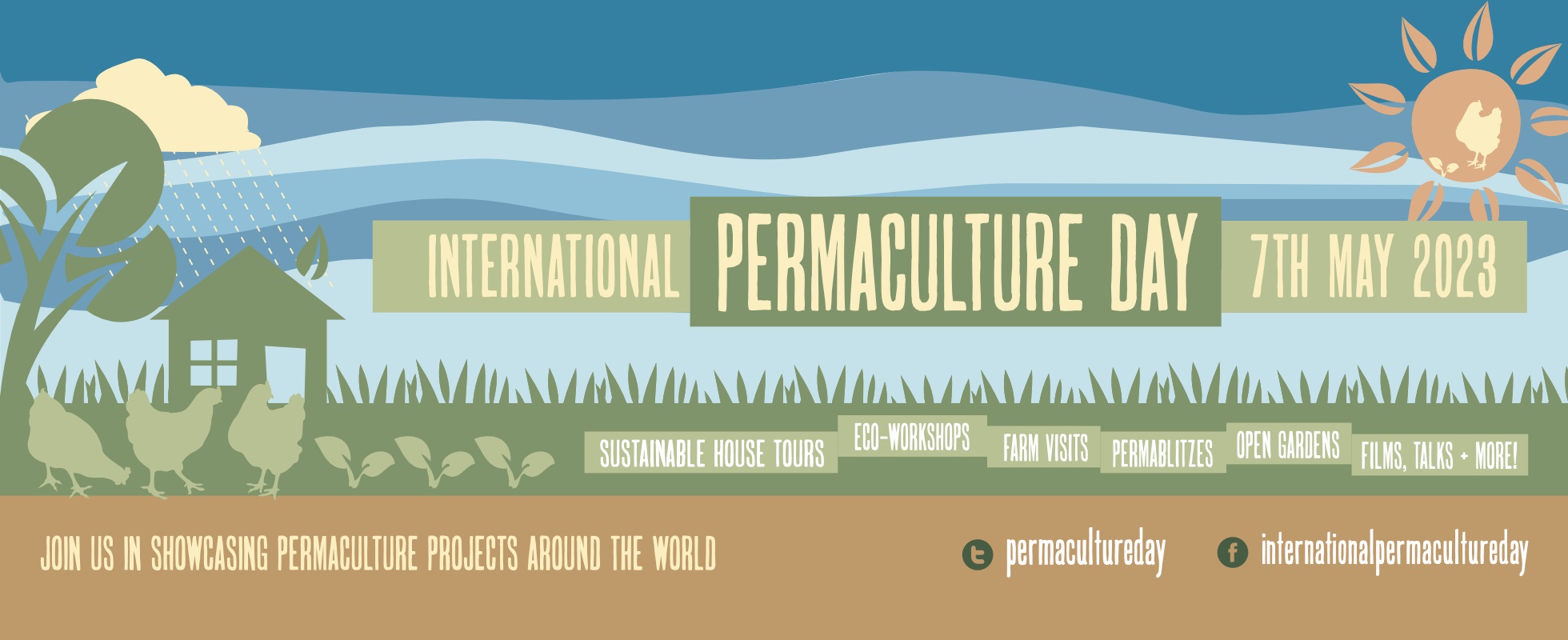
Report Fox Sightings
%20(1).jpg?timestamp=1675893929686)
Weed Of The Week: Cassia - Please Pull Out And Save Our Bush
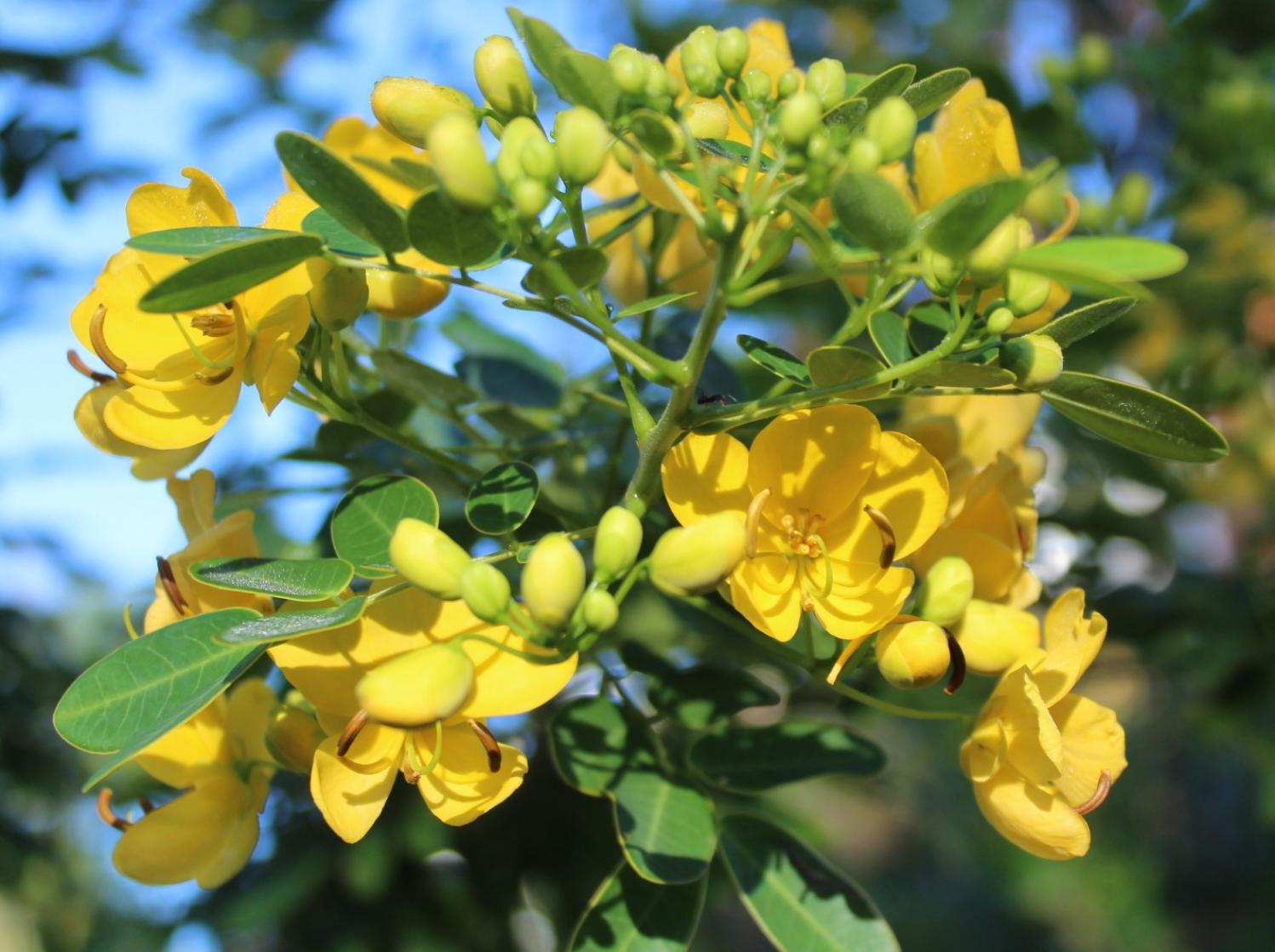
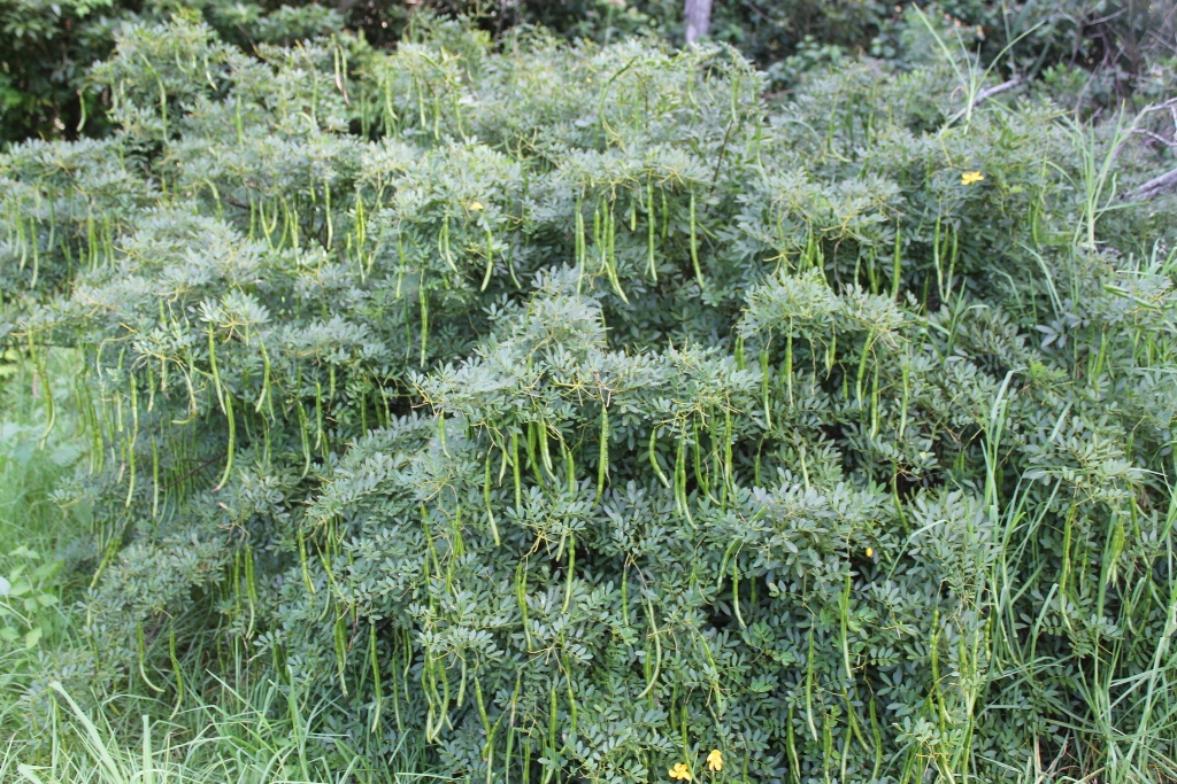
New Marine Wildlife Rescue Group On The Central Coast
A new wildlife group was launched on the Central Coast on Saturday, December 10, 2022.
Marine Wildlife Rescue Central Coast (MWRCC) had its official launch at The Entrance Boat Shed at 10am.
The group comprises current and former members of ASTR, ORRCA, Sea Shepherd, Greenpeace, WIRES and Wildlife ARC, as well as vets, academics, and people from all walks of life.
Well known marine wildlife advocate and activist Cathy Gilmore is spearheading the organisation.
“We believe that it is time the Central Coast looked after its own marine wildlife, and not be under the control or directed by groups that aren’t based locally,” Gilmore said.
“We have the local knowledge and are set up to respond and help injured animals more quickly.
“This also means that donations and money fundraised will go directly into helping our local marine creatures, and not get tied up elsewhere in the state.”
The organisation plans to have rehabilitation facilities and rescue kits placed in strategic locations around the region.
MWRCC will also be in touch with Indigenous groups to learn the traditional importance of the local marine environment and its inhabitants.
“We want to work with these groups and share knowledge between us,” Gilmore said.
“This is an opportunity to help save and protect our local marine wildlife, so if you have passion and commitment, then you are more than welcome to join us.”
Marine Wildlife Rescue Central Coast has a Facebook page where you may contact members. Visit: https://www.facebook.com/profile.php?id=100076317431064
- Ph: 0478 439 965
- Email: marinewildlifecc@gmail.com
- Instagram: marinewildliferescuecc
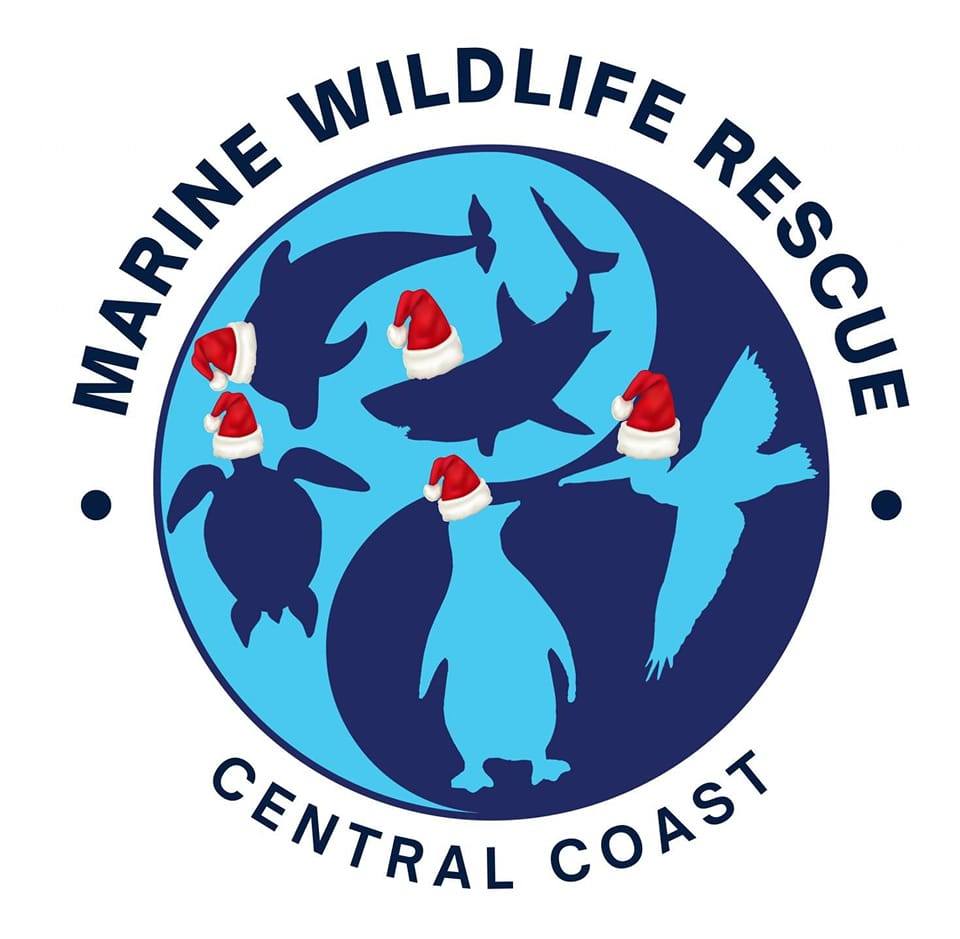
Watch Out - Shorebirds About
.JPG.opt1460x973o0,0s1460x973.jpg?timestamp=1663629195339)
Possums In Your Roof?: Do The Right Thing
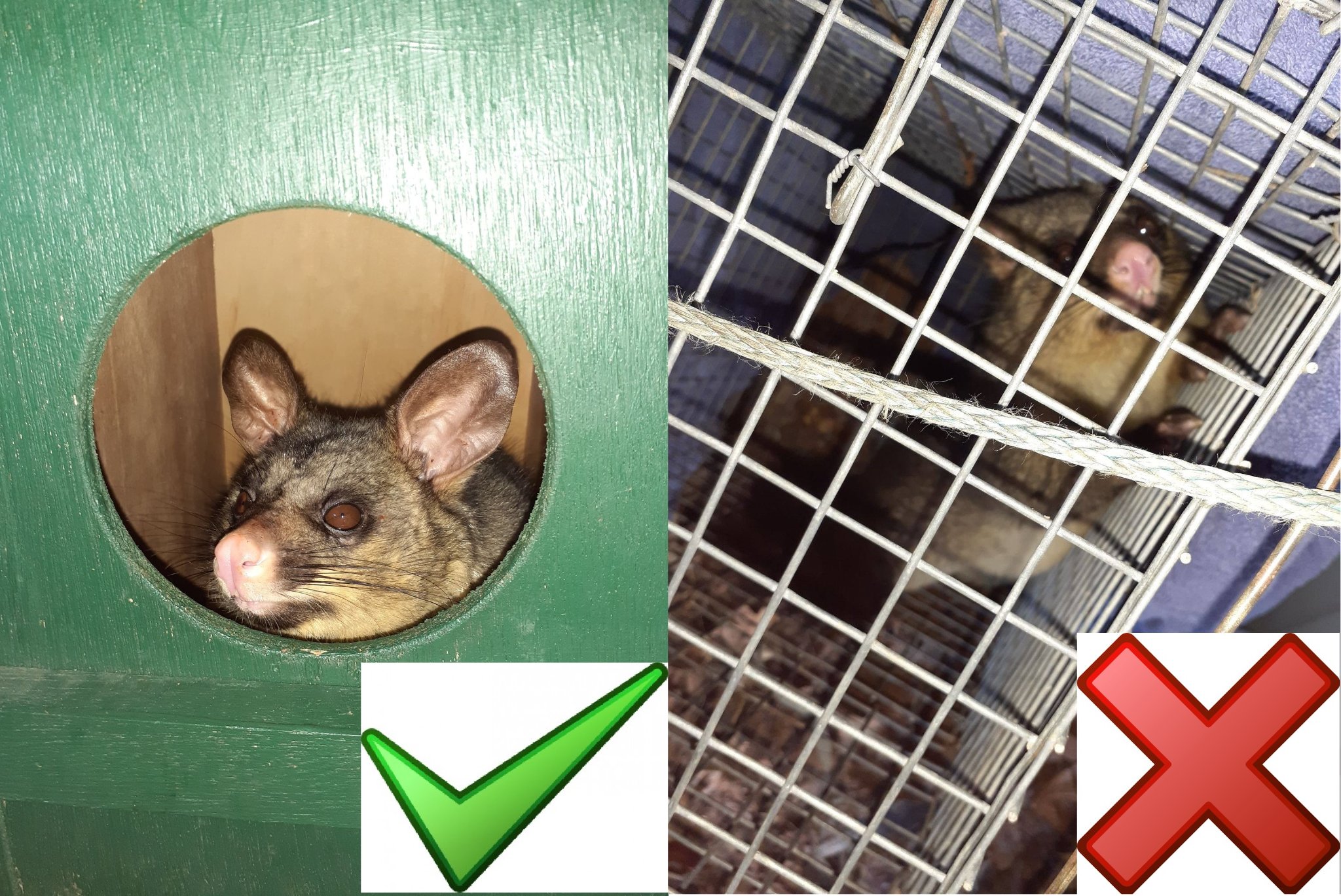
Aviaries + Possum Release Sites Needed

Bushcare In Pittwater
Where we work Which day What time
Avalon
Angophora Reserve 3rd Sunday 8:30 - 11:30am
Avalon Dunes 1st Sunday 8:30 - 11:30am
Avalon Golf Course 2nd Wednesday 3 - 5:30pm
Careel Creek 4th Saturday 8:30 - 11:30am
Toongari Reserve 3rd Saturday 9 - 12noon (8 - 11am in summer)
Bangalley Headland 2nd Sunday 9 to 12noon
Bayview
Winnererremy Bay 4th Sunday 9 to 12noon
Bilgola
North Bilgola Beach 3rd Monday 9 - 12noon
Algona Reserve 1st Saturday 9 - 12noon
Plateau Park 1st Friday 8:30 - 11:30am
Church Point
Browns Bay Reserve 1st Tuesday 9 - 12noon
McCarrs Creek Reserve Contact Bushcare Officer To be confirmed
Clareville
Old Wharf Reserve 3rd Saturday 8 - 11am
Elanora
Kundibah Reserve 4th Sunday 8:30 - 11:30am
Mona Vale
Mona Vale Beach Basin 1st Saturday 8 - 11am
Mona Vale Dunes 2nd Saturday +3rd Thursday 8:30 - 11:30am
Newport
Bungan Beach 4th Sunday 9 - 12noon
Crescent Reserve 3rd Sunday 9 - 12noon
North Newport Beach 4th Saturday 8:30 - 11:30am
Porter Reserve 2nd Saturday 8 - 11am
North Narrabeen
Irrawong Reserve 2nd Saturday 2 - 5pm
Palm Beach
North Palm Beach Dunes 3rd Saturday 9 - 12noon
Scotland Island
Catherine Park 2nd Sunday 10 - 12:30pm
Elizabeth Park 1st Saturday 9 - 12noon
Pathilda Reserve 3rd Saturday 9 - 12noon
Warriewood
Warriewood Wetlands 1st Sunday 8:30 - 11:30am
Whale Beach
Norma Park 1st Friday 9 - 12noon
Western Foreshores
Coopers Point, Elvina Bay 2nd Sunday 10 - 1pm
Rocky Point, Elvina Bay 1st Monday 9 - 12noon
Friends Of Narrabeen Lagoon Catchment Activities

Gardens And Environment Groups And Organisations In Pittwater
Federal Government States It Is Using Every Tool In The Box To Conserve More Of Our Iconic Landscapes; Invites Feedback On Framework
- A geographically defined area other than a Protected Area, which is governed and managed
- in ways that achieve positive and sustained long-term outcomes for the in-situ conservation
- of biodiversity, with associated ecosystem functions and services and where applicable,
- cultural, spiritual, socio-economic, and other locally relevant values.
Thousands of our native plants have no public photographs available. Here’s why that matters
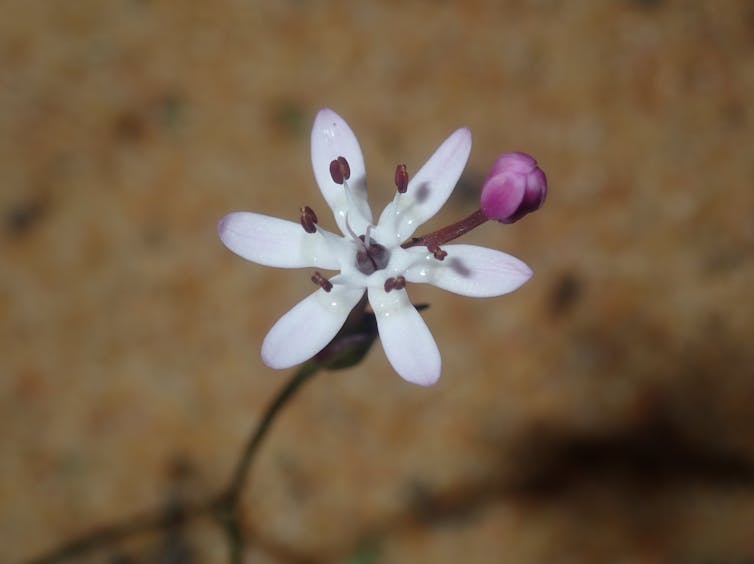
For hundreds of years, botanists have collected plants to describe species and keep in herbaria across the world. But while physical plant specimens are irreplaceable, photographs of plants are also an invaluable resource for botanical research, conservation and education.
Photographs of plants capture information that can be lost from dead, dried plants, such as flower colour. They also provide ecological context and form the cornerstone of many field guides and education resources.
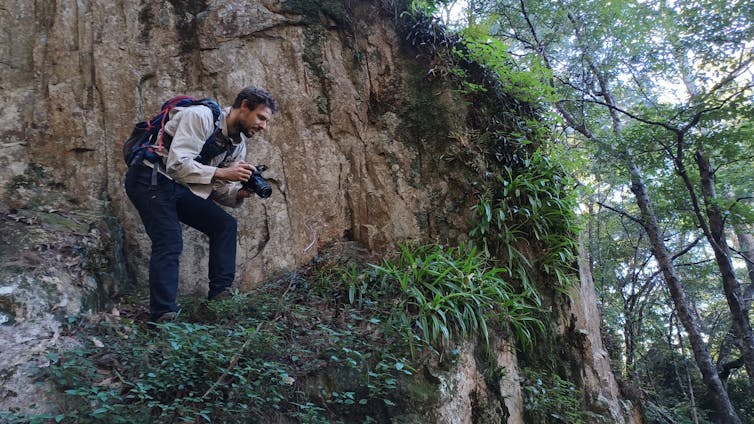
All plant species known to science have samples preserved in at least one herbarium. Under the scientific rules for naming species, a species is not recognised unless there is at least one specimen officially stored in a collection somewhere in the world.
Unfortunately, and perhaps surprisingly, many plants have never been photographed in the field. Just 53% of the 125,000 known plant species in the Americas have field photographs in major online databases.
Given almost 40% of the world’s plant species are threatened with extinction, there’s a strong impetus to photograph as many of these as possible before they disappear forever. Without photographs of these species in the field, many could go extinct without us even realising.
How Does Australia Compare?
We were interested in how the Australian flora stacks up, so in our research, published today, we surveyed 33 major online databases. Most of these were resources created and maintained by professional botanists, such as New South Wales’ state herbarium portal PlantNET, but we also included some citizen science platforms such as iNaturalist.
Out of roughly 21,000 native Australian vascular plant species, a surprisingly large 3,715 (or 18%) did not have a single field photograph we could track down across our surveyed databases.
While most species across the southeastern states are well-photographed, Western Australia is the great frontier for unphotographed plants: 52% of all unphotographed species can be found in WA. The most incomplete plant family was Poaceae, the grasses, with 343 unphotographed species.
We identified three major “hotspots” for unphotographed Australian plants:
northern Australia, from the Kimberley to Arnhem Land
Queensland’s Wet Tropics World Heritage Area
the Stirling Range and Fitzgerald River National Park in southwestern WA.
All three regions are characterised by remote environments that are often difficult to access.
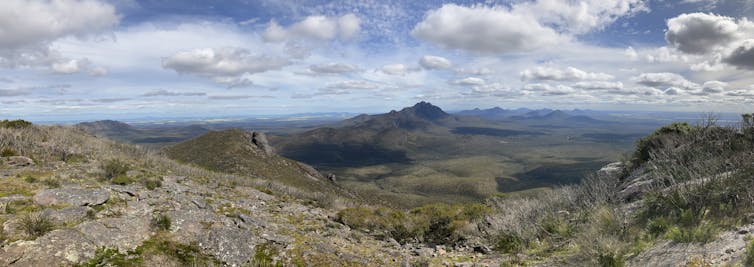
Just as some animals receive less research and conservation attention than others because they aren’t as charismatic, there is also a similar charisma deficit for some types of plants. Many groups of Australian shrubs or trees with spectacular floral displays have comprehensive, or even complete, photographic records. For example, all 176 of Australia’s Banksia species have been photographed.

Conversely, small herbs, plants with tiny or dull flowers, or groups such as grasses or sedges tend to miss out on being photographed – some of them for a very long time indeed. Schoenus lanatus, for example, is a small sedge that grows across a vast stretch of coastal WA, from Perth all the way to the South Australian border. It was described in 1805 yet, more than two centuries later, it is still unphotographed in the field!
Although botanists and taxonomists take many photographs of plants, citizen scientists also have a crucial role to play in the documentation of our native flora, with organisations such as Desert Discovery at the forefront. During last year’s expedition to Yeo Lake Nature Reserve at the remote western edge of the Great Victoria Desert, the Desert Discovery team photographed hundreds of native plants, including five species on our unphotographed list.
One example is the daisy bush Olearia eremaea, which is only found in WA’s arid interior. First described in 1990 and illustrated with black-and-white line drawings, it was not until more than 30 years later that this species was first photographed, at Yeo Lake, a remote nature reserve roughly 200km northeast of Laverton.
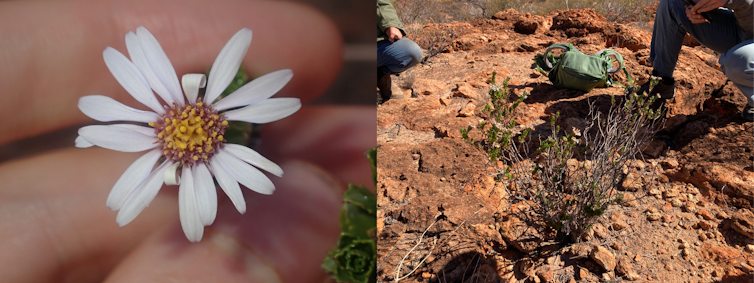
Of course, some of the species on our unphotographed list have in fact been photographed, but the images are not available in any of the 33 major databases we surveyed. These photographs may be slides in someone’s desk drawer or hard drive somewhere, appear in possibly out-of-print field guides and books, be behind paywalls in the scientific literature, or are not currently identified due to a lack of other comparison photos. This lack of discoverability is a problem, because these photos are very unlikely to be found by someone in the field trying to identify the species.
We have produced a searchable list of Australian native plants lacking photographs. We hope this work stimulates both professional and citizen scientists to track down these species and add photographs to public, discoverable repositories such as iNaturalist.
But be warned: these aren’t easy treasure hunts. These species are a mix of very remote and often overlooked species – they are typically not famous or eyecatching. Finding them will take determination, botanical know-how, and a sturdy off-road vehicle.
But the pay-off would be well worth it – successful pictures would make their way into identification guides, allowing both citizen and professional scientists to identify, monitor and conserve these species into the future.![]()
Thomas Mesaglio, PhD candidate, UNSW Sydney; Hervé Sauquet, Senior Research Scientist, Royal Botanic Gardens Sydney and Adjunct Associate Professor, UNSW Sydney, and Will Cornwell, Associate Professor in Ecology and Evolution, UNSW Sydney
This article is republished from The Conversation under a Creative Commons license. Read the original article.
Cultural burning is safer for koalas and better for people too
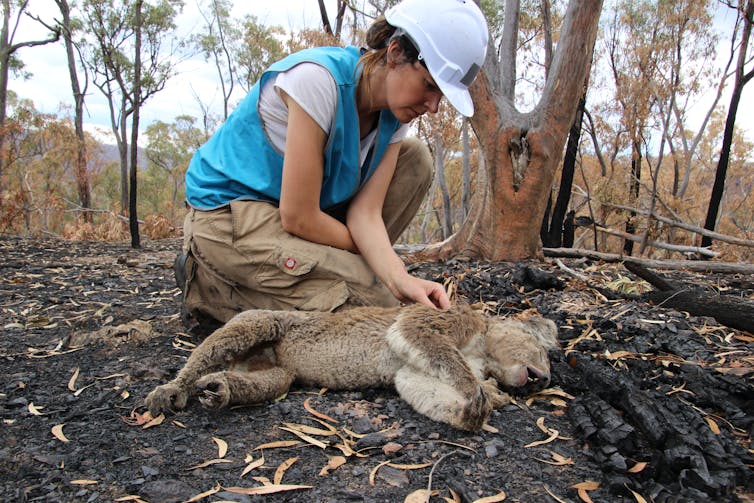
Koalas are an iconic endangered species living in a fire-prone environment. This makes them an ideal subject when investigating solutions to wildfires.
We explored how koalas fared before and after cultural burns on Minjerribah island (also known as North Stradbroke Island), near Brisbane on Quandamooka Country.
We used heat-seeking drones to assess population density and collected koala droppings to check hormone levels. We found cultural burns had no detectable effect on these parameters.
The project also found the benefits of cultural burns extended far beyond landscape management. We hope this research further highlights the practice of cultural burning as a strategy to help us manage the risk of wildfire in a warming world.
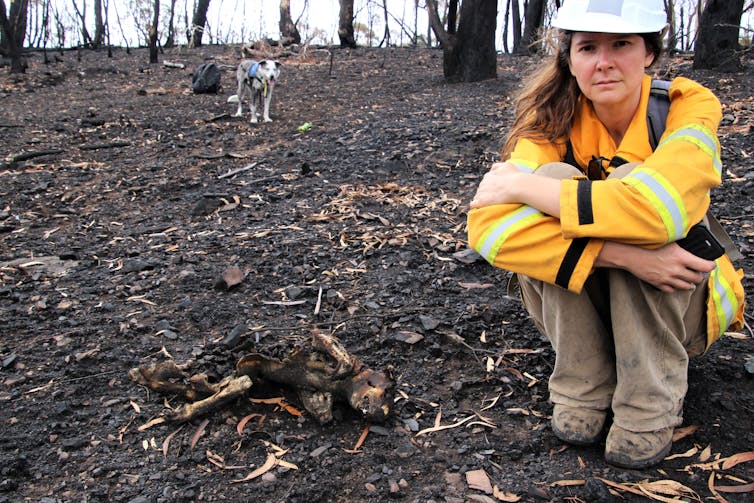
Menacing Megafires
The Australian Black Summer bushfires shocked the world. But nothing brought home the terrifying ferocity of the megafires - and our vulnerability to them - more than scenes of dead, dying or distressed koalas in an apocalyptic landscape.
Unfortunately, there’s overwhelming evidence that megafires are part of the new normal. Climate change will continue to create the exceptionally dry fuel loads and dangerous fire weather that lead to catastrophic events. So we need to find ways to minimise the damage.
Ancestral practices of cultural burning hold great promise all over the world. The California Fire Science Consortium says fire fuel control, such as that derived from cultural burning, can limit the severity of future wildfires.
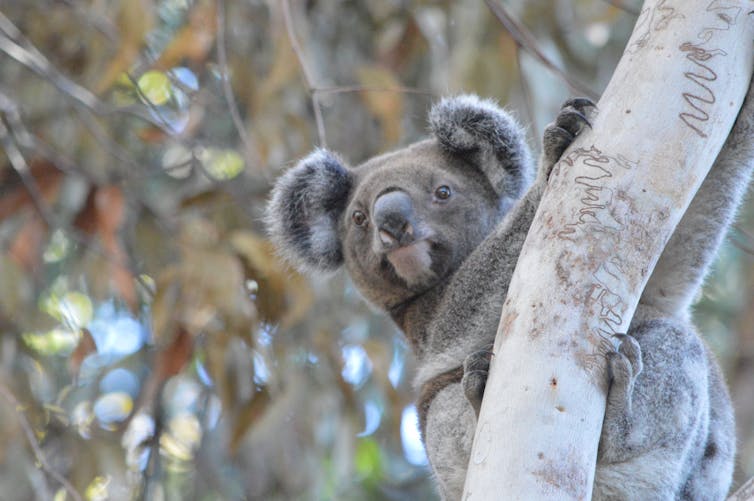
Minjerribah is a haven for wildlife. Half of the land is already national park and there are plans to increase the protected area.
Cultural burns have been a significant part of Minjerribah’s history. However, in recent times, large and intense fires have swept across the island, causing considerable damage to property, ecosystems and cultural resources. A megafire on Minjerribah in January 2014 burned more than 70% of the island - the largest fire in memory there.
Living On The Edge
There is scant research on wildfires and koalas. That’s largely because wildfires are dangerous and unpredictable, making them difficult to study. And when monitored koalas happen to be in the path of a wildfire, researchers tend to try to save them.
Koalas are particularly vulnerable, suffering long after the fire has passed. They have limited energy reserves and require continuous access to food.
That’s a problem when trees lose their edible leaves. These trees typically require months to produce enough new foliage. After a fire, koalas are also vulnerable to overheating, because they rely on shade and cooling from healthy trees with thick canopies to regulate their body temperature.
The koalas on Minjerribah are virtually disease-free, making this a rare and precious population in southeast Queensland. Wildfires pose the greatest threat to their survival, according to the Quandamooka Native Title rights administrators, Quandamooka Yoolooburrabee Aboriginal Corporation (QYAC). It is hoped restoring cultural fire practices will reduce the occurrence of large bushfires.
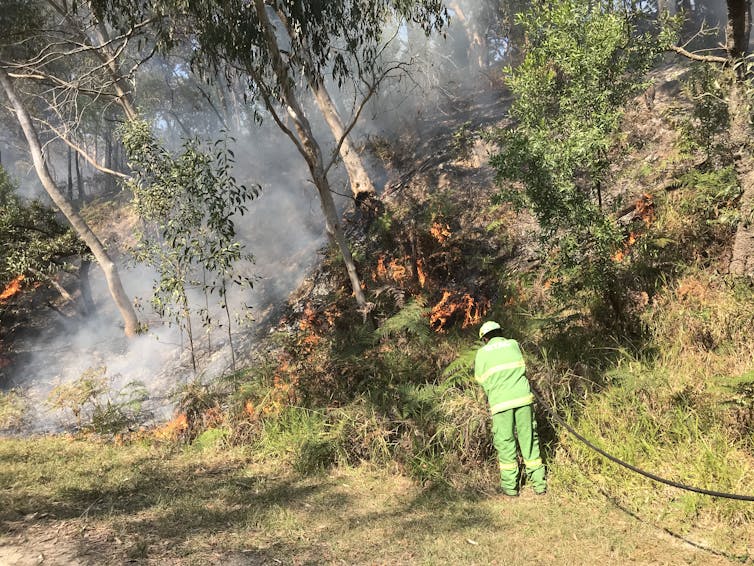
Cultural Burning On Quandamooka Country
If cultural burning was a person, one might describe her as patient, slow-moving, calm and quiet. A cultural burn will snake slowly through a site, missing some patches. This creates a burn mosaic.
The fire is not too hot and does not burn high into the tree canopy.
Use of fire in the landscape varied across Australia, between different First Nations groups. Uses for fire can include: fuel and hazard reduction, regeneration of habitat, generation of and management of particular sources of food, fibre and medicines, facilitation of access and movement, protection of cultural and natural assets, or healing Country’s spirit.
Quandamooka people have the oldest published archaeological occupation site on the east coast of Australia. Their use of fire is a deliberate and integral part of caring for Country. That includes burning and prevention of burning.
As leaders and practitioners of cultural burns on Minjerribah, the Quandamooka people wanted to establish standard practices for wildlife management during burning – specifically, whether thermal imaging drones could establish where koalas and other animals are present in areas to be burnt. This could inform actions to reduce risk.
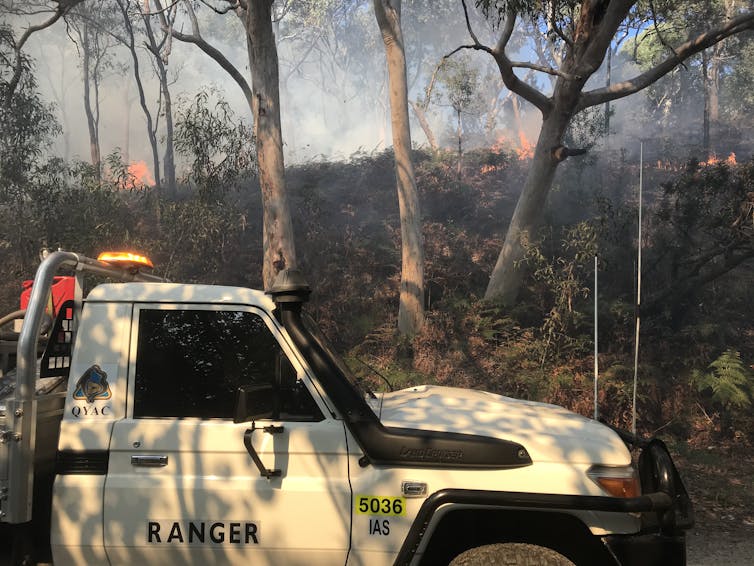
Studying Koalas And Cultural Burning
Koalas are difficult to study, as they are exceptionally good at hiding. That has prompted researchers to find more innovative survey methods.
We used heat-seeking drones to establish koala density, and koala droppings to study their hormone levels. We established a baseline of both measures through repeat surveys prior to the burns.
We also compared sites with and without cultural burns, accounting for seasonal variations that are not due to the burns. We found cultural burns had no detectable impact on either koala density, or hormone levels.
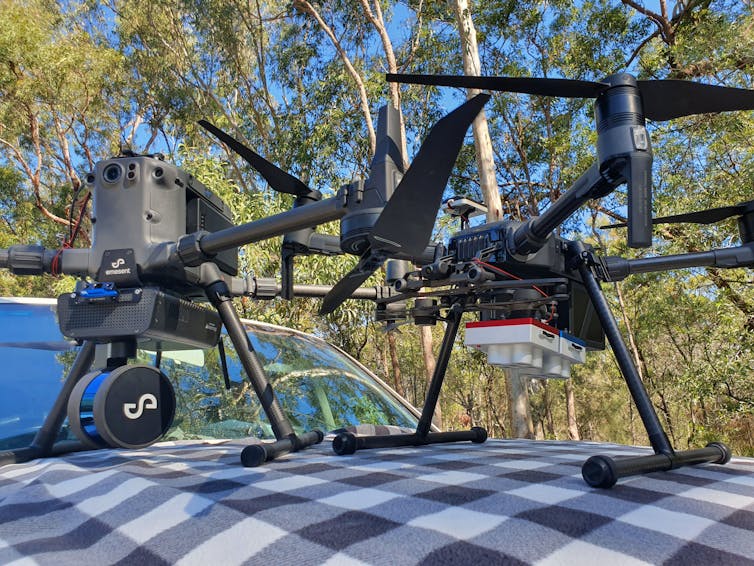
Multiple Benefits Of More Feet On Country
A perfect cultural burn is lit the right way, at the right place and time of year. Some years, only some places can be burnt, based on the fire interval and soil moisture levels. This requires local knowledge and constant observation all year round, not just during a single pre-burn site visit.
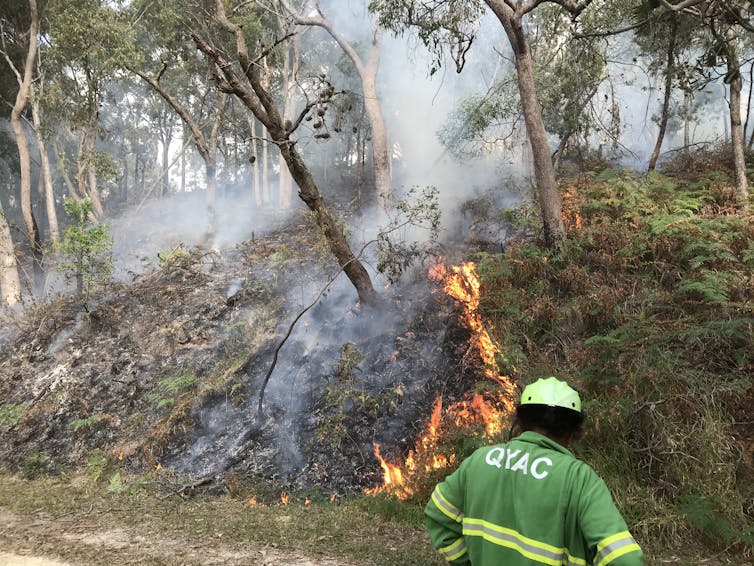
Having people on Country throughout the year also improves social connections between generations, and protects stories and sacred sites on Country. Other benefits include:
- employment
- reducing the risk of megafires
- supporting low-carbon economies
- improving biodiversity
- increasing water protection
- improving forest resilience and adaptation to climate change
- reducing air pollution
- fostering reconciliation.
Of course, this needs to be financially supported and done right – following the guiding principles of Responsibility, Respect and Recognition. It’s crucial that First Nations people of the specific land are involved. The process should also be embedded within contemporary natural resource management and supported by government agencies.
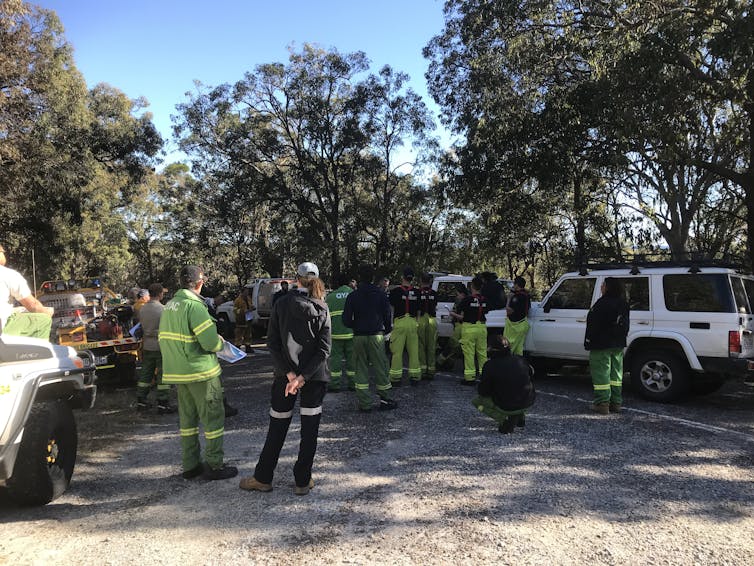
Teamwork Vital To Success
As the world warms, we must become increasingly resilient and work together to find solutions. We can draw on past successes as we shape new and better ways of managing landscapes.
Compassion will play an important role, including the need to listen and respect all contributions even as the world around us is increasingly stressful, so we can create a better future for all.![]()
Romane H. Cristescu, Researcher in Koala, Detection Dogs, Conservation Genetics and Ecology, University of the Sunshine Coast; Darren Burns, Community Land & Sea manager at Quandamooka Yoolooburrabee Aboriginal Corporation, Indigenous Knowledge, and Kye McDonald, PhD Candidate, University of the Sunshine Coast
This article is republished from The Conversation under a Creative Commons license. Read the original article.
A tonne of fossil carbon isn’t the same as a tonne of new trees: why offsets can’t save us
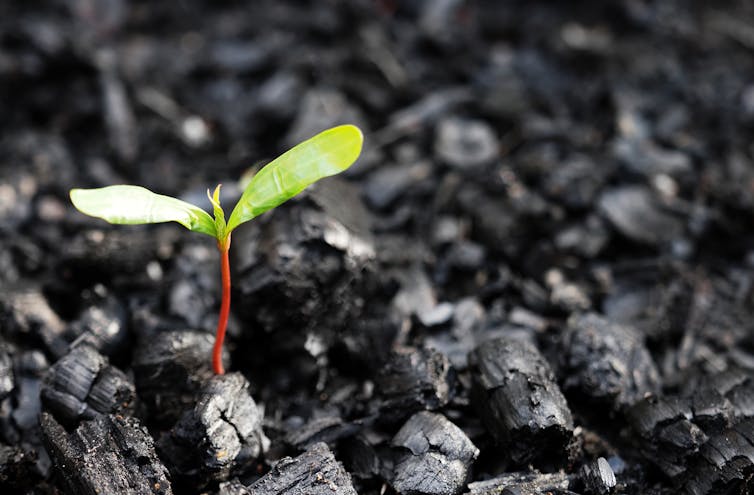
This week, the Albanese government is attempting to reform the safeguard mechanism to try to make it actually cut emissions from our highest polluting industrial facilities.
Experts and commentators see Labor’s plan as a cautious, incremental change that doesn’t yet rise to the urgency of the intensifying climate crisis. But it could generate momentum after a wasted decade of climate denial and delay under the previous government. Done right, it could set our biggest industrial polluters on a pathway to cut their emissions and be a springboard for more ambitious changes.
But there’s one glaring problem. Under the government’s proposed rules, there is still no requirement for polluters to actually cut their emissions at the sites where they are released into the atmosphere. Instead, companies can choose to buy carbon credits or offsets to meet their obligations. Incredibly, there would be no limit on the number of offsets companies can use.
You’ve probably heard about Australia’s rubbery offset schemes and questions of integrity. But there’s an even more fundamental problem. One tonne of carbon dioxide pumped into the atmosphere by burning fossil fuels is not the same as one tonne of carbon stored in the tree trunks of a newly planted forest.
The carbon in coal, gas and oil has been safely stored underground for extraordinary lengths of time. But when trees take carbon dioxide back out of the atmosphere, they may only store it for a short period.
There is simply no way around it. Avoiding the worst of climate change means stopping the extraction and burning of fossil fuels. Offsets will not save us. In fact, unlimited use of offsets could see even more emissions, if coal and gas companies “offset” emissions and ramp up exports.

Why Can’t We Rely On Nature To Pull Carbon Dioxide From The Air?
In 2023, many policymakers still believe we can adequately offset emissions. It would certainly be easier if we could keep burning fossil fuels and offsetting them by planting forests. But it doesn’t work. It’s simply not possible to fully “offset” billions of tonnes of greenhouse gas emissions from burning of coal, oil and gas by regrowing forests, increasing the amount of carbon in soils or other measures.
That’s because the carbon dioxide released by burning fossil fuels is fundamentally different to the way carbon is stored above ground in trees, wetlands and in the soil.
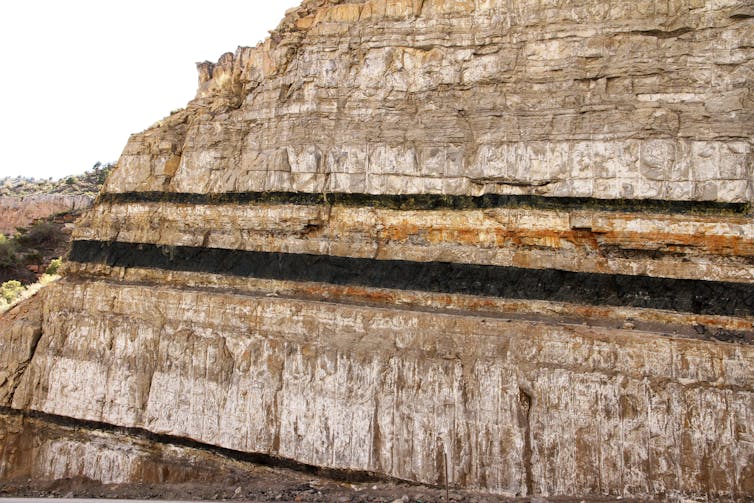
Carbon is everywhere on Earth — in the atmosphere, the ocean, in soils, in all living things, and in rocks and sediments. It is constantly being cycled through these different parts. Carbon is also being continually exchanged between the atmosphere and the ocean’s surface. Together these processes make up the earth’s “active” carbon cycle.
When we burn fossil fuels, we release carbon locked away for millions of years (hence “fossil” fuels), pumping vast new volumes of carbon into the active carbon cycle. This is very clearly altering the balance of carbon in the Earth system and faster than ever recorded in the Earth’s geological history. Planting trees does not lock carbon away again deep underground. Instead, the introduced fossil carbon remains part of the active carbon cycle.
To compound the problem, much of the carbon stored in land-based offsets does not stay stored. Forests can easily be destroyed by fire, disease, floods and droughts, all of which are increasing with climate change.
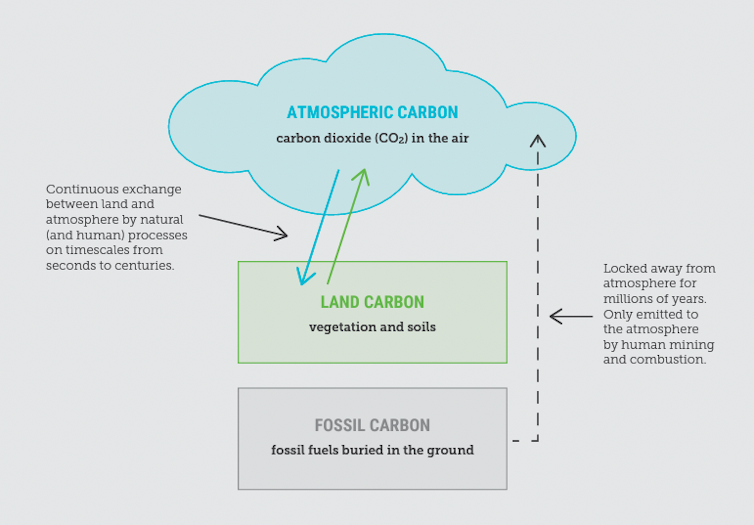
Offsets Are A Last Resort – Nothing More
Despite these issues, offsets will still have a small role. Some emissions cannot be avoided or reduced at present, given low-emissions technologies for industries like steelmaking are still scaling up. But these offsets must be strictly limited and set to progressively decline over time, as opportunities for genuine emissions reductions – at the source – are developed and rapidly scaled.
Unfortunately, paying for offsets is the first and only thing many large companies are doing about their harmful emissions.
If we allow fossil fuel companies to offset their emissions without limit, they will keep along a business as usual track or even expand their operations. That, in turn, will mean significantly more emissions when Australian fossil fuels are burned overseas.
Our Leaders Must Avoid The Offset Trap
It’s taken Australia decades too long, but we’re finally past climate denial, perhaps due to unprecedented fire and floods. Our leaders tell us it’s now about finding solutions. Well, offsets are not a solution. There is no substitute to actually ending the routine burning of fossil fuels.
We all want our comfortable lives to continue with a minimum of change. Offsets seem to deliver that. But all they really do is offset our guilt and responsibility. They cannot solve the central problem which is that every year, we add another 33 billion tonnes of carbon dioxide to the atmosphere by burning fossil fuels.
The atmosphere doesn’t respond to good intentions or clever schemes. All it responds to is the volume of greenhouse gases which trap ever more heat.
If Labor is to make the safeguard mechanism fit for purpose, it must focus on genuine emissions reductions at the source.
What Australia does matters a great deal to the world’s efforts to tackle the climate crisis. If Australia became the first major fossil fuel exporter to embrace a future as a clean energy superpower, it will demonstrate it is possible – and that it comes with benefits like new industries, cleaner air and energy security.
First, though, we have to give up on offset pipe dreams. The only thing that matters is cutting emissions. ![]()
Wesley Morgan, Research Fellow, Griffith Asia Institute, Griffith University
This article is republished from The Conversation under a Creative Commons license. Read the original article.
Orange-bellied parrot shows there’s more to saving endangered species than captive breeding
Dejan Stojanovic, Australian National University; Carolyn Hogg, University of Sydney, and Rob Heinsohn, Australian National UniversityCaptive breeding of threatened species for release into the wild is an important conservation tool. But where threats to wild populations remain unresolved, this tool may not guarantee population recovery in the long term.
Our new research on one of the most endangered birds in the world shows we need to tackle underlying threats to survival if we are to save species from extinction in the wild.
Captive breeding and release is sustaining the population of orange-bellied parrots, holding extinction at bay. But most of the young born into the population each year die during their migration and winter.
Our modelling shows that if captive breeding and release stopped tomorrow, orange-bellied parrots would soon become extinct. The natural birth rate is too low to compensate for the high death rates of juveniles. So we’re locked into releasing captive-bred parrots until we can solve the underlying problems afflicting the wild population. Unfortunately, it’s not clear exactly what those problems are.
No Guarantees When Threats Remain
Globally, captive breeding has prevented the extinction of iconic species such as the California condor.
However, despite the benefits of captive breeding, success is not guaranteed. This is especially so when captive-bred animals are released into habitats where threats remain unresolved. In such cases, captive-bred animals will succumb to the same threats as their wild counterparts.
For some species, identifying and correcting threats is straightforward. For example, removing introduced predators from islands may be a way to eliminate a threat and optimise the benefit of releases from captivity.
But the exact nature of threats is often not clear-cut, especially for species that move over large areas. This can create uncertainty about what the threats are, where they occur, and how to resolve them.
Inability to mitigate threats may result in lost opportunities for released animals to learn crucial behaviours such as migration or song, and ultimately, the decline of wild populations.
Conservationists may sometimes need to “buy time” and prevent extinction in the wild by releasing animals to ensure the continuity of animal cultures in landscapes where threats persist.
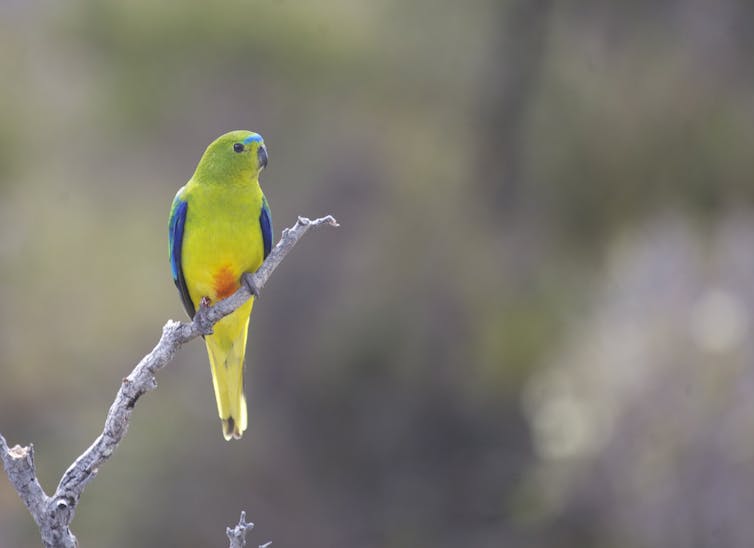
Locked Into A Cycle Of Dependency
The orange-bellied parrot is one of the most endangered birds in the world. In 2016, just four females returned to Tasmania from migration, and only one of them produced a surviving descendant. (The species migrates from its summer breeding ground in southwestern Tasmania to the coasts of southeastern mainland Australia, but these movements take a toll on the population.)
Fortunately, despite ongoing uncertainty about reducing threats, intensive conservation efforts have grown the population. More than 30 females have returned from migration annually over the past two years. Despite this success, most juvenile parrots (both captive-bred and wild-born) that leave Tasmania on their northward migration die.
Overcoming the unresolved threats that drive this high mortality is crucial for making this population self-sustaining. Unfortunately due to the practical limitations of studying a small, scattered population across remote areas, it is unlikely that this knowledge gap can be addressed in the short term. In the meantime, there are several options available.
We used simulations to compare the benefits of different management scenarios on the orange-bellied parrot. We showed that of all the potential intervention options available to the recovery project, releasing captive juveniles in autumn – to learn from wild adults, and increase the size of migrating flocks – was the most beneficial.
However, none of the interventions available to managers can directly address the underlying problem of high juvenile mortality, so their benefits were temporary. When we simulated stopping captive releases, the populations rapidly went extinct. Without addressing the underlying threats faced by the species, we found the natural birth rate too low to compensate for high juvenile mortality rates.
Until a solution is found for high migration and winter mortality rates, orange-bellied parrots will remain dependent on captive breeding and release to prevent extinction and grow the population.
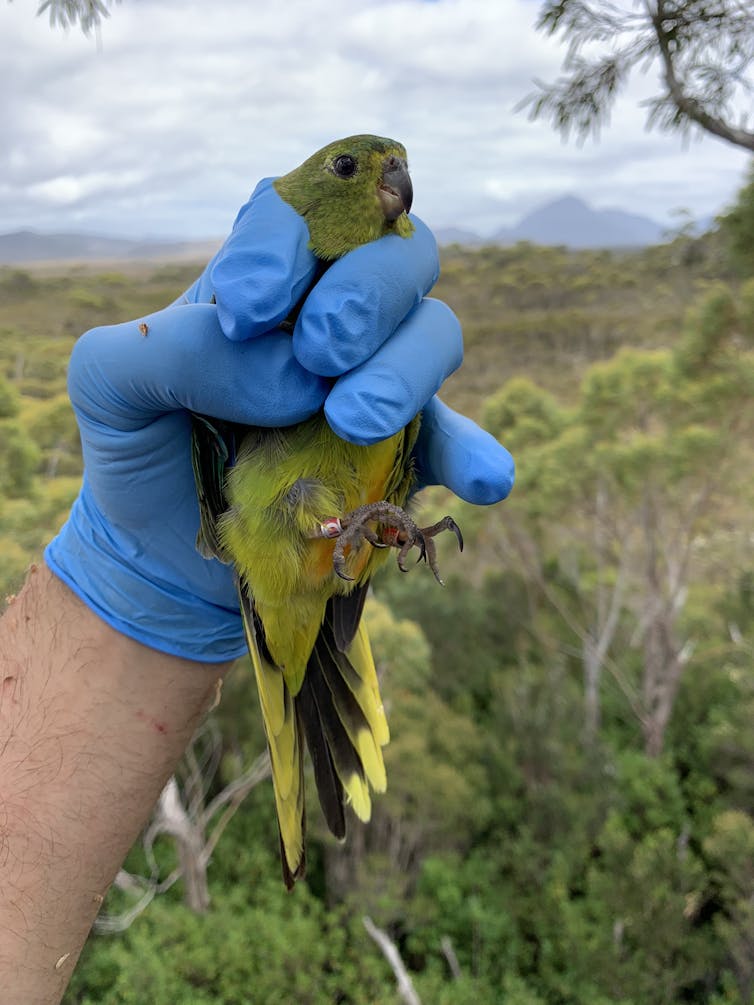
Lulled Into A False Sense Of Security
Orange-bellied parrots provide a stark reminder that there is no “quick fix” for most threatened species. Although captive breeding for release can effectively prevent extinction in the short term, long-term self-sustaining populations in the wild depend on finding solutions for the threats that caused their decline in the first place. Until solutions can be found, management agencies may be locked into a cycle of conservation dependency aimed at preventing extinction, but struggle to address the threats that cause the underlying problems.
Given the global popularity and visibility of captive breeding programs, it is easy to be lulled into a false sense of security that they are a quick fix for the extinction crisis. However, identifying the threats to wild populations early is crucial because re-establishing “extinct in the wild” species from captivity is extremely difficult, albeit not impossible.
In the case of the orange-bellied parrot, we hope preventing extinction of the wild population through releases of captive-bred birds may buy enough time to identify and mitigate the causes of high juvenile migration/winter mortality. But we also hope our study is a reminder to policymakers that conservation of wild populations should focus on identifying and preventing threats, negating the need for captive breeding in the first place. ![]()
Dejan Stojanovic, Postdoctoral Fellow, Australian National University; Carolyn Hogg, Senior Research Manager, University of Sydney, and Rob Heinsohn, Professor of Evolutionary and Conservation Biology, Australian National University
This article is republished from The Conversation under a Creative Commons license. Read the original article.
What can we expect from the final UN climate report? And what is the IPCC anyway?
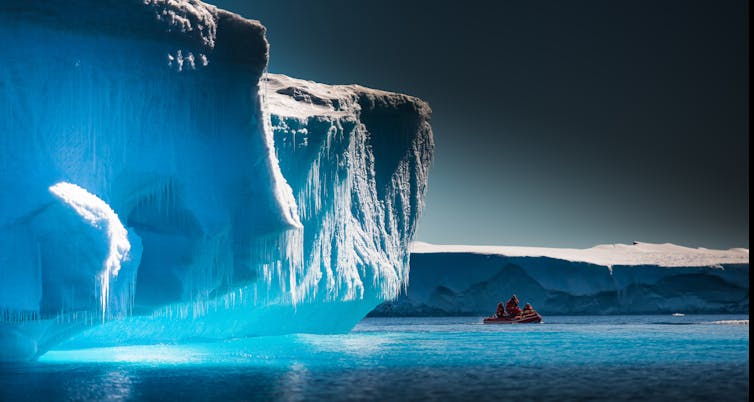
After all the talk on the need for climate action, it’s time for a reality check. On Monday the world will receive the latest United Nations climate report. And it’s a big one.
Hundreds of scientists, forming what’s known as the Intergovernmental Panel on Climate Change (IPCC), have been working hard behind the scenes. They’ve produced a series of reports in the latest round, which began in 2015. But on Monday it all comes together in what’s called the Synthesis Report.
It will explain how greenhouse gas emissions are warming the planet, then delve into the consequences. There’s a focus on where we are most vulnerable, as well as efforts to adapt. And then, how we’re acting to reduce emissions and mitigate climate change.
Gathering all the evidence, from every corner of the globe, is an enormous undertaking, let alone reviewing the science to achieve consensus. It’s a process that has been repeated several times since it began, more than three decades ago.
This is the sixth round of reports. And it won’t be the last. But this is a crucial moment, because the chance to limit warming and avert dangerous climate change is slipping away.
What Is The IPCC And Why Do We Need It?
The IPCC is comprised of 195 member countries charged with producing comprehensive and objective assessments of the scientific evidence for climate change.
The World Economic Forum ranks climate action failure as the number-one risk on a global scale over the next decade. And several other top-ten global risks – extreme weather, biodiversity loss, human environment damage and natural resource crises – are made worse by climate change.
Governments, industries and communities are becoming increasingly aware of the need to tackle climate change, especially as predictions become reality.
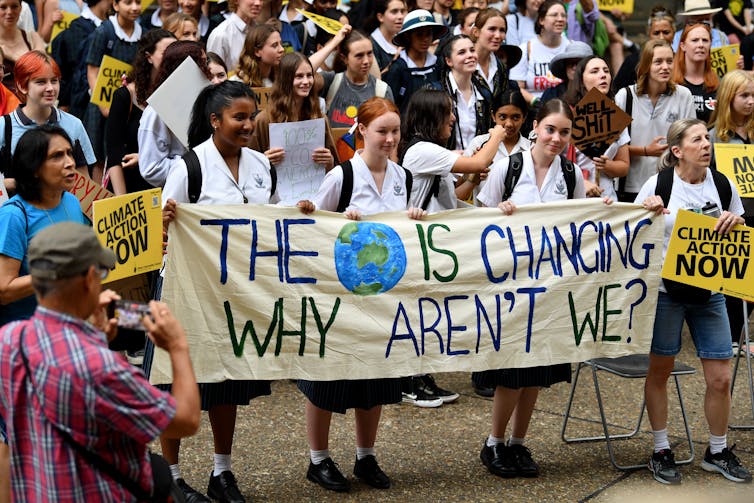
The scientific effort to understand the causes, effects and solutions is vast and growing. Every year tens of thousands of new peer-reviewed scientific studies on climate change are published. There has to be a way to identify key messages across this enormous body of scientific evidence, and use this information to make better decisions. This is what IPCC reports do.
The IPCC process also provides a framework for the scientific community to organise and coordinate their efforts. Each reporting cycle is matched with an international scientific effort, where standardised experiments are run to test the reliability of current climate models.
The experiments include multiple possible scenarios for how atmospheric greenhouse gas concentrations could change in the future, depending on choices made today. The range of results produced by different models across these sets of experiments helps to determine how confident we are in the climate change impacts expected in the future.
A key aspect of IPCC reports is that they are co-produced between scientists and governments. The summary of each report is negotiated and approved line by line, with consensus from all of the IPCC member governments. This process ensures the reports remain true to the underlying scientific evidence, but also pull out the key information governments need.
What Can We Expect From Monday’s Report?
The Synthesis Report will draw on all six reports released in the current cycle.
They include three so-called “working group reports” on:
the physical science basis of climate change
impacts, adaptation and vulnerability
mitigation.
In addition, three special reports cut across these working groups and tackled focused topics, where governments requested rapid assessments to aid in their decision making. They covered:
global warming of 1.5℃
climate change and land
the ocean and cryosphere in a changing climate.
The headline statements from this cycle of IPCC reports have been clearer than ever. They leave absolutely no room for disputing human-caused warming and the need for urgent reductions in greenhouse gas emissions, this decade. We can expect similarly strong and clear headlines from Monday’s report.
How Have IPCC Reports Changed?
Looking back over IPCC reports from the past 33 years demonstrates how our understanding of climate change has improved. The first report in 1990 stated: “the unequivocal detection of the enhanced greenhouse effect from observations is not likely for more than a decade”. Fast forward to 2021 and the equivalent assessment now states: “It is unequivocal that human influence has warmed the atmosphere, ocean and land”.
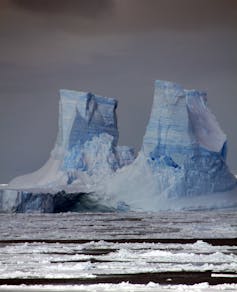
In some cases, the pace of change has dramatically exceeded expectations. In 1990 West Antarctica was a region of concern but not expected to lose major amounts of ice in the next century. But by 2019 our observations show glaciers in West Antarctica retreating rapidly. This has contributed to an accelerating rise in global sea level.
There are also emerging concerns for the stability of parts of the East Antarctic ice sheet once thought to be protected from human-caused climate warming.
This demonstrates the tendency for IPCC assessments to understate the scientific evidence. Climate science is often accused of being alarmist – particularly by those trying to delay climate change action – but in fact the opposite is true.
The production of IPCC reports by consensus with governments means that statements that appear in the report summaries are justified by multiple lines of scientific evidence. This can lag behind current climate science discoveries.
What’s Next?
Plans are already underway for the next assessment cycle of the IPCC, which is to begin in July this year. It’s hoped the next round of reports will be produced in time to inform the Global Stocktake in 2028, where progress towards the Paris Agreement will be assessed.
The current (sixth assessment) cycle has been gruelling. Scientists have stepped up their commitment to work with governments to provide the clear and robust information required.
Writing and approving reports amid a global pandemic added to the challenges. So too did the inclusion of three special reports in addition to the usual three working group reports.
The evidence for human-caused climate change is now unequivocal. This has prompted calls for future IPCC reports to more efficiently assess rapidly changing areas of science and cut across the working groups. This would bring together assessments of the causes, impacts and solutions for key aspects of climate change in one report, rather than always separating them into individual working group reports.
The establishment of the IPCC signalled climate change was an important global problem. Despite this recognition more than three decades ago, and the increasingly concerning reports produced by the IPCC in this time, global greenhouse gas emissions have continued to rise year-on-year.
However, there is some hope we may be nearing the peak in global emissions. By the time the next IPCC reports are released, global climate action may have finally started to move the world onto a more sustainable pathway.
Time will tell. Let’s hope policy makers will stand with the science on the right side of history. ![]()
Nerilie Abram, Chief Investigator for the ARC Centre of Excellence for Climate Extremes; Deputy Director for the Australian Centre for Excellence in Antarctic Science, Australian National University
This article is republished from The Conversation under a Creative Commons license. Read the original article.
The flap of a butterfly’s wings: why autumn is not a good time to predict if El Niño is coming

Remember the butterfly effect? It was a popular summary of chaos theory suggesting a butterfly flapping its wings in the Amazon could cause a tornado in Texas.
Right now, a version of this is making it hard for us to predict whether an El Niño event is coming.
After three consecutive La Niña years, that part of the cycle is officially over. But it’s not certain an El Niño will replace it. Australia’s Bureau of Meteorology this week announced an El Niño watch – a “wait and see” forecast giving us a 50% chance of an El Niño forming later this year. Other climate forecasting agencies around the world are sending a similar message to the Bureau of Meteorology’s, that we are on an El Niño watch.
While the conditions seem right for El Niño to form and likely bring hotter, drier weather to Australia, the world’s chaotic climate system is in a very unpredictable state. Fast forward three months, and our models will be much more certain about whether El Niño really is coming – or whether the system will remain in a neutral, or near-normal, state.
Why Can’t We Predict What’s Going To Happen?
At this time of year, the El Niño-Southern Oscillation (ENSO) cycle is at its most susceptible to change. Right now, the subsurface waters of the equatorial western Pacific are warmer than usual. If this water rises from deeper down to the surface of the ocean, it will interact with the atmosphere. This usually leads to more rain and floods for Chile, drier, hotter weather for Australia, and a variety of other effects worldwide.
But this isn’t inevitable. Let’s say a sudden burst of wind strikes, forcing warmer water to stay down deeper. This can disturb the whole cycle. Unexpected windbursts at this time of year can even tip the system into a different mode, ending up neutral or as a La Niña event.
Among climate scientists, this is known as the predictability barrier – and it’s why we can’t say for certain an El Niño is coming until later in the year.
Have We Seen Unexpected Swings In The Cycle Before?
Yes, most recently in 2014. Early that year, climate models were predicting a truly enormous El Niño was set to begin.
But the monster El Niño didn’t happen. Cooler water flowed into the south-eastern Pacific at a critical time of year, while the unusual timing of westerly windbursts kept the warmer water down deeper.
The end result was that the whole system was nudged into a different configuration of a weak El Niño. It took another year for a full El Niño to develop. This time, it was very strong.
Could we really see a fourth La Niña? It could happen but it would be very unusual, given we’ve never seen four years of successive La Niña conditions. At present, the heat build-up under the surface of the equatorial Pacific suggests an El Niño is coming, but it’s not a given.
Why Do We Get These Cycles Anyway?
We believe the El Niño-La Niña cycle has a very long history, dating back to the formation of the Pacific Ocean about 190 million years ago.
That’s because this ocean basin is the largest on Earth – and has a lot of seawater sitting along the equator. In our models, we can see the El Niño cycle forming out of the fluid dynamics, as warmer or cooler water moves across the ocean.
The Atlantic has a smaller version, named the Atlantic Niño. Why is it smaller? Because there’s much less water along the equator in the Atlantic. As a result, the Atlantic Niño has much less of an effect on weather globally.

So When Will We Know For Sure?
El Niño and La Niña are at their strongest over December and January, though the effects and their timing can differ in Australia depending on where in the country you are. These cycles usually end some time between February and May.
The popular understanding of the butterfly effect and chaos science often gets one thing wrong. Chaotic systems like the world’s weather are not always unpredictable, but can be more or less sensitive to small changes at different times. Between March and May, it can take just a small nudge to flip the system. Later in the year, as either an El Niño, neutral phase or La Niña gathers pace, it is much harder to change course.
It’s like a ball poised on top of a high hill. A very tiny push is enough to send the ball rolling down either one side of the hill or another. The push might even be so tiny you can’t measure it accurately.
That’s why it’s so difficult to predict what’s going to happen, even though we understand the physics behind these events fairly well. The Pacific Ocean and the air overhead are extremely sensitive to “pushes” in any direction from March to May.
But once the ball rolls down one side rather than another, it’s much easier to predict which way it will keep rolling. By June or July, the ball is already rolling down the hill on whichever side it’s going to go, and there’s a lot more confidence and clarity in our predictions. Stay tuned. ![]()
Nandini Ramesh, Senior Research Scientist, Data61, CSIRO
This article is republished from The Conversation under a Creative Commons license. Read the original article.
PFAS for dinner? Study of ‘forever chemicals’ build-up in cattle points to ways to reduce risks
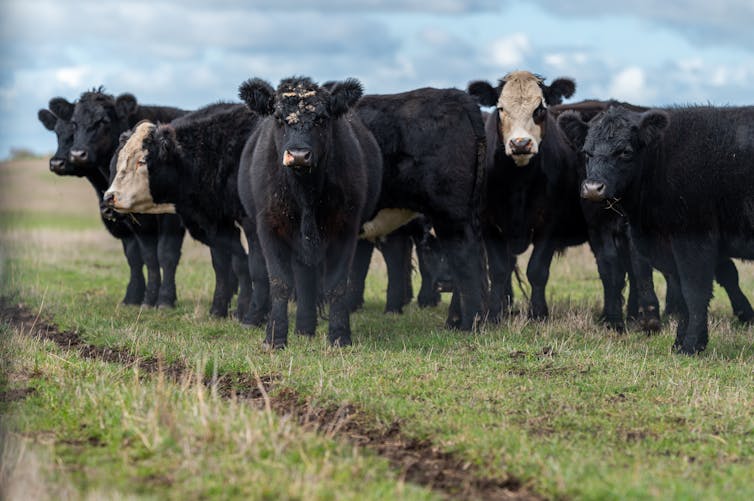
PFAS, known as “forever chemicals”, have been found just about everywhere on Earth, including in toilet paper.
These chemicals are a group of artificial compounds based on carbon and fluorine – per- and polyfluoroalkyl substances, or PFAS. They comprise thousands of individual chemicals with hundreds of documented uses, including water proofing and fire suppression. It is likely every household has products or textiles that contain or were treated with a product that contained PFAS (including some non-stick cookware and stain-resistant fabrics).
Studies have shown most people have one or more PFAS compounds in their blood. We live in a world full of chemicals, so why do we care about these ones? Well, some PFAS have been associated with a wide range of adverse human health effects, such as cancer and immune problems. However, there is limited evidence of human disease resulting from environmental exposures.
Our study investigated the uptake of PFAS into livestock at ten PFAS-impacted farms in Victoria. Our analysis also shows how risks can be reduced.
Our findings show the land and livestock can be managed to reduce PFAS levels in the animals before they enter the food chain. This means good management practices can protect food quality and reduce consumer exposure.
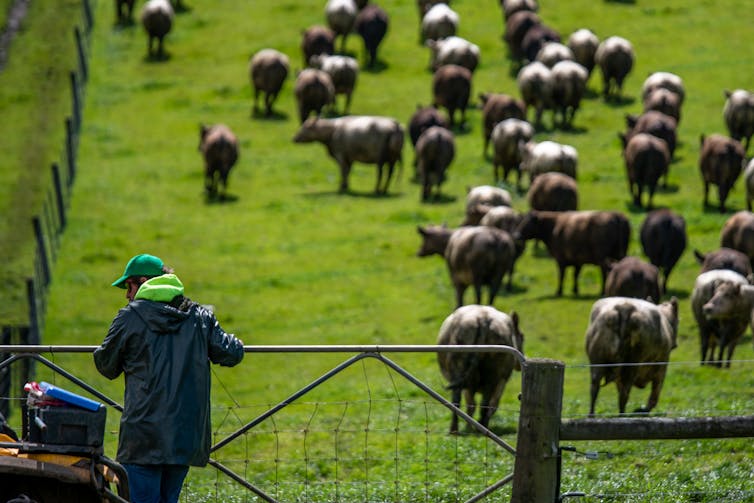
How Do PFAS Get In Your Blood?
Exposure to household dust and consumption of contaminated food or water are major contributors to human exposure to PFAS. It then accumulates in our blood.
As the name would suggest, forever chemicals persist in the environment. As a result, when released into the environment, they disperse and over time can contaminate surrounding areas.
Firefighting and training activities have historically resulted in large releases of PFAS into the environment. This includes farming areas.
As livestock feed and drink from contaminated sources, this leads to PFAS accumulation in tissues. From there, PFAS can be transferred into the food chain, including products we eat such as meat and milk.
The causal links and what levels of PFAS exposure are harmful are still being investigated. The scientific community has yet to reach a consensus on how “bad” these compounds are, or conversely what the safe exposure levels are.
In the meantime, it is important to limit exposure through regulation. Australia has adopted environmental and health-based guideline values for three PFAS of concern: perfluorooctane sulfonate (PFOS), perfluorooctanoic acid (PFOA) and perfluorohexane sulfonate (PFHxS).
Australian food quality is high. In a 2021 study, scientists tested for 30 different PFAS in a broad range of Australian foods and beverages. Only one specific PFAS (PFOS) was detectable. It was found in just five out of 112 commonly consumed foods and beverages at levels below concern.
These findings would suggest PFAS contamination is not an issue at most farms in Australia. The risks are likely to be higher from food produced at PFAS-contaminated sites. At such locations, PFAS can affect a range of foods, including eggs, vegetables and livestock.
What Did The Study Investigate?
We collated data from environmental investigations at ten PFAS-impacted farms in Victoria. This included testing about 1,000 samples of soil, water, pasture and livestock blood for concentrations of 28 types of PFAS. Our analysis also included information about farm practices, including livestock rotation, access to clean pasture and water.
We found:
two specific PFAS compounds (PFOS and PFHxS) made up more than 98% of total PFAS detected in livestock blood
PFAS concentrations in water were correlated to concentrations in livestock blood, implying water was a critical exposure pathway, while the relationships between livestock and PFAS levels for soil and pasture were weaker
livestock exposure to PFAS varies over time and across paddocks. Seasonal patterns in PFAS blood concentrations were linked to seasonal grazing behaviours and the animals’ need for drinking water.
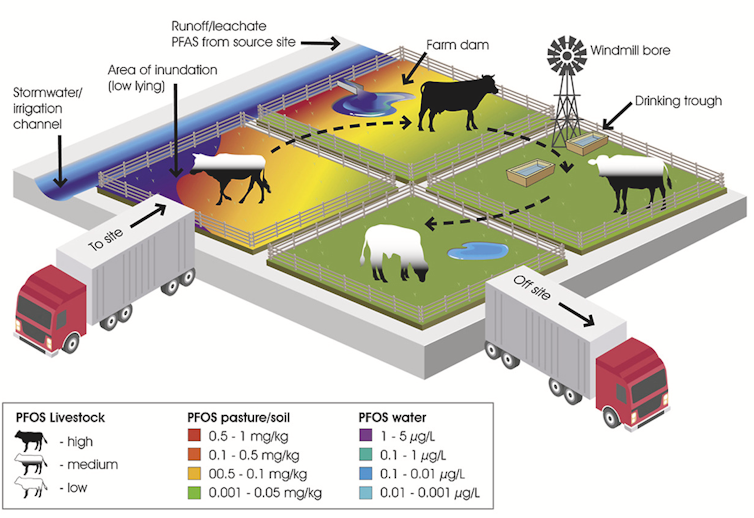
What’s The Next Step?
Environment Protection Authority Victoria (EPA) is leading research and policy to understand how environmental PFAS risks can be better managed. In this regard, EPA along with research partners, is working to develop predictive models to estimate PFAS accumulation in livestock over their lifetime. This research will help determine when a site is too contaminated for livestock production and which ones to prioritise for PFAS remediation in soil and water.
Ultimately, this will allow more effective management of PFAS accumulation and reduce the likelihood of having PFAS for dinner.![]()
Antti Mikkonen, Principal Health Risk Advisor – Chemicals, EPA Victoria, and PhD Candidate, School of Pharmacy and Medical Sciences, University of South Australia and Mark Patrick Taylor, Victoria's Chief Environmental Scientist, EPA Victoria; Honorary Professor, School of Natural Sciences, Macquarie University
This article is republished from The Conversation under a Creative Commons license. Read the original article.
Australia hasn’t figured out low-level nuclear waste storage yet – let alone high-level waste from submarines
Ian Lowe, Griffith UniversityWithin ten years, Australia could be in possession of three American-made Virginia-class nuclear submarines under the AUKUS agreement with the United States and United Kingdom. The following decade, we plan to build five next-generation nuclear submarines.
To date, criticism of the deal has largely focused on whether our unstable geopolitical environment and China’s military investment means it’s worth spending up to A$368 billion on eight submarines as a deterrent.
But nuclear submarines mean nuclear waste. And for decades, Australia has failed to find a suitable place for the long-term storage of our small quantities of low and intermediate level nuclear waste from medical isotopes and the Lucas Heights research reactor.
With this deal, we have committed ourselves to managing highly radioactive reactor waste when these submarines are decommissioned – and guarding it, given the fuel for these submarines is weapons-grade uranium.
Where will it be stored? The government says it will be on defence land, making the most likely site Woomera in South Australia.
What Nuclear Waste Will We Have To Deal With?
Under this deal, Australia will not manufacture nuclear reactors. The US and later the UK will give Australia “complete, welded power units” which do not require refuelling over the lifetime of the submarine.
In this, we’re following the US model, where each submarine is powered by a reactor with fuel built in. When nuclear subs are decommissioned, the reactor is pulled out as a complete unit and treated as waste.
An official fact sheet about this deal states Australia “has committed to managing all radioactive waste generated through its nuclear-powered submarine program, including spent nuclear fuel, in Australia”.
What does this waste look like? When Virginia-class submarines are decommissioned, you have to pull out the “small” reactor and dispose of it. Small, in this context, is relative. It’s small compared to nuclear power plants. But it weighs over 100 tonnes, and contains around 200 kilograms of highly enriched uranium, which is nuclear weapons-grade material.
So, when our first three subs are at the end of their lives – which, according to defence minister Richard Marles, will be in about 30 years time – we will have 600kg of so-called “spent fuel” and potentially tonnes of irradiated material from the reactor and its protective walls. Because the fuel is weapons-grade material, it will need military-scale security.
Australia Has No Long-Term Storage Facility
There’s one line in the fact sheet which stands out. The UK and US “will assist Australia in developing this capability, leveraging Australia’s decades of safely and securely managing radioactive waste domestically”.
This statement glosses over the tense history of our efforts to manage our much less dangerous radioactive waste.
For decades, the Australian government has been trying to find a single site for disposal of low-level radioactive waste. These are the lightly contaminated items produced in nuclear medicine and laboratory research. The low levels of ionising radiation these items produce means burying them under a few metres of soil is enough to reduce the radiation until it’s little more than the background radiation we all receive from the rocks under our feet, the buildings we live and work in and the technologies we use.
Even though these wastes are comparatively benign, every single proposal has run into strong local opposition. The most recent plans to locate a dump at Kimba, on South Australia’s Eyre Peninsula is still bogged down in the legal system due to opposition by local communities and First Nations groups
And we’re still dithering about what to do with the intermediate level waste produced by the OPAL research reactor at Lucas Heights in Sydney. At present, spent fuel is sent to France for reprocessing while nuclear waste is now being returned to Australia, where it is held in a temporary store near the reactor.
This waste needs to be permanently isolated from ecosystems and human society, given it will take tens of thousands of years for the radiation to decay to safe levels.
Our Allies Have Not Figured Out Long-Term Waste Storage Either
But while Sweden and Finland are building secure storage systems in stable rock layers 500 metres underground, neither the UK nor the US have moved beyond temporary storage.
UK efforts to manage waste from decommissioned nuclear submarines is still at the community consultation stage. At present, high-level waste from sub reactors is removed and taken to Sellafield, a long-established nuclear site near the border with Scotland. But each submarine still holds around one tonne of intermediate level waste, which, according to the UK government, has to be temporarily stored until a long-term underground storage facility is built some time after 2040.
In the US, spent fuel and intermediate waste from nuclear submarines is still in temporary storage. After the Obama administration scrapped the long-debated plan to store waste underneath Yucca Mountain in Nevada, no other option has emerged. As a result, nuclear waste from their military and civilian reactors is just piling up with no long-term solution in sight. Successive administrations have kicked the can down the road, assuring the public a permanent geological disposal site will be developed some time in the future.
This should be concerning. To manage the waste from our proposed nuclear submarines properly, we’ll have to develop systems and sites which do not currently exist in Australia.
In 2016, South Australia’s Royal Commission on nuclear fuel suggested Australia’s geological stability and large areas of unpopulated land would position us well to act as a permanent place to store the world’s nuclear waste.
This hasn’t come to pass in any form. An almost intractable problem is that any proposed site will be on the traditional land of a First Nations group. Every site suggested to date has been opposed by its Traditional Owners.
What if we send the high-level waste overseas for processing and bring it back as less dangerous intermediate waste? It’s possible, given it’s what we already do with waste from the OPAL reactor. But that still leaves us with the same problem: where do you permanently store this waste. That’s one we haven’t solved in the 70 years since Australia first entered the nuclear age with our original HIFAR reactor at Lucas Heights. ![]()
Ian Lowe, Emeritus Professor, School of Science, Griffith University
This article is republished from The Conversation under a Creative Commons license. Read the original article.
Killing dingoes is the only way to protect livestock, right? Nope
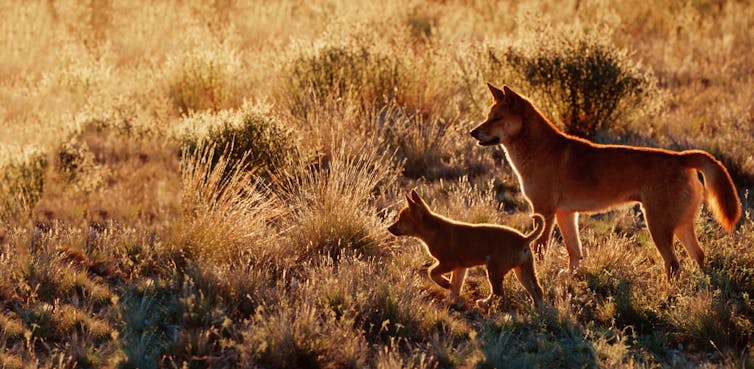
Since European colonisation, farmers have often viewed dingoes as the enemy, waging war against them to protect their livestock. Farmers felt they had no option but to eradicate dingoes using traps, shooting, poisoned baits (such as 1080) and building a 5,600km long dingo fence, the world’s longest.
Killing dingoes costs millions of dollars each year. But it hasn’t resolved the conflict. In many cases it has made the threat to livestock worse by breaking up dingo families and removing experienced adults which hunt larger, more mobile prey.
The alternative? As some farmers are discovering, there are unexpected benefits of learning to coexist with dingoes instead. As Western Australian cattle grazier David Pollock told us:
I reckon my dingoes are worth $20,000 each, probably more. So, killing them would be the last thing that I did.
Can Dingoes Really Help Graziers?
Yes. In many cases, they can be allies for graziers by reducing the competition for pasture from wild herbivores such as kangaroos and goats, as well as killing or scaring off foxes and feral cats.
As our understanding of the importance of predators has grown, a new approach has taken root: human-wildlife coexistence. Recently recognised by the United Nations Convention of Biological Diversity, this field offers a path to stem the global loss of biodiversity by balancing the costs and benefits of living alongside wildlife.
Our new research lays out seven pathways to shift from the routine killing of dingoes towards coexistence.
What Does Coexistence Look Like?
One path to coexistence is supporting graziers to adopt effective tools and strategies to reduce the loss of livestock while capitalising on the benefits of large predators. This is known as predator-smart farming
Our research on this area has led to a new Australian guide. This approach relies on a variety of effective non-lethal tools and practices to protect livestock three main ways:
humans or guardian animals such as dogs and donkeys watch over and defend livestock from dingoes, as well as using fencing to create a physical barrier
using knowledge about dingo biology and behaviour to find better deterrents, such as the use of lights, sounds or smells
stronger land management and livestock husbandry to increase the productive capacity of pastures and livestock resilience.
This approach helps ensure the livelihoods of farmers remain resilient and makes the most of the benefits of dingoes for productive agricultural landscapes and ecosystem health.
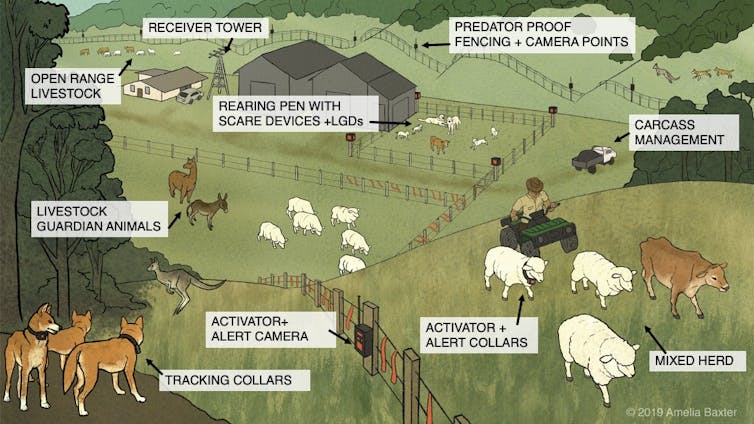
As one New South Wales cattle producer found, these approaches work. He told us:
Three years ago, we were losing 53% of our calves to dingoes. We started looking into alternatives that were cost and time effective and decided to try guardian donkeys. We purchased two jacks (male donkeys) and now we have 94% calving rate. Donkeys saved our business.
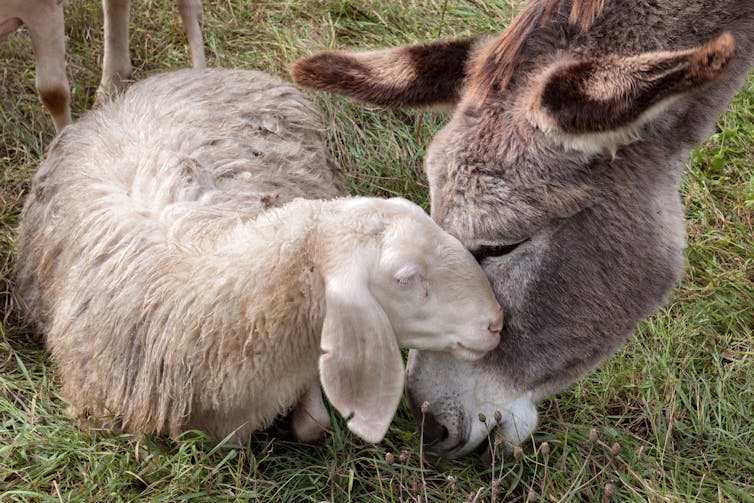
So What’s Stopping Us?
We now know it’s entirely possible to live and farm alongside dingoes. So why do we still resort to lethal control?
Inertia is one barrier to change. The default option is to kill dingoes. Laws, policies and funding by government and industry have institutionalised lethal control.
But there are other barriers, such as a lack of funding for different approaches from government and a lack of support from the community and graziers. Despite this resistance the number of graziers adopting predator smart farming is growing.
To overcome these barriers, we believe it’s important to undertake research alongside graziers to field-test and demonstrate how these methods actually work, and which combinations work best.
Changes like this take time. We also have to build connections and rapport through agricultural networks, as well as tackle the institutional infrastructure built up around dingo control.
It’s natural for farmers, graziers and state government representatives to be sceptical of such a big change. But the status quo isn’t working. Living alongside dingoes could help us make some of the fundamental changes needed to stop the loss of biodiversity.
To that end, public awareness and talking about this openly can help bring something which has long gone unquestioned into the spotlight.
Our research emerged from in-depth interviews with Australian livestock producers, ecologists, conservation and animal welfare groups, industry representatives and policy makers as well as field observations and analysis of Australia’s wild dog action plan.
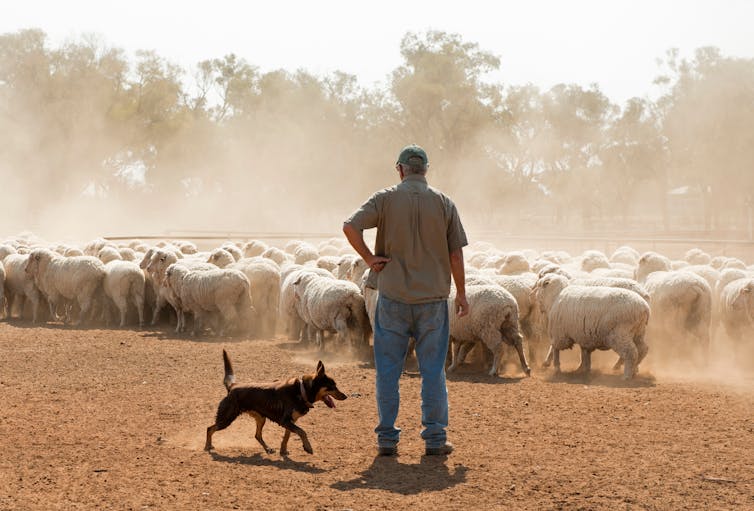
If we do make progress towards coexisting with dingoes, we could embed predator-smart techniques in the way we farm to boost biodiversity, landscape resilience, food security and livelihoods. We would bring back dingoes as apex predators and regulators of healthy ecosystems. Politics would take a step back, in favour of scientific, evidence-based approaches and First Nations input into environmental policies.
This is not hypothetical. Graziers and landholders already using predator-smart tools and strategies report many benefits. They include:
- fewer animals injured or killed by dingoes
- less time spent stalking and killing dingoes
- lower total grazing pressure from feral grazers such as goats
- boosting pasture growth and livestock profitability.
Landholders for Dingoes promotes the work of landholders who are coexisting with dingoes.
It’s time to modernise Australia’s approach to dingoes. This approach offers a potential win-win for farmers and dingoes, as well as significant gains for nature.
But to make this happen, we will have to shift our attitude towards dingoes, gain support from graziers and other stakeholders, and make non-lethal coexistence tools and approaches the new standard practice.![]()
Dr. Louise Boronyak, Research Affiliate, University of Technology Sydney and Bradley Smith, Senior Lecturer in Psychology, CQUniversity Australia
This article is republished from The Conversation under a Creative Commons license. Read the original article.
Forget the conspiracies, 15-minute cities will free us to improve our mental health and wellbeing

The idea of the 15-minute city, according to its originator Carlos Moreno, is that people are no more than a 15-minute walk or bike ride away from all the services they need to live, learn and thrive.
The idea is appealing in its simplicity: it puts people and the environment at the centre of urban planning. It involves building new urban centres and restructuring existing ones to ensure the services people need for work, food, health, education, culture and leisure are all close by – a walk or bike ride from home. Key elements are: the proximity of necessities; local participation and decision-making; community solidarity and connection; and green and sustainable urban living.
This re-imagining of local living is quickly going global. Its proponents are many and growing, and the idea is being applied on big city stages. Most notably, the 15-minute city was a feature of Paris Mayor Anne Hidalgo’s successful re-election campaign in 2020.
The United Nations has hailed the 15-minute city as a means by which cities can emerge from COVID, as well as reduce the damaging dependence on cars. The potential to promote mental health and wellbeing is significant.
Enter The Conspiracists
In 2023, though, conspiracy theories and protests have threatened to drown out the discussion of such positives.
How did that happen? By finding itself sitting at the centre of debates about COVID living, climate change and car-centric societies, the 15-minute city has become a focal point of attention for those who imagine more sinister motives are at work. Conspiracists have spouted misdirected fears of the forced loss of cars, the creation of locked urban zones people cannot leave, and government surveillance and control.
These notions were even raised recently in the UK parliament. Conservative MP Nick Fletcher called the 15-minute city an “international socialist concept” that “will cost us our personal freedom”.
A Chance To Improve Mental Health And Wellbeing
In fact, personal and community freedom, by way of giving people back meaningful time currently lost to commuting and other travel, is exactly what Moreno and proponents of 15-minute cities are focused on. In their drive to grow, cities tend to push people, the environment and their health to the periphery. Through their sprawl, Moreno argues, cities take away freedom by taking time and disconnecting their inhabitants from services and each other.
Importantly, these effects increase the risks to people’s mental health. Moreno wants us to move away from fracturing our living into “inhuman bigness”, and towards planning that focuses on what access to services, local connection and community means for the wellbeing of people and communities.
This is why the 15-minute city presents a great opportunity for better mental health. Long commuting times and the stressors of traffic congestion, road conditions and punctuality are linked to declines in subjective measures of mental health and wellbeing for workers. The benefits of reducing these stressors could be immediate.
Physical activities like walking and cycling are also widely understood to benefit mental health, as does exposure to natural, green spaces. Creating local spaces for leisure and play is vital for children and parents alike.
But, deeper than that, we need cities and urban spaces purposefully designed to promote mental health in ways that are globally recognised as impactful and essential. This process involves improving a range of social and environmental factors for individuals and community.
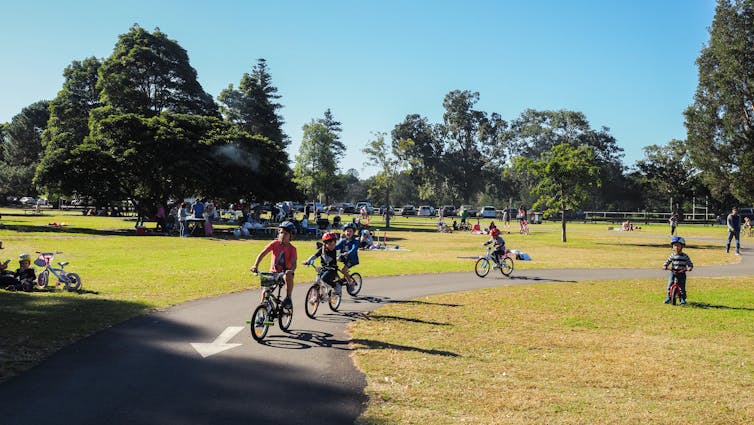
COVID Sharpened The Focus On Wellbeing
Lessons learned from COVID lockdowns have sharpened global understanding of the mental health crises and harm done to people’s wellbeing by loneliness, social isolation and disconnectedness. These conditions damage the wellbeing of communities too, by fostering stigma and promoting exclusion.
We need to move quickly towards ways of living that promote connection, inclusion and healthy communities and environments. We can achieve these goals through participation, local decision-making and sustainable ecologies.
Imagine cities with accessible housing, work and education. Imagine cities with mental health service where the focus is on inclusion, participation, connection and equitable access. Where health workers and essential services are local and available, with minimal obstacles. Imagine mental health service that is threaded through the community in meaningful, impactful ways – where every square metre is considered for its potential to improve health and wellbeing.
Mental health, wellbeing and recovery require social connection, inclusion and accessible health services. These are, without doubt, key factors in achieving better mental health. And the 15-minute city could be the template for its delivery.![]()
Christopher Patterson, Senior Lecturer, School of Nursing, University of Wollongong and Lance Barrie, Research Fellow, ARC Centre of Excellence for the Digital Child, University of Wollongong
This article is republished from The Conversation under a Creative Commons license. Read the original article.
Squid fishing grew by 68% in just three years, raising fears the industry is out of control
Quentin Hanich, University of Wollongong; Katherine Seto, University of Wollongong, and Osvaldo Urrutia, Pontificia Universidad Catolica de ValparaisoGlobal squid fishing increased by 68% between 2017 and 2020, according to our international analysis, prompting concerns that much of the international fishing fleet is sidestepping necessary conservation and management.
Our study, carried out with colleagues in Australia, Japan, the United States, Chile and Canada, and published today in Science Advances, reveals that almost all of the increase in squid fishing has occurred in unregulated areas, with 86% of squid fishing now occurring in places with little or no scrutiny of catch sizes.
Unregulated fishing poses a significant challenge to fishery sustainability and raises substantial equity concerns. While attention has tended to focus on illegal fishing, the growth in legal but unregulated fishing may pose an even bigger threat, particularly to species such as squid, whose fisheries can cover entire oceans.
To estimate the scale of global squid fishing, we analysed satellite imagery and vessel tracking data to see how many vessels are fishing for squid, and where and how often they operate.
Squid fishing vessels are typically outfitted with powerful lamps to attract squid to the surface. These lamps are so powerful that they are visible from space. This means we can use satellite data to spot these lights at night, along with data from the ships’ Automatic Identification System (AIS), which allows authorities to monitor the location and course of registered vessels.
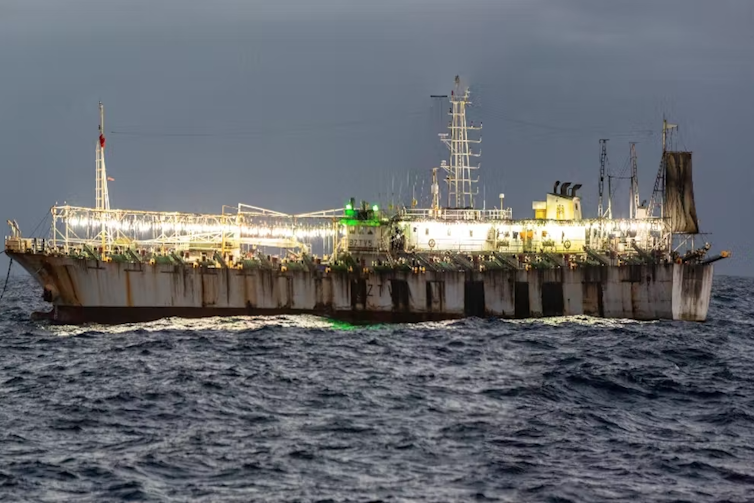
Using this data, we estimate that the amount of light-luring vessel effort increased from an estimated 149,000 vessel days in 2017, to 251,000 vessel days in 2020. Of these, 61-63% were by vessels not broadcasting their AIS, and thus only visible by the loom from their lamps. This light-luring vessel effort represents an estimated total of 801,000 vessel days over the period 2017–20.
Finally, we correlated these data with national and regional management bodies, and determine how much of this activity is unregulated.
A Complex Problem
Regulation and management of globalised squid fisheries is complex, because this fishing takes place both in waters that are under national jurisdiction and on the high seas. Consequently, cooperation is fundamental to ensure fisheries are regulated at sustainable levels and avoid gaps or loopholes.
Regional fisheries management organisations have been established through international treaties to provide the framework for such cooperation, and to regulate so-called “transboundary” fisheries. However, out of 17 such organisations in existence, only two – the North Pacific Fisheries Commission and the South Pacific Fisheries Management Organisation – have dealt with squid fisheries. This means there are still large gaps in the Indian and Atlantic oceans.
Furthermore, it is not enough to create a regional fisheries management organisations; parties must also ensure the organisation actually adopts regulations. The United Nations’ International Plan of Action to Prevent, Deter and Eliminate Illegal, Unreported and Unregulated Fishing defines unregulated fishing (among other things) as that which occurs “in areas or for fish stocks in relation to which there are no applicable conservation or management measures”. Regional fisheries management organisations must do more than simply exist or adopt general measures if their fisheries are to be considered regulated.
What We Found
Our analysis defines “regulated” fisheries as those within the exclusive economic zones of coastal countries, or within regional fisheries management organisations that have implemented specific conservation and management measures for squid stocks. In contrast, we define “unregulated” fisheries as those on the high seas where there is no such organisation in place, or where the relevant organisation has failed to adopt regulations pertaining specifically to squid stocks.
Using satellite imagery, vessel tracking, and data monitoring, our study found that globalised light-luring squid fishing fleets are truly global in scope, fishing across multiple oceans within a given year, moving freely between regulated and unregulated spaces, and catching vast amounts of squid with little or no oversight. Often, there is no requirement to report their catches to anyone other than their flag nation, with little or no independent verification.
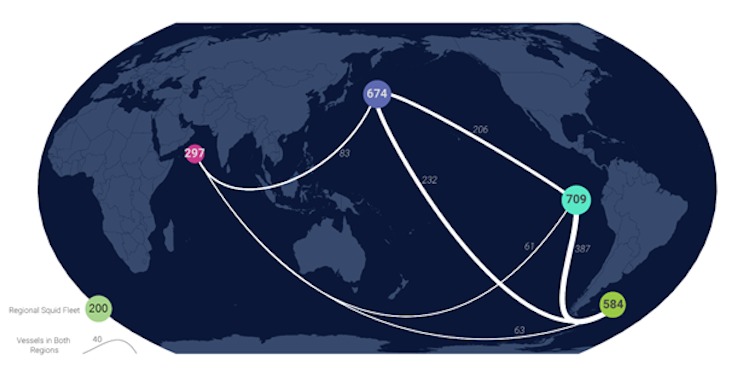
Unregulated spaces are often directly adjacent to regulated ones, and different fleets often target the same fisheries. This creates equity concerns for coastal communities that rely on species targeted by large industrial fleets, and for the governments of developing nations that depend on revenue from stocks that move between regulated and unregulated areas.
Furthermore, many of the fishing vessels carrying out unregulated fishing stay at sea for exceptionally long periods (months to years), often refuelling and offloading their catches to other vessels while still at sea, and thus avoiding the oversight that accompanies port calls.
Like all activities that draw on global resources, fishing on transboundary stocks should be fully regulated. Yet the regional bodies with the competence to adopt management measures are often restrained by distant water fishing nations that stall or oppose conservation and management measures.
The global squid fishery shows how important it is to strengthen regional management of high seas resources and to continue international calls for states and regional bodies to take this challenge seriously. These fisheries are ultimately shared by us all, yet few receive any benefit, and nearby countries’ own fish stocks are sometimes unfairly depleted.
Furthermore, the trans-oceanic nature of these fisheries highlights the crucial importance of comprehensive data-sharing agreements between regional fisheries management organisations for improving understanding of the movements of these vessels, and quantifying their impacts on squid stocks.![]()
Quentin Hanich, Professor, University of Wollongong; Katherine Seto, Research Fellow, University of Wollongong, and Osvaldo Urrutia, Associate professor, Pontificia Universidad Catolica de Valparaiso
This article is republished from The Conversation under a Creative Commons license. Read the original article.
Penguin paradise and geological freak: why Macquarie Island deserves a bigger marine park

Macquarie Island, around 1,500km southeast of Tasmania, is more than just a remote rocky outcrop. In fact, it’s the only piece of land on the planet formed completely from ocean floor, which rises above the waves to form peaks that teem with penguins and other bird species, some of them found nowhere else on Earth.
These are just some of the reasons why this unique island, and the seas that surround it, have globally significant conservation values. Our new independent assessment of these values forms the scientific evidence base of Federal Environment Minister Tanya Plibersek’s announcement last month of plans to significantly increase protections for the waters surrounding Macquarie Island.
By comprehensively assessing the available data on the marine ecosystems and the many species that live on and around Macquarie Island, our report reveals a subantarctic environment that is crucial for breeding and feeding for millions of seabirds and thousands of marine mammals.
Macquarie Island and its surrounding seas (to a distance of 5.5km) are already protected as a Tasmanian reserve, and the area (this time including seas to a distance of 22km) is also a World Heritage Area. A Commonwealth marine park also covers most of the southeast quadrant of the island’s “economic exclusion zone”, including a sanctuary zone and two seafloor management zones.
The federal government’s proposed expansion of the marine park would cover the island’s entire economic exclusion zone, increasing the area of Australia’s marine sanctuaries by more than 388,000 square kilometres, an increase larger than the area of Germany.
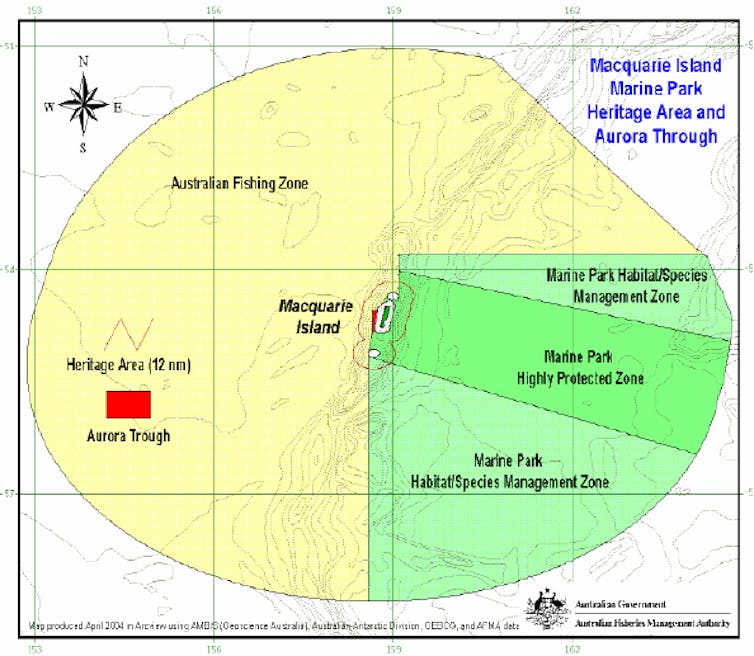
An Outstanding Spectacle
Macquarie Island is the exposed crest of the 1,600km-long undersea Macquarie Ridge, which makes Macquarie Island the only piece of land in the world formed entirely of oceanic crust.
Macquarie Ridge is one of only three such ridges that impede the eastward flow of a current called the Antarctic Circumpolar Circulation, resulting in distinct differences between the west and east sides of the ridge, which are used in different ways by different species.
The oceanography is further divided north to south by two major ocean fronts, the Sub-Antarctic Front and the Polar Front, creating three distinct bodies of water. They are closer here than anywhere else in the Southern Ocean, and as they interact with the Macquarie Ridge create at least six different large-scale oceanographic habitats.
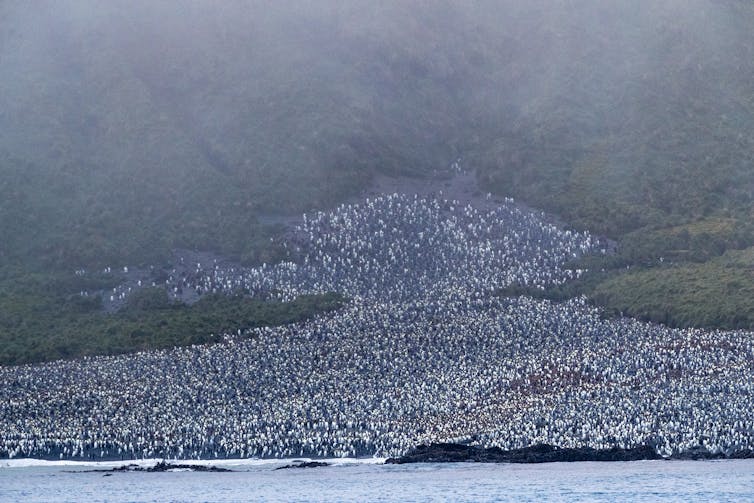
This creates an outstanding spectacle of wild, natural beauty and a diverse set of habitats supporting vast congregations of wildlife, including penguins and seals. Fifty-seven seabird species, including four species of penguins and four species of albatross, have been recorded on Macquarie Island, and 25 of these species have been observed breeding there. The royal penguin and the Macquarie Island imperial shag live nowhere else on Earth.
The ridge includes a series of undersea mountains that act as “stepping stones” linking subantarctic and polar animals on the sea floor, such as brittlestars.
Needing More Protection
Our report shows the area around Macquarie Island is not well represented by the current marine park. In particular, the entire area to the west, and most of the northern and southern parts of the Macquarie Ridge, are not protected by the current marine park, but will be included in the proposed expansion.
Our report also considers several options for protecting the area’s unique ecosystems and concludes that the most sensible approach, given the available data, would be to declare the whole area around the Macquarie Ridge as a marine park, increasing the protection outside the current sanctuary zone, while allowing the current fishery to continue in a habitat protection zone.
This provides the simplest, most expeditious reserve design that is relatively easy to implement, achieves environmental protection and sustainable fishing, recognises the importance of the entire Macquarie Island region, and provides the most resilience to climate change.

Direct human impacts in the area are predominantly due to fishing and marine debris, although climate change is an ever-present threat too. The fishery targets the deepwater Patagonian toothfish using bottom longlines, mostly in the central zone of the Macquarie Ridge. This fishery is generally well regarded for its best-practice fishing methods and commitment to positive environmental outcomes, and this fishing activity would continue under the new plans.
But if new fisheries were allowed to develop targeting midwater species, or new industries such as seabed mining were permitted, these could directly impact the seabirds, marine mammals and other species that live in these areas.
The proposal put forward by Minister Plibersek protects all of the Commonwealth waters in two different zones of a marine park, effectively tripling the size of the current marine park. It protects the marine domain and allows the current fishery to continue without significant changes to current practices or catches.
Restrictions on any potential future fisheries would be determined by the distribution of “sanctuary zones” which would preclude fishing, and “habitat/species zones”, which could accommodate sustainable fishing. Mining would be precluded under either category of protection.
What Next?
The government’s proposal signals a clear priority for protection over development in this area. A period of public consultation on the proposal will commence in March. Any future development of the marine park would need to be orderly and careful, including prior consideration of environmental impacts. Any changes to the current fishery management arrangements should ensure that the changes maintain or enhance conditions for a long-term sustainable fishery.
More broadly, our report also demonstrates the potential for, and importance of, compiling the most up-to-date available data for any region prior to any formal review process to update Australia’s marine park network.
The authors thank Anthony D. M. Smith for his contribution to this article and the report on which it’s based.![]()
Ian Cresswell, Adjunct professor, UNSW Sydney; Andrew J. Constable, Leader, Southern Ocean Ecosystem Research, University of Tasmania; Keith Reid, Honorary Research Associate, and Nic Bax, Director, NERP Marine Biodiversity Hub, CSIRO
This article is republished from The Conversation under a Creative Commons license. Read the original article.
Can seaweed save the world? Well it can certainly help in many ways
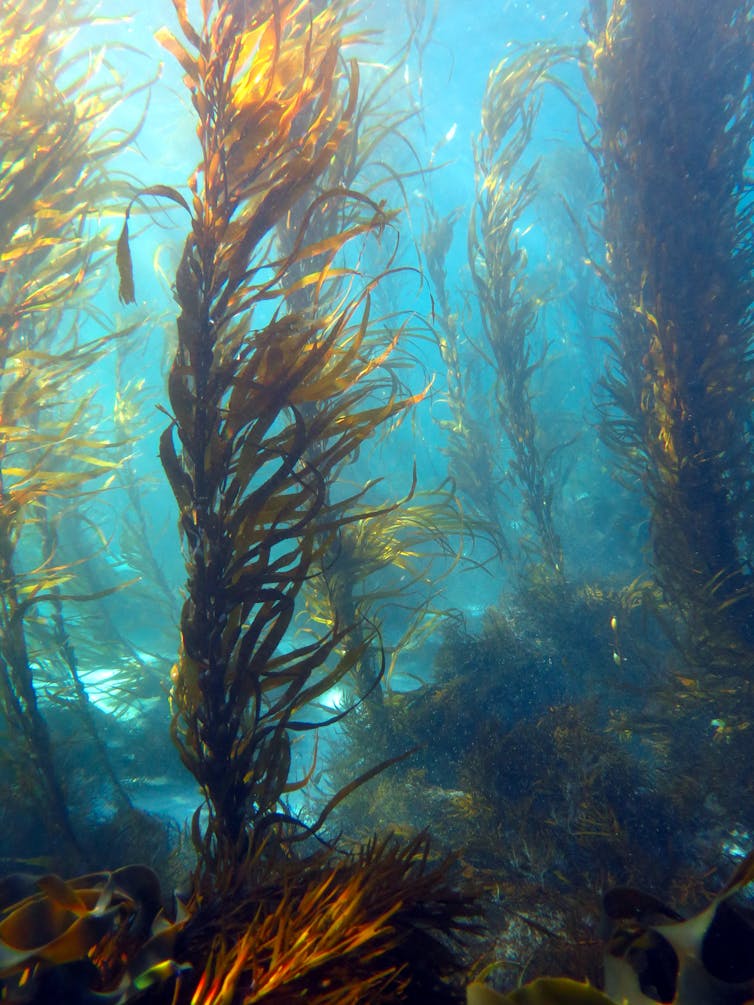
Seaweed is increasingly seen as a solution to many of the world’s most pressing problems. Interest in farming seaweed has exploded.
There’s such a wide range of applications, from fertilisers to foods, bioplastics, textiles, supplements and carbon sinks. It’s hard to think of another substance with so much potential.
Can seaweed save the world? It’s a question being posed this weekend at the WOMADelaide world music festival Planet Talks. I’m on the panel and the answer, I think, is a definite maybe!
I’ve studied seaweeds as ecosystem health indicators for years. I became interested in using seaweed to clean up nutrients in our coastal systems. Now at the Marine Bioproducts Cooperative Research Centre, my eyes have opened to the huge diversity of Australian seaweeds and their many amazing applications.
A Marvelous Multitool
Seaweed is a catch-all term for marine plants. These are the primary producers in our marine and aquatic systems.
In many ways, they’re as diverse as the plants you see on land. Many are foundational species that act like forests underwater, but they come in many different types and forms. We group them into reds, greens and browns. And they have very different properties, just like terrestrial plants, depending on the species and where they live.
It’s true that seaweed has huge potential to address some of the most wicked problems facing the planet. If we were to think of seaweed as one of the tools in the toolbox, they’d be the multitool or Swiss army knife with a wide range of potential applications, including:
reducing methane production in cows and other ruminants such as goats and sheep
capturing and storing carbon dioxide
boosting protein and nutrients in food products
providing extra health benefits in new therapeutics
soaking up excess nutrients in wastewater
creating new materials such as bioplastics, packaging and textiles.
Another thing that blows me away with seaweed is that one plant can actually tap into several of these market opportunities. So you could be growing it as a nutraceutical supplement, a fibre for textiles and as a fertiliser, all at once. That’s really exciting because it’s not something many of our traditional farming approaches have been able to do.
Not Without Its Challenges
Early studies suggested that scaling up seaweed aquaculture could make a big difference to climate change by capturing carbon dioxide emissions. But it turns out it’s not as simple as that.
Verifying whether the carbon dioxide fixed by seaweeds through photosynthesis can be locked up long-term is extremely complex. There are differences between species and ecosystems. And research has to factor in the interactions of the various organisms that live on and around seaweed communities, as well as the prevailing environmental conditions.
In some situations, seaweed ecosystems produce more carbon than they can capture.
However, seaweeds may still have a contribution in this space through carbon offsets. As they can be used to make new products to replace other materials that have larger carbon footprints. This includes new foods, new materials such as fabrics, and new building supplies designed to store carbon in the long term.
Cutting Methane Emissions And Other Benefits
The native Australian red seaweed Asparagopsis has been shown to markedly reduce methane production in cattle, when added to their diet.
Methane is a potent greenhouse gas that contributes to global warming. It accounts for 20-30% of all greenhouse gas emissions, much of it associated with livestock production.
Any significant reduction in methane production “would have a rapid and significant effect on atmospheric warming potential”, according to a report from the US Environmental Protection Agency.
At the most recent global climate meeting, COP26, it was clearly noted that current national climate commitments will not be enough to avoid exceeding 1.5℃ of warming. So we need new and radical solutions. If Asparagopsis farming lives up to its potential, it could make a truly meaningful difference.
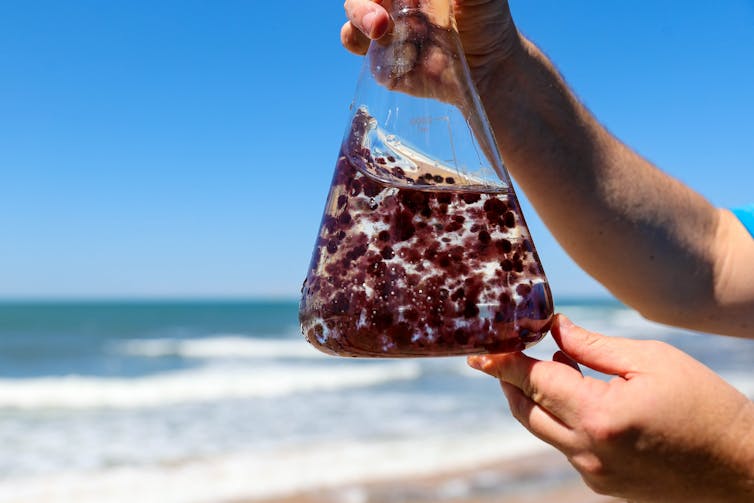
Seaweed can improve intensive agriculture too. As highly effective biostimulants, they provide viable alternatives to synthetic fertilisers.
Seaweed can also be used to recover and recycle excess nutrients such as nitrogen and phosphates from wastewater. So when you have large human populations, intensive land-based farming or aquaculture facilities releasing nutrients into our coastal systems, can be a very effective way to respond to that. Seaweed farms can do better when grown in areas with higher nutrient levels, such as alongside fed finfish production facilities.
Human health and medical benefits extend beyond commercially viable and tasty alternative protein sources. Some seaweeds can contain 10-30% protein, which is comparable with soy protein levels. But they also have the added natural advantage of relatively high levels of long-chain omega-3 fatty acids (brain food), which are not naturally found in terrestrial food sources.
Increasingly we are finding seaweeds with anticoagulant, anti-inflammatory, antioxidant, anticarcinogenic and antiviral properties. Several types of kelp have been shown to promote a beneficial immune response.
Seaweed supplements in animal feeds have also been shown to offer advantages such as improved gut health and digestive efficiency. This has the potential to markedly improve yield and other outcomes on farms.
Let’s Get On With It
There are still challenges to overcome, and there may be more issues to contend with down the track. But if we support coordinated and appropriate research and development, focused on fast-tracking the benefits that seaweed has to offer, Australian seaweed really can play a big part in saving the world.
It’s worth mentioning here, several initiatives and funding bodies that are currently supporting seaweed research and development in Australia. Most notably the Marine Bioproducts Co-operative Research Centre (MBCRC), the Blue Economy CRC, AgriFutures Australia, the Fisheries Research and Development Corporation (FRDC) and the Australian Sustainable Seaweed Alliance (ASSA).
And it’s really encouraging to see broader community engagement in this conversation including the panel discussion at the WOMADelaide Festival Planet Talks series. It’s great to have a chance to talk openly about the challenges while showcasing the opportunities. It’s complicated, but it’s exciting. Let’s get on with it.![]()
Catriona Macleod, Professor, University of Tasmania
This article is republished from The Conversation under a Creative Commons license. Read the original article.
Bushfire smoke eats up the ozone protecting us from dangerous radiation. The damage will increase as the world heats up
Ian Rae, The University of MelbourneCan bushfire smoke reduce the concentration of ozone in the stratosphere? A decade ago, we might have been sceptical. But there’s a growing body of research showing a clear link.
Last year, MIT expert Susan Solomon and colleagues published a groundbreaking study showing the 900,000 tonnes of bushfire smoke and particles emitted during Australia’s 2019–20 Black Summer did, in fact, thin out the ozone umbrella that protects us.
Ozone floats around 20–25 kilometres above our heads, acting like airborne sunscreen. Its concentration is tiny – up to 15 parts per million – but it is highly effective at blocking damaging ultraviolet-B rays from the sun. Without this layer, many plants would die, while humans and other animals would be afflicted with skin cancers.
The Black Summer fires burned so much forest and scrub across the country they produced massive pyrocumulus clouds. The fires were making their own weather, sending plumes of smoke into the higher reaches of our atmosphere, where smoke particles interacted with ozone. That single Australian summer of fire took out 1% of the atmosphere’s ozone – damage that will take a decade to fix.
Now, Solomon’s researchers have found out how smoke actually does it. In their new research, they detail the chemistry involved. This research is important, as we enter what’s been dubbed the Pyrocene – the age of fire – with bushfires already growing in size and intensity as the world heats up.
So How Does Smoke Break Ozone?
Australians became all too familiar with the sight and smell of bushfire smoke over the Black Summer. But what’s in it?
Particles in bushfire smoke are carbonaceous, consisting of burnt and partly burnt vegetable material alongside sulfates – compounds which can be pumped into the atmosphere by volcanoes, fossil fuel burning, or bushfires.
The problem is, these carbonaceous particles bind well to substances like hydrogen chloride which comes from the chemical compounds found in living plants. Other compounds with chlorine are also involved in the smoke, such as the reactive chlorine nitrate and hypochlorous acid.
The tiny smoke particles act as transport, carrying these substances containing chlorine up higher and higher to the stratosphere. Once there, chlorine sets about destroying ozone, molecule by molecule. Each chlorine atom can take apart hundreds of ozone molecules, meaning a small amount can have a disproportionate impact.
To find this out, Solomon and her colleagues relied heavily on models of the atmospheric chemistry. Their results agreed well with experimental observations made by satellite. So, although the chemical interactions have not been fully shown, the overall picture is probably correct.
You might remember it was chlorine atoms at the heart of our fears about the hole in the ozone layer. Almost 50 years ago, scientists discovered our protective ozone layer was thinning – and connected it to the chlorine-dense chlorofluorocarbons (CFCs) used in spray cans and refrigerators.
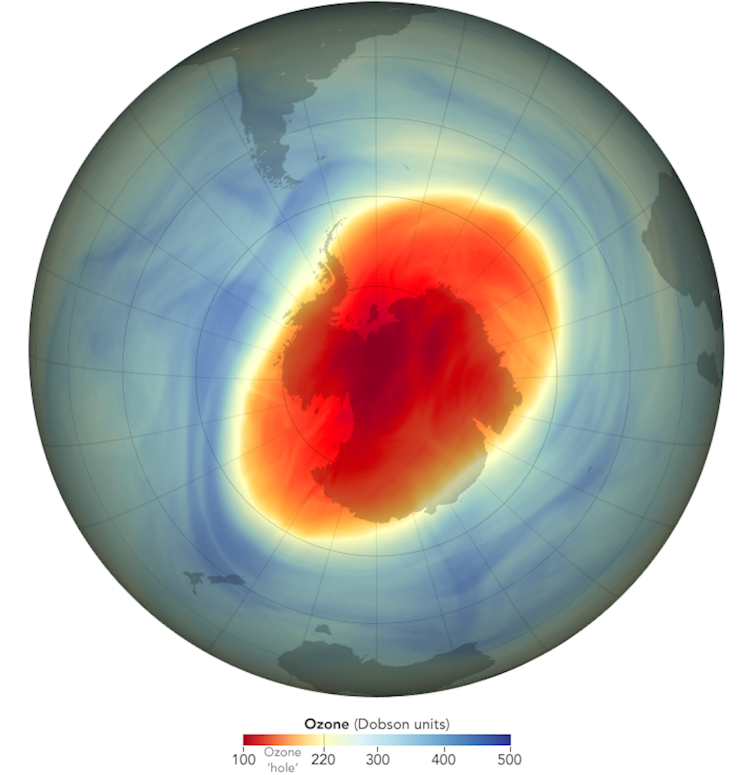
The area of greatest loss was dubbed the “ozone hole”, which still appears over Antarctica each year in spring in smaller form.
The way we responded to the loss of stratospheric ozone is remarkable, in retrospect. In 1987, nations agreed to the Montreal Protocol, banning CFC manufacture and use. It worked, and concentrations of ozone are now recovering by around 1% a year. That figure is about what was lost during the Black Summer.
What Does This Mean For The Future?
It means the ozone layer will be slowly degraded by wildfire smoke. Fires burn in both northern and southern hemispheres, and their smoke is swept around the globe by natural processes. That means we’re likely to see falling ozone concentrations in new places rather than just around the South Pole. Affected areas would include the mid-latitudes around the equator, where billions of people live.
Ozone does replenish itself. It’s continuously formed and destroyed in the stratosphere. The net balance of these competing processes has – until now – been a steady but small concentration of ozone. This layer makes life possible by absorbing the worst of the ultraviolet light pouring down from the sun and giving us a measure of protection from skin-damaging radiation.
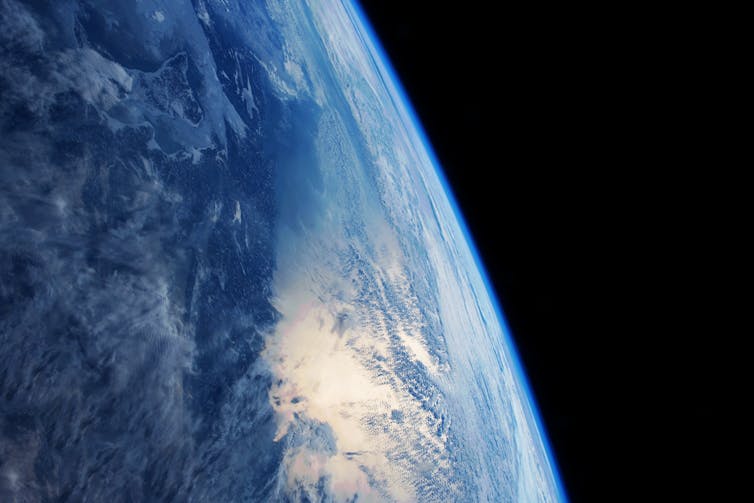
A hotter world is one with more fire in it, affecting areas like Siberian tundra, Californian mountains and Kenyan grasslands.
This research is yet another warning about the perils of unmitigated climate change. Bushfire smoke could undo the good work of the Montreal Protocol.
In retrospect, achieving this protocol seems relatively straightforward: ban one class of chemicals. To stop bushfire smoke eating away at our ozone umbrella means reversing climate change. And that is something we are struggling to do. ![]()
Ian Rae, Honorary Professorial Fellow, School of Chemistry, The University of Melbourne
This article is republished from The Conversation under a Creative Commons license. Read the original article.
Pittwater Reserves: Histories + Notes + Pictorial Walks
A History Of The Campaign For Preservation Of The Warriewood Escarpment by David Palmer OAM and Angus Gordon OAM
A Stroll Through Warriewood Wetlands by Joe Mills February 2023
A Walk Around The Cromer Side Of Narrabeen Lake by Joe Mills
America Bay Track Walk - photos by Joe Mills
An Aquatic June: North Narrabeen - Turimetta - Collaroy photos by Joe Mills
Angophora Reserve Angophora Reserve Flowers Grand Old Tree Of Angophora Reserve Falls Back To The Earth - History page
Annie Wyatt Reserve - A Pictorial
Avalon's Village Green: Avalon Park Becomes Dunbar Park - Some History + Toongari Reserve and Catalpa Reserve
Bairne Walking Track Ku-Ring-Gai Chase NP by Kevin Murray
Bangalley Headland Bangalley Mid Winter
Banksias of Pittwater
Barrenjoey Boathouse In Governor Phillip Park Part Of Our Community For 75 Years: Photos From The Collection Of Russell Walton, Son Of Victor Walton
Barrenjoey Headland: Spring flowers
Barrenjoey Headland after fire
Bayview Baths
Bayview Wetlands
Beeby Park
Bilgola Beach
Botham Beach by Barbara Davies
Bungan Beach Bush Care
Careel Bay Saltmarsh plants
Careel Bay Birds
Careel Bay Clean Up day
Careel Bay Playing Fields History and Current
Careel Creek
Careel Creek - If you rebuild it they will come
Centre trail in Ku-ring-gai Chase National Park
Chiltern Track- Ingleside by Marita Macrae
Clareville Beach
Clareville/Long Beach Reserve + some History
Coastal Stability Series: Cabbage Tree Bay To Barrenjoey To Observation Point by John Illingsworth, Pittwater Pathways, and Dr. Peter Mitchell OAM
Cowan Track by Kevin Murray
Curl Curl To Freshwater Walk: October 2021 by Kevin Murray and Joe Mills
Currawong and Palm Beach Views - Winter 2018
Currawong-Mackerel-The Basin A Stroll In Early November 2021 - photos by Selena Griffith
Currawong State Park Currawong Beach + Currawong Creek
Deep Creek To Warriewood Walk photos by Joe Mills
Drone Gives A New View On Coastal Stability; Bungan: Bungan Headland To Newport Beach + Bilgola: North Newport Beach To Avalon + Bangalley: Avalon Headland To Palm Beach
Duck Holes: McCarrs Creek by Joe Mills
Dunbar Park - Some History + Toongari Reserve and Catalpa Reserve
Dundundra Falls Reserve: August 2020 photos by Selena Griffith - Listed in 1935
Elsie Track, Scotland Island
Elvina Track in Late Winter 2019 by Penny Gleen
Elvina Bay Walking Track: Spring 2020 photos by Joe Mills
Elvina Bay-Lovett Bay Loop Spring 2020 by Kevin Murray and Joe Mills
Fern Creek - Ingleside Escarpment To Warriewood Walk + Some History photos by Joe Mills
Iluka Park, Woorak Park, Pittwater Park, Sand Point Reserve, Snapperman Beach Reserve - Palm Beach: Some History
Ingleside
Ingleside Wildflowers August 2013
Irrawong - Ingleside Escarpment Trail Walk Spring 2020 photos by Joe Mills
Irrawong - Mullet Creek Restoration
Katandra Bushland Sanctuary - Ingleside
Lucinda Park, Palm Beach: Some History + 2022 Pictures
McCarrs Creek
McCarr's Creek to Church Point to Bayview Waterfront Path
McKay Reserve
Mona Vale Beach - A Stroll Along, Spring 2021 by Kevin Murray
Mona Vale Headland, Basin and Beach Restoration
Mount Murray Anderson Walking Track by Kevin Murray and Joe Mills
Mullet Creek
Narrabeen Creek
Narrabeen Lagoon Catchment: Past Notes Present Photos by Margaret Woods
Narrabeen Lagoon State Park
Narrabeen Lagoon State Park Expansion
Narrabeen Rockshelf Aquatic Reserve
Nerang Track, Terrey Hills by Bea Pierce
Newport Bushlink - the Crown of the Hill Linked Reserves
Newport Community Garden - Woolcott Reserve
Newport to Bilgola Bushlink 'From The Crown To The Sea' Paths: Founded In 1956 - A Tip and Quarry Becomes Green Space For People and Wildlife
Pittwater Reserves: The Green Ways; Bungan Beach and Bungan Head Reserves: A Headland Garden
Pittwater Reserves, The Green Ways: Clareville Wharf and Taylor's Point Jetty
Pittwater Reserves: The Green Ways; Hordern, Wilshire Parks, McKay Reserve: From Beach to Estuary
Pittwater Reserves - The Green Ways: Mona Vale's Village Greens a Map of the Historic Crown Lands Ethos Realised in The Village, Kitchener and Beeby Parks
Pittwater Reserves: The Green Ways Bilgola Beach - The Cabbage Tree Gardens and Camping Grounds - Includes Bilgola - The Story Of A Politician, A Pilot and An Epicure by Tony Dawson and Anne Spencer
Pittwater spring: waterbirds return to Wetlands
Pittwater's Lone Rangers - 120 Years of Ku-Ring-Gai Chase and the Men of Flowers Inspired by Eccleston Du Faur
Pittwater's Parallel Estuary - The Cowan 'Creek
Resolute Track at West Head by Kevin Murray
Resolute Track Stroll by Joe Mills
Riddle Reserve, Bayview
Salvation Loop Trail, Ku-Ring-Gai Chase National Park- Spring 2020 - by Selena Griffith
Seagull Pair At Turimetta Beach: Spring Is In The Air!
Stapleton Reserve
Stapleton Park Reserve In Spring 2020: An Urban Ark Of Plants Found Nowhere Else
Stony Range Regional Botanical Garden: Some History On How A Reserve Became An Australian Plant Park
The Chiltern Track
The Resolute Beach Loop Track At West Head In Ku-Ring-Gai Chase National Park by Kevin Murray
Topham Track Ku-Ring-Gai Chase NP, August 2022 by Joe Mills and Kevin Murray
Towlers Bay Walking Track by Joe Mills
Trafalgar Square, Newport: A 'Commons' Park Dedicated By Private Landholders - The Green Heart Of This Community
Tranquil Turimetta Beach, April 2022 by Joe Mills
Turimetta Beach Reserve by Joe Mills, Bea Pierce and Lesley
Turimetta Beach Reserve: Old & New Images (by Kevin Murray) + Some History
Turimetta Headland
Warriewood Wetlands and Irrawong Reserve
Whale Beach Ocean Reserve: 'The Strand' - Some History On Another Great Protected Pittwater Reserve
Wilshire Park Palm Beach: Some History + Photos From May 2022
Winji Jimmi - Water Maze

New Shorebirds WingThing For Youngsters Available To Download
A Shorebirds WingThing educational brochure for kids (A5) helps children learn about shorebirds, their life and journey. The 2021 revised brochure version was published in February 2021 and is available now. You can download a file copy here.
If you would like a free print copy of this brochure, please send a self-addressed envelope with A$1.10 postage (or larger if you would like it unfolded) affixed to: BirdLife Australia, Shorebird WingThing Request, 2-05Shorebird WingThing/60 Leicester St, Carlton VIC 3053.

 Shorebird Identification Booklet
Shorebird Identification Booklet
The Migratory Shorebird Program has just released the third edition of its hugely popular Shorebird Identification Booklet. The team has thoroughly revised and updated this pocket-sized companion for all shorebird counters and interested birders, with lots of useful information on our most common shorebirds, key identification features, sighting distribution maps and short articles on some of BirdLife’s shorebird activities.
The booklet can be downloaded here in PDF file format: http://www.birdlife.org.au/documents/Shorebird_ID_Booklet_V3.pdf
Paper copies can be ordered as well, see http://www.birdlife.org.au/projects/shorebirds-2020/counter-resources for details.
Download BirdLife Australia's children’s education kit to help them learn more about our wading birdlife
Shorebirds are a group of wading birds that can be found feeding on swamps, tidal mudflats, estuaries, beaches and open country. For many people, shorebirds are just those brown birds feeding a long way out on the mud but they are actually a remarkably diverse collection of birds including stilts, sandpipers, snipe, curlews, godwits, plovers and oystercatchers. Each species is superbly adapted to suit its preferred habitat. The Red-necked Stint is as small as a sparrow, with relatively short legs and bill that it pecks food from the surface of the mud with, whereas the Eastern Curlew is over two feet long with a exceptionally long legs and a massively curved beak that it thrusts deep down into the mud to pull out crabs, worms and other creatures hidden below the surface.
Some shorebirds are fairly drab in plumage, especially when they are visiting Australia in their non-breeding season, but when they migrate to their Arctic nesting grounds, they develop a vibrant flush of bright colours to attract a mate. We have 37 types of shorebirds that annually migrate to Australia on some of the most lengthy and arduous journeys in the animal kingdom, but there are also 18 shorebirds that call Australia home all year round.
What all our shorebirds have in common—be they large or small, seasoned traveller or homebody, brightly coloured or in muted tones—is that each species needs adequate safe areas where they can successfully feed and breed.
The National Shorebird Monitoring Program is managed and supported by BirdLife Australia.
This project is supported by Glenelg Hopkins Catchment Management Authority and Hunter Local Land Services through funding from the Australian Government’s National Landcare Program. Funding from Helen Macpherson Smith Trust and Port Phillip Bay Fund is acknowledged.
The National Shorebird Monitoring Program is made possible with the help of over 1,600 volunteers working in coastal and inland habitats all over Australia.
The National Shorebird Monitoring program (started as the Shorebirds 2020 project initiated to re-invigorate monitoring around Australia) is raising awareness of how incredible shorebirds are, and actively engaging the community to participate in gathering information needed to conserve shorebirds.
In the short term, the destruction of tidal ecosystems will need to be stopped, and our program is designed to strengthen the case for protecting these important habitats.
In the long term, there will be a need to mitigate against the likely effects of climate change on a species that travels across the entire range of latitudes where impacts are likely.
The identification and protection of critical areas for shorebirds will need to continue in order to guard against the potential threats associated with habitats in close proximity to nearly half the human population.
Here in Australia, the place where these birds grow up and spend most of their lives, continued monitoring is necessary to inform the best management practice to maintain shorebird populations.
BirdLife Australia believe that we can help secure a brighter future for these remarkable birds by educating stakeholders, gathering information on how and why shorebird populations are changing, and working to grow the community of people who care about shorebirds.
To find out more visit: http://www.birdlife.org.au/projects/shorebirds-2020/shorebirds-2020-program
Aussie Bread Tags Collection Points

Praying Mantis
Mantises are an order (Mantodea) of insects that contains over 2,400 species in about 460 genera in 33 families. The largest family is the Mantidae ("mantids"). Mantises are distributed worldwide in temperate and tropical habitats. They have triangular heads with bulging eyes supported on flexible necks. Their elongated bodies may or may not have wings, but all Mantodea have forelegs that are greatly enlarged and adapted for catching and gripping prey; their upright posture, while remaining stationary with forearms folded, has led to the common name praying mantis.
The closest relatives of mantises are termites and cockroaches (Blattodea), which are all within the superorder Dictyoptera.
Mantises are sometimes confused with stick insects (Phasmatodea), other elongated insects such as grasshoppers (Orthoptera), or other more distantly related insects with raptorial forelegs such as mantisflies (Mantispidae). Mantises are mostly ambush predators, but a few ground-dwelling species are found actively pursuing their prey.
They normally live for about a year. In cooler climates, the adults lay eggs in Autumn. The eggs are protected by their hard capsules and hatch in the Spring.
The earliest mantis fossils are about 140 million years old, from Siberia.
Mantises have stereo vision. In 2018 the team at Newcastle University, UK has discovered that mantis 3D vision works differently from all previously known forms of biological 3D vision. 3D or stereo vision helps us work out the distances to the things we see. Each of our eyes sees a slightly different view of the world. Our brains merge these two views to create a single image, while using the differences between the two views to work out how far away things are. But humans are not the only animals that have stereo vision. Other animals include monkeys, cats, horses, owls and toads, but the only insect known to have stereo vision is the praying mantis.
This so-called 3D vision - also known as stereopsis - is how creatures with binocular vision produce depth perception when they're taking in the world.
They locate their prey by sight; their compound eyes contain up to 10,000 ommatidia. An insect's compound eye is made up of many individual units packed together to form the surface of the eye. These units are hexagonal in shape and called 'ommatidea' (singular ommatidium). Each eye can have more than a thousand ommatidea.
A small area at the front called the fovea has greater visual acuity than the rest of the eye, and can produce the high resolution necessary to examine potential prey. The peripheral ommatidia are concerned with perceiving motion; when a moving object is noticed, the head is rapidly rotated to bring the object into the visual field of the fovea.
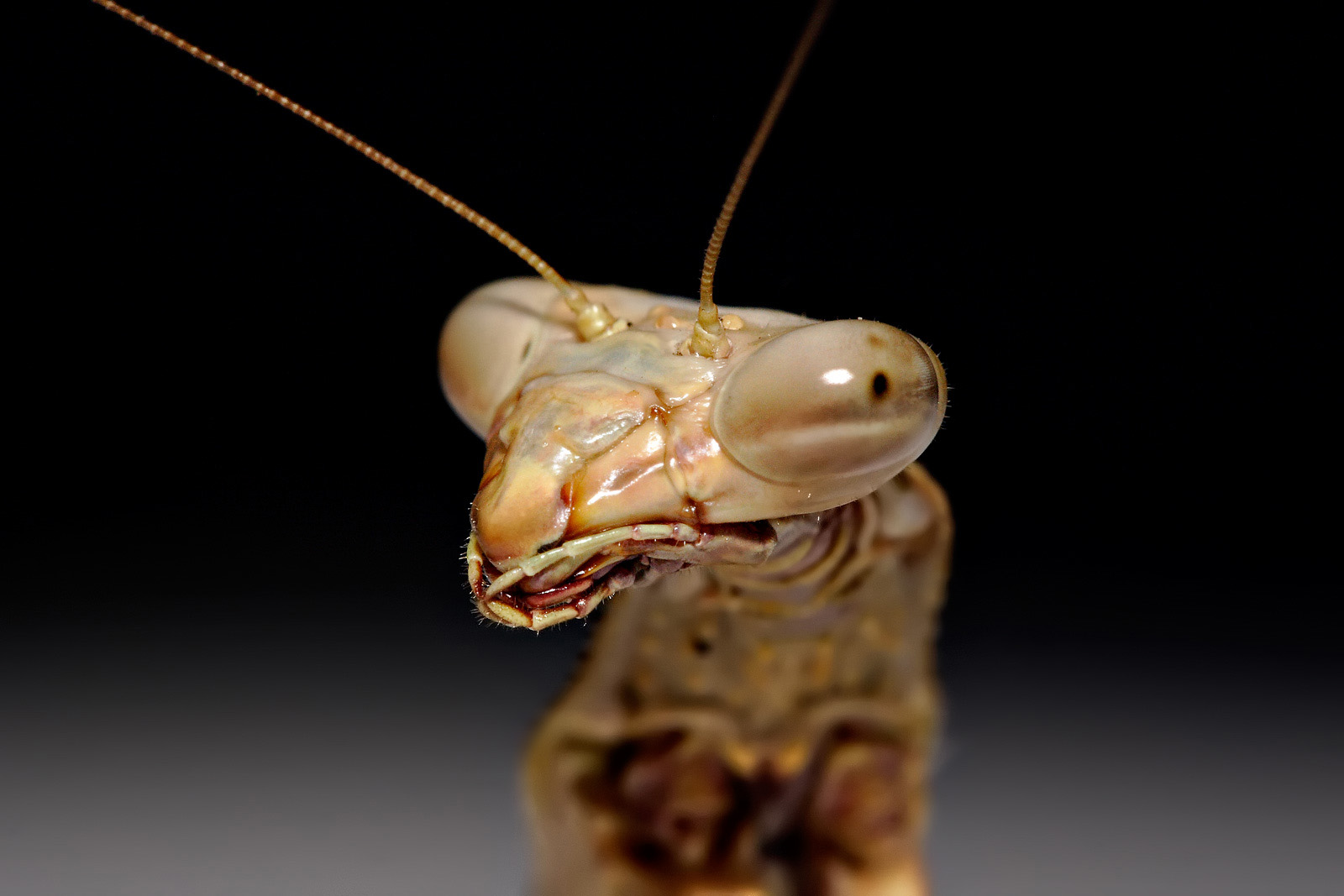
Head of Archimantis latistyla, showing the compound eyes and labrum. Taken in Swifts Creek, Victoria, Australia. Photo: Fir0002
A praying mantis filmed this week in Avalon Beach:
Australia Post Delivers Building Blocks For A Brighter Future
Continuing its partnership with not-for-profit Indigenous charity DeadlyScience, Australia Post is packing and delivering LEGO® products to more than 750 First Nations schools and communities across Australia this week.
The LEGO sets will make their way across metropolitan, regional and remote Australia via Australia Post’s chartered planes and barges and its fleet of trucks, eDVs, vans and motorbikes. The LEGO sets will be used as an educational Science, Technology, Engineering and Mathematics (STEM) resource, benefiting over 34,500 First Nations students.
Australia Post Executive General Manager Community, Sustainability and Stakeholder Engagement, Tanny Mangos, highlighted how the breadth of Australia Post’s network played a key role in reaching many of the regional and remote communities supported by this DeadlyScience initiative.
“It’s fantastic to be able to leverage our vast delivery network to get these important packages out to so many First Nations schools and communities.
“At Australia Post we remain firmly committed to supporting literacy in Aboriginal and Torres Strait Islander communities and this partnership with DeadlyScience provides us with the opportunity to play a key role in delivering critical materials to these schools and communities.
“We love the excitement and joy on the students faces when they receive their packages, knowing that we have played a role in making that possible,” Ms Mangos concluded.

Corey and Tanny packing up the sets to send out.
“The support from Australia Post to deliver LEGO products to over 34,500 Aboriginal and Torres Strait Islander students across Australia will help DeadlyScience to build future generations of engineers,” said DeadlyScience CEO, Corey Tutt OAM.
“The LEGO System in Play offers a great foundation for engineering through learning through play; providing so many opportunities for students to explore this field.”
DeadlyScience, founded in 2018 by proud Kamilaroi man Corey Tutt OAM, celebrates Australia’s first scientists, First Nations people –and aims to build future generations of First Nations deadly scientists, technicians, engineers, mathematicians and STEM leaders.
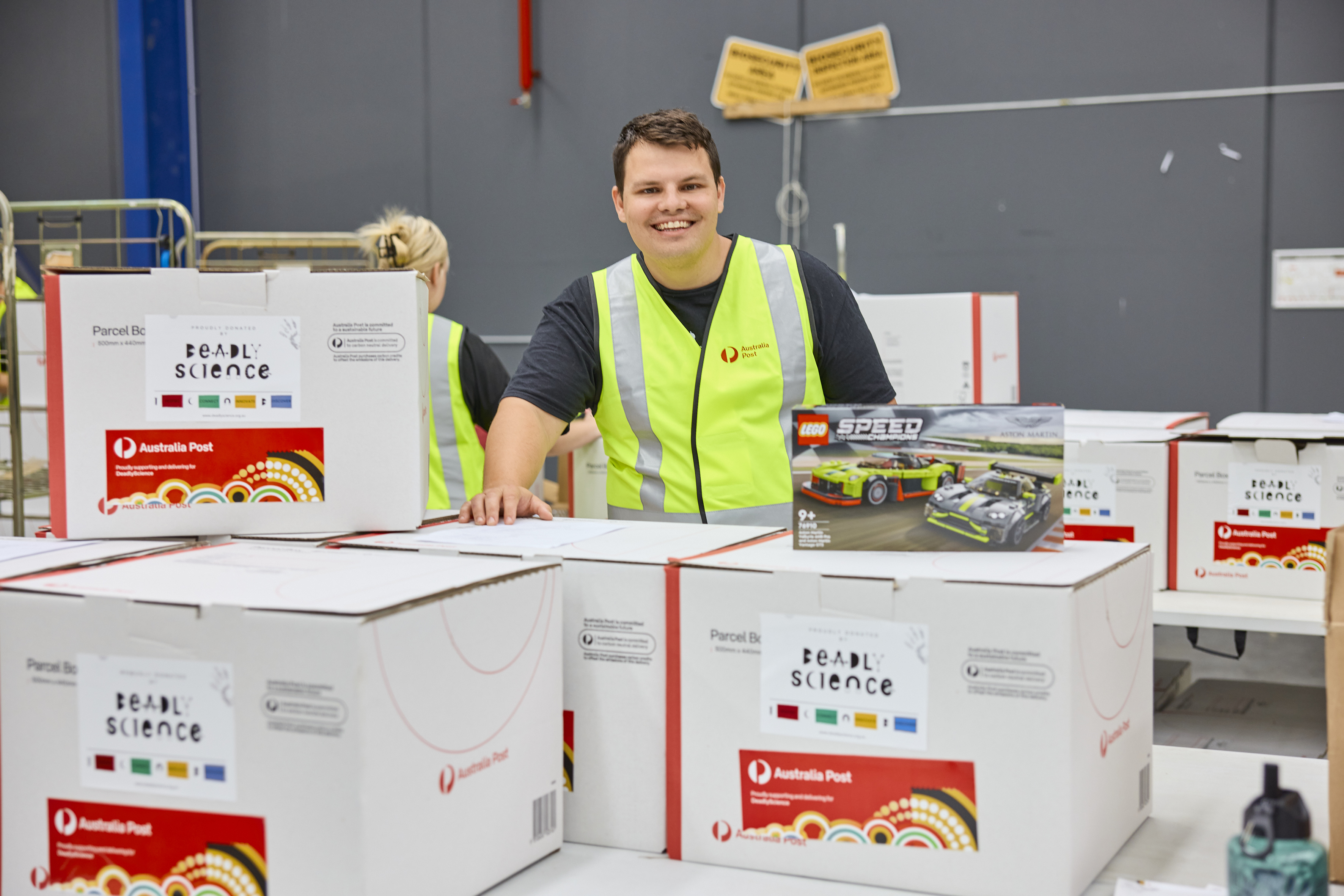
Corey Tutt OAM at the Australia Post packing centre
Royal National Park Line (And The Sydney Tramway Museum): Lost Sydney
Published March 2023 by Building Beautifully
The Royal National Park is one of the most gorgeous national parks in the greater Sydney region, and is a very popular daytrip destination. Did you know that, once upon a time, you could catch the train to the Royal National Park? The line operated from 1886 to 1991, and once upon a time it was a very popular line. Unfortunately, the line eventually closed...but the Sydney Tram Museum swooped right in and rescued the line from total abandonment. Follow me as we uncover the magical story of the Royal National Park; a line, a closure, a saviour.
Express Yourself 2023 Winners Announced
HAYLEY BENNETT, for My latio dissonante vulgari (My Cacophony) - The Forest High
CHARLOTTE YAN, for Devolution - NBSC - Freshwater Senior Campus
Friends of MAG&M Youth Art Award – shared winner
JOSH BOEHM, for Power of now - St Paul’s Catholic College
MIA HAMILL, for The Joy of Dance - NBSC - Freshwater Senior Campus
JADA JONES, For the Love of Pa - Barrenjoey High School
Friends of MAG&M Youth Art Award – highly commended
MIA McDONALD, for Search for Self - NBSC - Manly Campus
HANNAH PEREIRA, for Women’s human form - Davidson High School
XANTHE HUNGERFORD, for Les feuilles fragiles de l’esprit (The fragile leaves of the mind) - The Pittwater House School
The KALOF People’s Choice Award will be announced at the end of the exhibition period. Visitors are encouraged to vote for their favourite work.
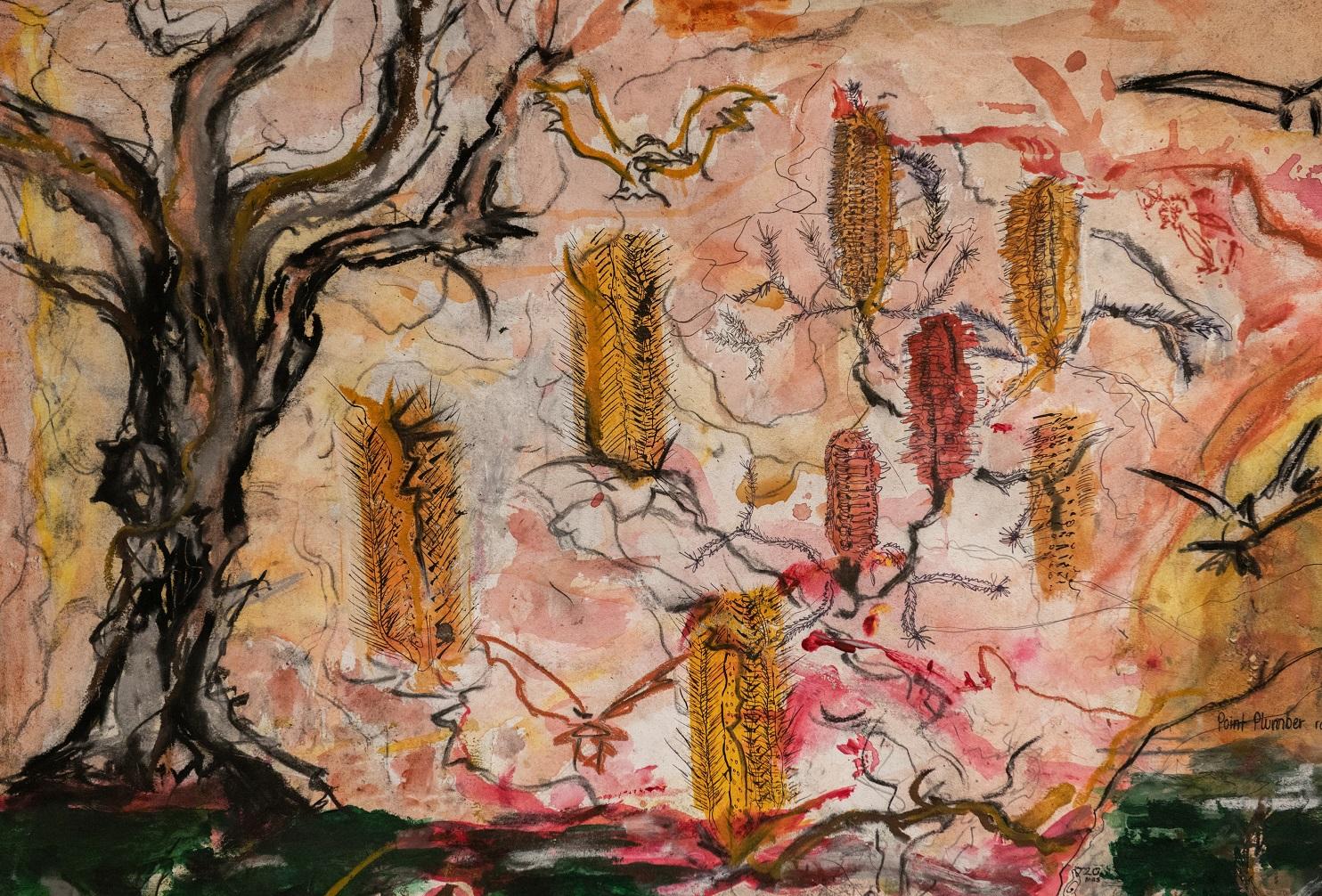
Barrier Story: Broken Hill In 1959
Published by NFSA
Northern Composure Band Competition 2023
Due to the pandemic, Council have had the 20th anniversary on hold but pleased to say that the competition is open and running again.
Northern Composure is the largest and longest-running youth band competition in the area and offers musicians local exposure as well as invaluable stage experience. Bands compete in heats, semi finals and the grand final for a total prize pool of over $15,000.
Over the past 20 years we have had many success stories and now is your chance to join bands such as:
- Ocean Alley
- Lime Cordiale
- Dear Seattle
- What So Not
- The Rions
- Winston Surfshirt
- Crocodylus
And even a Triple J announcer plus a wide range of industry professionals
About the Competition
In 2023, the comp looks a little different.
All bands are invited to enter our heats which will be exclusively run online and voted on by your peers and community by registering below and uploading a video of one song of your choice. (if you are doing a cover, please make sure to credit the original band) We are counting on you to spread the word and get your friends, family, teachers voting for you!
The top 8-12 bands will move on through to our live semi finals with a winner from each moving on to the grand final held during National Youth Week. Not only that but we have raised the age range from 19 to 21 for all those musicians who may have missed out over the past two years.
Key dates
- Voting open for heats: Mon 13 Feb – Sun 26 Feb
- Band Briefing: Mon 6 March, Dee Why PCYC
- Semi 1: Sat 18 March Mona Vale Memorial Hall
- Semi 2: Sat 25 March, YOYOs, Frenchs Forest
- Grand Final: Fri 28 April, Dee Why PCYC
For more information contact Youth Development at youth@northernbeaches.nsw.gov.au or call 8495 5104
Stay in the loop and follow Northern Composure Unplugged on KALOF Facebook.
School Leavers Support
- Download or explore the SLIK here to help guide Your Career.
- School Leavers Information Kit (PDF 5.2MB).
- School Leavers Information Kit (DOCX 0.9MB).
- The SLIK has also been translated into additional languages.
- Download our information booklets if you are rural, regional and remote, Aboriginal or Torres Strait Islander, or living with disability.
- Support for Regional, Rural and Remote School Leavers (PDF 2MB).
- Support for Regional, Rural and Remote School Leavers (DOCX 0.9MB).
- Support for Aboriginal and/or Torres Strait Islander School Leavers (PDF 2MB).
- Support for Aboriginal and/or Torres Strait Islander School Leavers (DOCX 1.1MB).
- Support for School Leavers with Disability (PDF 2MB).
- Support for School Leavers with Disability (DOCX 0.9MB).
- Download the Parents and Guardian’s Guide for School Leavers, which summarises the resources and information available to help you explore all the education, training, and work options available to your young person.
School Leavers Information Service
- navigate the School Leavers Information Kit (SLIK),
- access and use the Your Career website and tools; and
- find relevant support services if needed.
Word Of The Week: Memory
noun
1. the faculty by which the mind stores and remembers information. 2. something remembered from the past. 3. a particular act of recall or recollection. 4. a device (such as a chip) or a component of an electronic device (such as a computer or smartphone) in which information can be inserted and stored and from which it may be extracted when wanted. 5. a capacity for showing effects as the result of past treatment or for returning to a former condition —used especially of a material (such as metal or plastic).
From the Latin memor, meaning “mindful” or “remembering.” The verb remember shares this origin and means “to recall something from memory” or “to try and commit something to memory.” late 13c., "recollection (of someone or something); remembrance, awareness or consciousness (of someone or something)," also "fame, renown, reputation;" from Anglo-French memorie (Old French memoire, 11c., "mind, memory, remembrance; memorial, record") and directly from Latin memoria "memory, remembrance, faculty of remembering," abstract noun from memor "mindful, remembering," from PIE root *(s)mer- (1) "to remember."
Compare Sanskrit smarati "remembers;" Avestan mimara "mindful;" Greek merimna "care, thought," Serbo-Croatian mariti "to care for;" Welsh marth "sadness, anxiety;" Old Norse Mimir, name of the giant who guards the Well of Wisdom; Old English gemimor "known," Dutch mijmeren "to ponder."
memorize (verb). 1590s, "commit to writing, cause to be remembered by writing or inscription;" see memory + -ize. The meaning "commit to memory, learn by heart, keep in memory, have always in mind" is by 1838. Related: Memorized; memorist; memorizing.
Memory is the process of encoding, storing, and retrieving experiences and knowledge, and its many guises. It is hard to overstate the importance of memory. It is what makes us who we are. Some memories are the ones we are aware of – the coffee you enjoyed with a friend, that time as a child when the neighbour’s dog scared you, knowing that spiders have eight legs. These are known as explicit memories – ones we can consciously recall. There are also implicit memories, which may be even more important. For example, when you talk, you’re using motor memories to move your lips and tongue in a way that reproduces sounds you’ve learnt. When you walk, you’re using motor memories to coordinate your gait.
If we didn’t have memories we’d just be a body, unable to communicate or identify danger and – much like a new-born baby – oblivious to how to survive in the world around us. In short, memory is crucial in transforming us from helpless new-borns into capable adults. - UofQ.
Will we eventually have to send our trash into space if we run out of room on Earth?
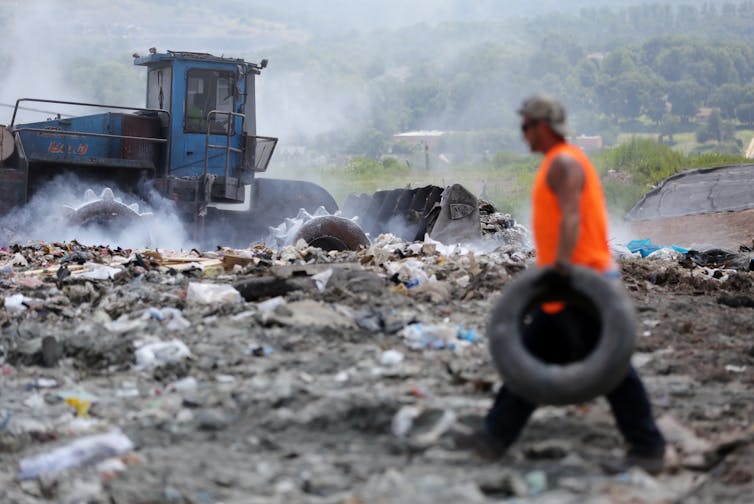

Curious Kids is a series for children of all ages. If you have a question you’d like an expert to answer, send it to curiouskidsus@theconversation.com.
Will we eventually have to send our trash into space if we run out of room on Earth? Aiden, age 13, Maryland Heights, Mo.
Our planet holds a lot of trash. Since the Industrial Revolution, we humans have produced 30 trillion tons of stuff – from skyscrapers and bridges to clothes and plastic bags. Much of it is still with us in the form of waste.
Globally, people add 350 million tons to this total every day. What’s worse, much of the world’s garbage is mismanaged – dumped on land, in waterways and in open dumps in cities and towns. This exposes people to serious health risks. It harms plants and soil, and a lot of waste finds its way into the oceans. Thinking about what a mess we’re making can be pretty overwhelming.
Waste In Space?
Sending trash into space isn’t as off the wall as it might sound. After all, there’s a lot of room out there, with no one – as far as we know today – to claim it.
Some researchers have suggested sending waste into space. They’re mainly thinking about used radioactive fuel rods from nuclear power plants. It’s true that nuclear waste will remain extremely hazardous for tens of thousands of years, and humans have done a lousy job so far of disposing of it safely on Earth.
These proposals, though, have never moved forward, for many reasons. One is the risk: What if a rocket carrying tons of highly radioactive waste exploded on takeoff? Another is the cost, which would be vastly higher than the already high price of storing it safely on Earth.
There is also a lot of “space junk” already orbiting the planet, including broken satellites and meteor debris. NASA estimates there are over half a million pieces the size of a marble or larger in Earth’s orbit. They travel at high speeds, so they can really damage spacecraft in a collision. It wouldn’t be smart to add to this problem.
Here’s a much better strategy: Reduce the amount of waste that goes into landfills, incinerators, open dumps on land and the oceans. Part of that job is up to governments, which set rules on issues like whether to allow single-use plastic bags. But there are many things people can do to reduce waste in their daily lives.
Many Rs
You might be familiar with the “3 Rs of trash”: reduce, reuse, recycle. Each step means less waste at the end of the day.
If you want to reduce waste in your life, choose reusable mugs, cutlery or grocery bags instead of single-use plastic items. Many towns and cities have made this the rule.
Some communities also collect organic wastes, like food scraps and yard trimmings, and turn them into compost – a soil-like material that gardeners and landscapers use as fertilizer. And many gardeners do their own composting at home.
You can reuse by buying secondhand goods and clothes and donating your unwanted but still usable stuff. Freecycle networks make it easy to give away usable items that you don’t need and get different goods in return.
Recycling paper, plastics, glass and aluminum keeps them out of landfills. It also helps to slow climate change, since it can take less energy to make new products from recycled materials. In 2018, nearly one-third of municipal solid waste in the U.S. was either recycled or composted.
Some items, like plastic bags and straws, can be hard to recycle. But aluminum cans, paper, cardboard and certain kinds of plastic are successfully recycled at much higher rates. Knowing what can be recycled where you live, and how to do it, is important – the rules vary a lot from place to place.
There are more than 3 Rs to act on. You can repair, reclaim and reimagine how you buy and use things.
There’s growing discussion about the right to repair – giving consumers access to information and parts so they can repair their own goods, from electronics to cars. Companies would rather have you buy new replacements, but many people are pushing for rules that make it easier to fix your own stuff.
There are many options for reducing waste before space is the only place left to put it. Once you try some, you’ll find it’s easier than you think.
Hello, curious kids! Do you have a question you’d like an expert to answer? Ask an adult to send your question to CuriousKidsUS@theconversation.com. Please tell us your name, age and the city where you live.![]()
Kate O'Neill, Professor of Global Environmental Politics, University of California, Berkeley
This article is republished from The Conversation under a Creative Commons license. Read the original article.
How financial stress can affect your mental health and 5 things that can help

Financial stress is affecting us in many different ways. Some people are struggling to pay bills, feed the family, or maintain a place to live. Others are meeting their basic needs but are dipping into their savings for extras.
Financial stress is increasing and, understandably, is causing some distress. In recent months, Lifeline has seen a rise in the number of calls about financial difficulties.
But understanding and finding ways to reduce our financial stress – and its emotional impact on us – can help make this challenging time a bit easier.
What Is Financial Stress?
If you’re finding it difficult to meet your current expenses or are worried about your current or future finances, you’re under financial stress. Like other types of stress, financial stress has two components:
objective financial difficulty, where you don’t have enough funds to cover necessary expenses or debts
subjective perceptions about your current or future finances, leading to worry and distress.
These two are related. But someone can have trouble meeting their expenses, view this as acceptable, and not be overly worried. Alternatively, someone may be reasonably financially secure but still feel quite stressed about their finances.
Why Are We Feeling It?
There is a broad range of factors that can influence your current level of financial stress. These include contextual and personal ones.
Contextual factors are societal-level influences on the current financial landscape. These include rates of economic growth, market performance, governmental and political policy, and distribution of wealth. These factors may vary across cultures and countries.
Personal factors contributing to stress are unique to each person. For example, demographic characteristics such as age, gender, education and ethnic group may influence someone’s access to financial resources.
Other personal factors that can affect financial stress are financial literacy and practices, personality traits that influence behaviour and perceptions, and major life events with financial implications (such as marriage, having a child, or retiring).

The Health Impacts Can Be Severe
High levels of financial stress can impact people’s wellbeing, raising levels of psychological distress, anxiety and depression.
A review found clear evidence for a link between financial stress and depression, and that the risk for depression was greatest for people on low incomes.
A large survey of adults in the United States also found that greater financial worries were associated with more psychological distress. This was especially the case for people who were unmarried, unemployed, had lower income levels and who were renters.
So people who are more vulnerable financially – in an objective sense – are also most likely to experience negative psychological effects from financial stress.
However, the perception of your financial situation matters here too. In one study of older adults, including Australians, it was not just someone’s financial situation that was linked to their wellbeing, but also how satisfied people were with their wealth.
Severe financial stressors, such as being forced to sell your home if unable to meet mortgage payments, can affect both psychological and physical health.
What Can I Do About It?
While we can’t change the broader financial landscape or some aspects of our financial situation, there are some simple ways to help reduce financial stress and its impacts.
1. Take small steps
Try to identify elements of your finances you can improve and act on some of them, even if they are small steps. This may include creating and following a budget, cutting some extra costs, applying for available financial assistance, getting quotes for more affordable utilities or insurance, or contemplating a career change. Even little changes can improve your financial state over time. Taking action in a difficult situation can improve wellbeing by giving you a greater sense of agency.
2. Check your take on the situation
Examine your perspective. Are you often seeing the negative aspects of your situation but ignoring the positive ones? Are you worrying a lot about very unlikely catastrophes far off in the future? It’s worth checking whether your perceptions about your financial situation are accurate and balanced.
3. Don’t be too hard on yourself
Your financial state does not reflect your value as a person, and over-identifying with your financial status can lead to further stress. Financial difficulties are the result of many factors, only some of which are under your control. Reminding yourself that your finances do not define you as a person can reduce feelings of sadness, shame or guilt.
4. Take care of yourself
It’s draining dealing with ongoing financial stress. So focus on self-care and coping strategies that have helped you with past stressors. This may mean taking some time out to relax, deep breathing or meditation, talking with others and doing some things for fun. Giving yourself permission to take this time can improve your mood, perspective and wellbeing.
5. Ask for help
If you are struggling financially or psychologically, seek help. This may take the form of financial advice or assistance to reduce financial difficulties. If you notice yourself feeling persistently down, anxious, or hopeless, reach out to friends or family and get help from a mental health professional.
If this article has raised issues for you, or if you’re concerned about someone you know, call Lifeline on 13 11 14.![]()
Kristin Naragon-Gainey, Associate Professor, School of Psychological Science, and Director, Emotional Wellbeing Lab, The University of Western Australia
This article is republished from The Conversation under a Creative Commons license. Read the original article.
Astronomers just discovered a comet that could be brighter than most stars when we see it next year. Or will it?

Hot on the heels of the disappointing Green Comet, astronomers have just discovered a new comet with the potential to be next year’s big story – C/2023 A3 (Tsuchinshan-ATLAS).
Although it is still more than 18 months from its closest approach to Earth and the Sun, comet Tsuchinshan-ATLAS already has social media buzzing, with optimistic articles being written about how it could be a spectacular sight. What’s the full story on this new icy wanderer?
Introducing Comet C/2023 A3 (Tsuchinshan-ATLAS)
Every year, a few dozen new comets are discovered – dirty snowballs moving on highly elongated paths around the Sun. The vast majority are far too faint to see with the unaided eye. Perhaps one comet per year will approach the edge of naked-eye visibility.
Occasionally, however, a much brighter comet will come along. Because comets are things of ephemeral and transient beauty, the discovery of a comet with potential always leads to excitement.
Comet C/2023 A3 (Tsuchinshan-ATLAS) certainly fits the bill. Discovered independently by astronomers at Purple Mountain Observatory in China and the Asteroid Terrestrical-impact Last Alert System, ATLAS, the comet is currently between the orbits of Jupiter and Saturn, a billion kilometres from Earth. It is falling inwards, moving on an orbit that will bring it to within 59 million kilometres of the Sun in September 2024.
The fact the comet was found while it’s so far away is part of the reason for astronomers’ excitement. Although currently some 60,000 times too faint to see with the naked eye, the comet is bright for something so far from the Sun. And observations suggest it’s following an orbit that could allow it to become truly spectacular.
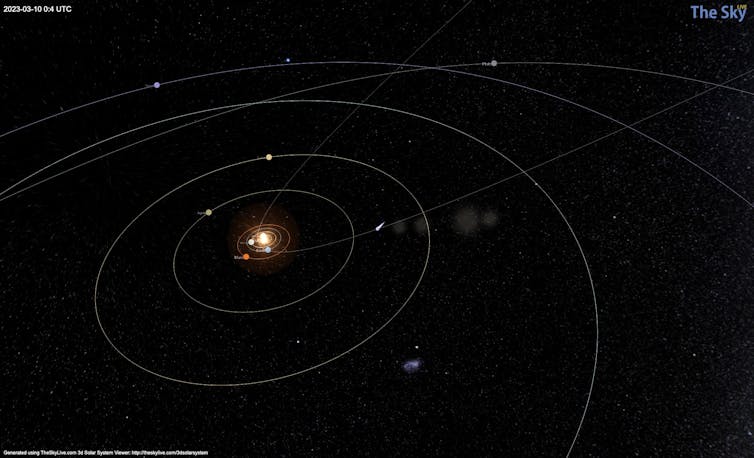
A Recipe For Comet Greatness
It’s all down to a combination of the comet’s path through the Solar System, and the potential size of its nucleus – the solid centre.
As comets swing closer to the Sun, they heat up, and their surface ices sublime (turn from a solid to a gas). Erupting from the comet’s surface, this gas carries along dust, shrouding the nucleus in what’s called a coma – a giant cloud of gas and dust. The coma is then pushed away from the Sun by solar wind, resulting in a tail (or tails) pointing directly away from the Sun.
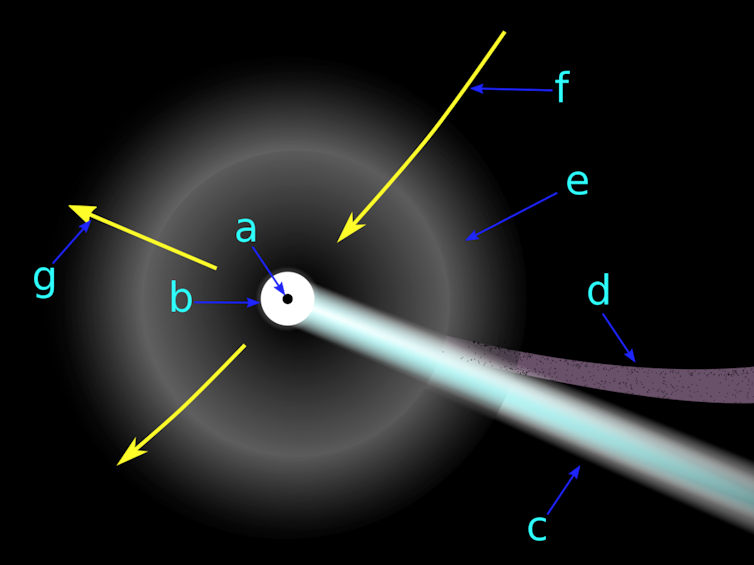
The closer a comet gets to the Sun, the hotter its surface becomes, and the more active it will get. Historically, the vast majority of the brightest, most spectacular comets have followed orbits that brought them closer to the Sun than Earth’s orbit. The closer, the better, and Tsuchinshan-ATLAS certainly ticks that box.
In fact, this new comet seems to tick all the boxes. It appears to have a sizeable nucleus, making it brighter (bright enough to be discovered so far from the Sun). It is destined to have a very close encounter with our star. And, the kicker, it will then pass almost directly between Earth and the Sun, approaching within 70 million kilometres of us just two weeks after perihelion (the closest approach to the Sun). The closer a comet comes to Earth, the brighter it will appear to us.
Put that together, and you have a recipe for a comet that could shine as brightly as the brightest stars. Some forecasts are even more bullish, suggesting it could be up to a hundred times brighter still!
The Curse Of Prediction
Comets are like cats: they have tails, and they do precisely what they want – astronomer David H. Levy.
Predicting how newly discovered comets will behave is a dangerous game. Some may be spectacular, while others fizzle.
Take, for example, comet Kohoutek, in 1973. Like Tsuchinshan-ATLAS, Kohoutek was discovered unusually far from the Sun, moving on an orbit that swung close to our star. Cue the hype. Astronomers promised the public “the comet of the century”, predicting Kohoutek could become bright enough to see in broad daylight.
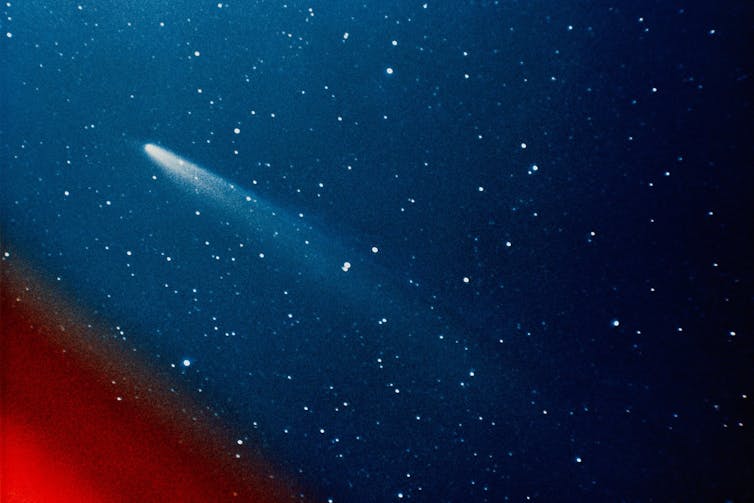
But comets are like cats. Kohoutek brightened as it swung in towards the Sun, but more slowly than expected. Rather than being visible in broad daylight, it was only as bright as the brightest stars, and faded quickly after perihelion. It was still a good show, but far from the comet of the century. Because of the hype, many dubbed Kohoutek a spectacular disappointment.
It turns out Kohoutek was passing through the inner Solar System for the very first time. It had never come so close to the Sun, so its surface was rich in highly volatile ice which began to sublime when the comet was still far away. At that great distance, the comet was much brighter than other, more experienced comets – and that brightness suggested the comet would be truly spectacular.
As it came closer to the Sun, those volatiles were exhausted, and the comet’s final activity was less than initially predicted, making it fainter.
There is a very real chance Tsuchinshan-ATLAS might, like comet Kohoutek, be approaching the inner Solar System for the first time. We’re not yet sure – but if it is, it might also wind up being less spectacular than predicted.
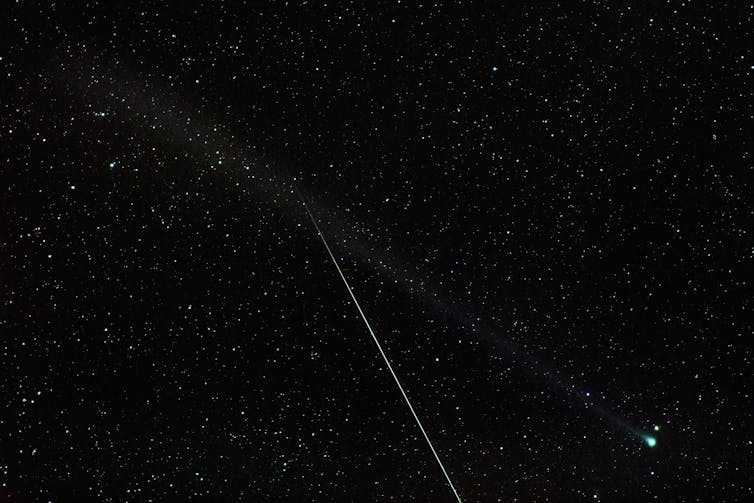
Where It All Falls Apart
But it could be even worse. Comets are prone to disaster. They fragment, fall apart, and disintegrate surprisingly often. Those coming into the inner Solar System for the first time are particularly fragile.
A recent example of such a fragmentation was comet C/2020 F8 (SWAN). When SWAN was discovered, it looked promising – likely to become a naked-eye object in May 2020. But as it approached the Sun, it suddenly brightened, then became fuzzy, and began to fade away. By the time it should have been brightest, it had all but disappeared, having fallen apart before our very eyes.

On the flip side, fragmentation events can sometimes turn a good comet into a great one. Three years after Kohoutek came comet C/1975 V1 (West), and it was truly spectacular.
It passed even closer to the Sun than Tsuchinshan-ATLAS will – and was already dazzling when, at perihelion, its nucleus broke into four pieces. That fragmentation event released a huge amount of gas and dust, and the comet brightened markedly, even becoming visible in broad daylight.
Will Tsuchinshan-ATLAS Be Worth The Anticipation?
We won’t know for certain whether comet Tsuchinshan-ATLAS will be a spectacle until it arrives. It could fall apart and become less bright, or it could surprise us.
It could brighten more than expected – which would make for an amazing sight in the morning sky in late September and early October 2024, and an even better one in the evening sky in mid-October 2024
We just don’t know. But we’ll get our first hints in the months to come. By tracking how the comet brightens as it glides sunwards, we will get our first indications as to its true fate – so keep your fingers crossed.![]()
Jonti Horner, Professor (Astrophysics), University of Southern Queensland
This article is republished from The Conversation under a Creative Commons license. Read the original article.
The full credit list featured at the beginning of Tár is a nod to the hidden hierarchies of labour in screen production

In a recent interview on her portrayal of a renowned (fictional) female conductor, the autocratic maestro Lydia Tár, Cate Blanchett noted ways in which orchestral music-making is not a democratic enterprise. Neither is film-making.
Written, directed and produced by Todd Field, the film courted controversy for situating a woman as the power-play sexual predator in a post-Weinstein world. At the start of the film, or even before the start, audiences noted something else distinctive about the film: that the full screen credit list, attributing the labour of the production, came before the film proper.
More specifically, Tár obliges its audience to patiently sit through a full three minutes of opening credits. This is a big ask, in the age of streaming media where audiences embrace the “skip” function (for opening credits) and where end credits rush by at an unfathomable pace, arguably creating invisibility of the creative labour of the screen production.
A Democracy Of Credits
Far from the trend to lavish, expensive, opening credit sequences, the screen credits for Tár are a sombre experience and materialise in small, white typography on a black screen, which gently fade in and out, set to a minimal musical score.
They are non-dynamic to the point that this slow-burning, 180-second credit sequence won’t find its way onto YouTube (unless to make a thematic point). In one sense, the style of the credits are uneventful. But they also present an opportunity for an audience to consider the history of screen credits, and the way in which this particular creative choice foreshadows the story of Lydia Tár to come.
In his Oscar-nominated screenplay, Field (unusually) spelled out his desire to return the end credits to the start of this film. His screenplay notes:
Punctuating credits filling a single black frame. One after the other, side-by-side, like players seated on a cramped stage.
To return to Blanchett’s quote above, Field appears to want to reinstate a democracy of credits, to represent the large-scale shared creative labour of screen production.
In an interview Field said “I wanted to recalibrate the viewer’s expectations about hierarchy.”
The Labour Of Film Production
Field’s creative decision has a historical precedent, in the 1963 French feature film Contempt by the late Jean-Luc Godard.
In place of typographic opening credits, Godard narrates the labour of the film production, with his own voice, an exercise in Brechtian-inspired reflexivity, to make transparent the ways in which a film work arrives to an audience.
Interestingly, Godard retains the “possessory” film credit of “a film by” – something that Field rescinded, taking the more didactic (yet less dominant) “written, directed and produced by”. Field had to convince the producers that the extended end-credits-as-opening-credits would not be audience-unfriendly, in an attention-distracted world.
In Tár, the hierarchy is inverted: Field appears last, after the three-minute “communal” credits sequence. In making his decision to invert the hierarchy of the behind-the-scenes power relations, Field attempted to (from the outset) draw the viewer’s attention to the primary investigation of the film: the power relations on screen.
In consideration of the hierarchy, or signification of power within a screen production, of screen credits – this has been both culturally and historically determined. In early (silent) cinema, before the medium was highly industrialised, film roles remained shared, undefined or ambiguous.
As the motion picture industry advanced to become a highly managed creative realm, a stricter demarcation and hierarchy of roles followed.

A Return To The Past
The opening credit roll of Tár is not new – it represents a return to the past.
For much of the 20th century, there was only opening film credits, with the end credit being simply, and literally, marked “The End”. Relatively soon, a template for screen credits was in situ, which signalled a clear hierarchy of labour “above the line” (producers, screenwriters, director, major actors) which took the prominence of the opening credits, with the “below the line” creative crew and production support labour relegated to the end credits, in small font as a closing credit roll.
For example, a film’s cinematographer typically sits below the line even though they make a significant contribution to the visual storytelling and authorship of the film. And, invisibly to audiences, screen credits also determine the copyright provisions for a film work.
Next time you’re in the cinema, look around as the end credits roll. It’s mostly industry people, cinephiles or film students who stick around to the very end.
Even once the hierarchy of screen credits had been generally agreed for the placement and order of screen credits, it remained contested territory.
George Lucas attracted a hefty fine from the Directors Guild of America for omitting the role of the films’ directors for Star Wars (1977) and The Empire Strikes Back (1980). Lucas resigned and the rest is history – his spatialised prose sequence set to the famous John Williams score claimed its place as a core aspect of the Star Wars story-verse.
In the opening credits for Pulp Fiction (1995), the screenwriting is credited to “Stories By: Quentin Tarantino & Roger Avary”, who shared the Academy Award for Best Original Screenplay on stage. But behind the scenes, Avary was paid out to enable the (then) new auteur to maintain the possessive credit of “A film by Quentin Tarantino”.
In more recent times, the rise of the episodic streaming television “showrunner” has displaced the possessive screen credit of the auteur director, to a more generic “created by”. The story of the hidden, or not so hidden, hierarchies of labour in screen production is to be continued.![]()
Alex Munt, Associate Professor, Media Arts & Production, University of Technology Sydney
This article is republished from The Conversation under a Creative Commons license. Read the original article.
Winning everything everywhere all at once: 5 experts on the big moments at the Oscars 2023

The Academy Awards in 2023 were a less scandalous affair than last year – although host Jimmy Kimmel never let us forget “the slap”, with so many jokes it was verging on a dead-horse-beating situation.
In fact it was a relatively wholesome ceremony, defined by great sweeps for films All Quiet On The Western Front and Everything Everywhere All At Once. Perhaps the only “shock” was Angela Bassett losing Best Supporting Actress to Jamie Lee Curtis, and thereby being denied the chance to “do the thing”.
Here, we summarise the most important moments from the 2023 Oscars.
All The Looks Of The Champagne Carpet
Deborah Fisher, Lecturer in Design and Fashion Studies, School of Business and Creative Industries, University of the Sunshine Coast
The Oscars 2023 red-carpet fashions will spur a rush of activity as the haute couture and designer looks are rapidly reproduced for the knockoff market.
The pillars of European Haute Couture were well represented. The major players such as Louis Vuitton (Cate Blanchett, Ana de Armas), Armani Privé (Nicole Kidman), Dior Haute Couture (Michelle Yeoh), Valentino (Florence Pugh), Prada (Catherine Martin), Atelier Versace (Lady Gaga), floated across the carpet with all the feel of Paris fashion week.
There was, however, an obvious absence of emerging or avant-garde designers or even American designers. Instead, it would be fair to say there was an abundance of understated looks, with shades of soft ecru and off-white dominating (Halle Berry, Michelle Williams, Emily Blunt, Tems). Where there was colour, it was delectable- mid-toned aqua (Halle Bailey in Dolce & Gabbana), citrusy orange (Sandra Oh in Giambattista Valli), chartreuse (Winnie Harlow in Atelier Versace), palpable purple (Angela Bassett in Moschino).
Red (note the carpet was renamed champagne) got a solid look in with Melissa McCarthy, Anni Strenisko, and Cara Delavinge, who stunned in Elie Saab. The men followed the mostly conservative mood, with Austin Butler and Lenny Kravitz in Saint Laurent, Keith Urban and Ke Huy Quan in Armani Privé, and Paul Mescal in Gucci. Questlove, last year’s Best Documentary winner, adorned his Crocs with sparkles and bling so he could “shine his light,” perhaps the most personalised of the men’s sartorial stories.
And of course, there are some looks that will, although they should not, be copied – Sigourney Weaver’s somewhat matronly Givenchy dress and Eva Longoria’s art deco-inspired, but far too ambitious gown by Zuhair Murad.
Keeping The Score
Gregory Camp, Senior Lecturer, University of Auckland School of Music
There was a sore lack of good music throughout this year’s ceremony.
I miss the days of the orchestra pit. The orchestra this year was invisible, other than a few short shots of them leading into commercial breaks and during the Best Original Score announcement. They appeared to be in a conference room somewhere backstage; just because one can pipe in a remote orchestra fairly easily doesn’t mean one should. And despite the fact there was a live orchestra (somewhere), most of the music sounded prerecorded, as it was mixed in a flat, lossy way.
The music clips chosen to accompany the presenters’ and winners’ walks to and from the stage were not very exciting. We heard a lot of a very dull looping motive from Everything Everywhere All at Once as members of its team went to collect their well-deserved awards.
It is possible to write music that is immediately noticeable and interesting; just ask John Williams, who can fit more melodic material into two bars than this whole ceremony had in all its incidental music. All Quiet on the Western Front’s repeating minor triad is at least memorable, although I was surprised it beat Williams’ and Justin Hurwitz’s stronger work for The Fabelmans and Babylon, respectively, to win the Best Score award.
The Best Song nominees this year were uniformly poor, aside from Naatu Naatu, which did its job well and justifiably won the award. Applause from Tell It Like a Woman was really terrible, a surprisingly ineffective song from Oscar stronghold Diane Warren. This Is a Life from Everything Everywhere was also an awful song, but it added a much-needed touch of the bizarre to this slick ceremony.
Naatu Naatu was the only musical moment that brought back something of the Oscars’ glamour of yore. This is one of the first songs from song-rich Indian cinema to break through to the Oscars, but we can hope that it will pave the way for more.
Lady Gaga had a rough start with her Top Gun song Hold My Hand, suffering through some poor vocal intonation, but she warmed into it. Considering this is a film awards show, the poor cinematography for this performance was striking: Gaga was in an overly tight shot and the camera operator had a hard time keeping this very active performer in the frame. That said, I liked the simplicity of the setting for the song, the strong backlighting isolating her and her band in the space and making the large stage seem more intimate.
Rihanna gave a good performance of another lacklustre number, Wakanda Forever’s Lift Me Up. The downbeat, repetitive song didn’t allow her to show very much of her range. This all makes one desperate for a return of the likes of Henry Mancini and Randy Newman to this category.
Brendan Fraser And Best Actor
Ari Mattes, Lecturer in Communications and Media, University of Notre Dame Australia
With his Oscar win for Best Actor for The Whale, Brendan Fraser simply proves something most of us have known all along – he’s a great performer. If anyone had any doubts, they simply needed to watch performances across his career, from Encino Man to Gods and Monsters to his comical cameo as himself in Dickie Roberts: Former Child Star.
His performance in The Whale is fine, and good enough to win the Oscar, but again the win reflects popular sensibilities rather than being a measure of true artistic merit. It’s essentially an easy part in an easily digestible film from a director, Darren Aronofsky, who’s made a career of making genre films that seem more interesting and complex than they actually are.
He returns here, with Fraser, to similar terrain he covered with Mickey Rourke in The Wrestler – getting a performance out of a supposedly washed-up actor that, at least in part, reflects the courage of the actor in appearing warts and all – willingly vulnerable and hopeless.

I reiterate, Fraser is good (as he was in Airheads, although he wasn’t nominated for Best Actor for that performance), but so much of the pathos and energy of the film simply comes from his appearance – and our knowledge that Fraser used to be a Hollywood heartthrob.
And there’s something fundamentally lazy about that.
Michelle Yeoh And Best Actress In A Leading Role
Jindan Ni, Lecturer, Global and Language Studies, RMIT University
Everything Everywhere All at Once became the biggest winner at the 95th Academy Awards – surprising, but also not so surprising. Cast mainly by Asian actors and actresses, this strangely (sometimes even disturbingly) funny but also moving comedy won most of the major awards, including Best Leading Actress and Best Director.
Michelle Yeoh, who is now the first Asian actor to win Best Actress, addressed her acceptance speech directly to “the little boys and girls” who look like herself, and proudly claimed that her winning is “the beacon of hope and possibility” for all the Asians who pursue their dreams in Hollywood, or even more broadly, in Western societies with a long history of deeming Asians as inferior.
The sweeping wins of Everything Everywhere All At Once at the Oscars is a manifestation of reconciliation and inclusiveness that the Academy Awards are attempting to embrace and strive for.

Despite its historical winnings at the Academy Awards, it is hard to say that Everything Everywhere All At Once has successfully managed to make new representations of Asian in the big screen. Yeoh still needed to make good use of her Kung fu skills in the movie to appeal to the audience and the market.
The final thing I would like to add is although Cate Blanchett did not win Best Actress, her formidable and awe-inspiring acting in Tár is by no means inferior.

Just like the nickname “da mowang”, literally meaning “the mighty devil”, the Chinese audience has given to Cate, her powerful and almost enigmatic performance in Tár also tells of the infinite possibilities for women who refuse to be defined by age, which largely resonate with Yeoh’s words: “Ladies, don’t ever let anyone tell you you are past your prime.”
Celebrity Legacy At The Oscars
Robert Boucaut, PhD Candidate and Tutor, Media Department, University of Adelaide
The choice of winners for the acting categories at the 2023 Oscars speaks to a respect for building celebrity legacy – all are actors over 50 years of age and on their first-ever nominations.
Despite the backlash copped in the year of the nepo-baby, Jamie Lee Curtis used her speech to thank her dedicated fanbase who have championed her work in action and horror movies.
Fraser and Ke Huy Quan’s outpourings of emotion for their wins signified their deeply felt triumphs over years of uncertainty in filmmaking: an Oscar’s “comeback narrative” always highlights how an industrial status quo works against individuals who fall out of favour in a celebrity marketplace.

And the collectively held breath across film Twitter upon the announcement of Halle Berry presenting the Best Actress award was finally relaxed with Michelle Yeoh’s win – the first woman of colour to win the award presented it to the second, 21 years later.
Across the awards season both Yeoh and Quan demonstrated an acute awareness of the significance their wins would hold as Asian actors, and their speeches invited the audience to dream big. The genuine emotion offered and elicited across all four categories were a refreshing rebuttal for an Oscars cynic, that the symbolic power of these awards can be put in service of expanding notions of prestige acting and celebrity.

The Best Picture? Or Was It
Ari Mattes
The production companies behind Everything Everywhere All at Once must be frothing at the mouth – not only have they cleaned up at the box office, making (by conservative estimates) five times their budget, but their film has now won the Best Picture Oscar.
Does it deserve it? In much of the commentary around the film, moral and aesthetic categories are being confused. It is good that it has won, because it’s an independent production, and it’s nice that a film with Chinese actors in it has won. But this is a moral argument.
Although undeniably a crowd-pleaser, I found the film aesthetically drab. It was overlong, a mess of ideas derived from other (and often better) works, and the whole thing was overlaid with a kind of irritatingly cutesy schtick.
It works okay as a 1980s-style blockbuster, but as a piece of cinema it is doubtful it will have any bearing or longevity in the cultural archive.
Was it actually the best picture of 2022? No – there were six better films nominated for the award, with The Banshees of Inisherin a true cinematic masterpiece – not to mention all the excellent films that had no showing in the Oscars.
What its win does suggest (along with the success of Top Gun: Maverick), is that audiences are craving nostalgic cinema that plays well on the big screen. And this will excite the kinds of mega-corporations that produce indie cinema these days – they can simply recycle and combine material from their VHS collection.![]()
Ari Mattes, Lecturer in Communications and Media, University of Notre Dame Australia; Deborah Fisher, Design/Fashion Studies in School of Business & Creative Industries, University of the Sunshine Coast; Gregory Camp, Senior Lecturer, University of Auckland; Jindan Ni, Lecturer, Global and Language Studies, RMIT University, and Robert Boucaut, PhD Candidate & Tutor, Media Department, University of Adelaide
This article is republished from The Conversation under a Creative Commons license. Read the original article.
Why does music bring back memories? What the science says

You’re walking down a busy street on your way to work. You pass a busker playing a song you haven’t heard in years. Now suddenly, instead of noticing all the goings on in the city around you, you’re mentally reliving the first time you heard the song. Hearing that piece of music takes you right back to where you were, who you were with and the feelings associated with that memory.
This experience – when music brings back memories of events, people and places from our past – is known as a music-evoked autobiographical memory. And it’s a common experience.
It often occurs as an involuntary memory. That is, we make no effort to try to recall such memories, they just come to mind spontaneously.
Research has recently begun to uncover why music appears to be such a good cue for invoking memories. First, music tends to accompany many distinctive life events, such as proms, graduations, weddings and funerals, so it can play an important role in reconnecting us with these self-defining moments.
Music also often captures our attention, due to the way it affects our minds, bodies and emotions.
When music draws our attention, this increases the likelihood that it will be encoded in memory together with details of a life event. And this then means it is able to serve as an effective cue for remembering this event years later.
Positive Memories
In recent research my colleague and I found that the emotional nature of a piece of music is an important factor in how it serves as a memory cue.
We compared music with other emotional memory cues that had been rated by a large group of participants as conveying the same emotional expression as the music excerpts we used. This included comparing music with “emotional sounds”, such as nature and factory noises and “emotional words”, such as “money” and “tornado”.

When compared with these emotionally matched cues, the music didn’t elicit any more memories than the words. But what we did find was that music evoked more consistently positive memories than other emotional sounds and words. This was especially the case for negative emotional stimuli. Specifically, sad and angry music evoked more positive memories than sad and angry sounds or words.
It seems then that music appears to have the ability to reconnect us with emotionally positive moments from our pasts. This suggests that using music therapeutically may be particularly fruitful.
How And When
The familiarity of a piece of music also, perhaps unsurprisingly, plays a role. In another recent study, we found that more familiar music evokes more memories and brings memories to mind more spontaneously.
So part of the reason music may be a more effective cue for memories than, for instance, our favourite film or favourite book, is that we typically reengage with songs more often over our lifetimes compared to films, books or TV shows.
The situations when we listen to music may also play a role. Previous research shows that involuntary memories are more likely to come back during activities where our mind is free to wander to thoughts about our past. These activities tend to be non-demanding in terms of our attention and include things like commuting, travelling, housework and relaxing.
These types of activities align almost perfectly with those recorded in another study where we asked participants to keep a diary and note when music evoked a memory, along with what they were doing at the time it happened. We found that daily activities that often go hand in hand with listening to music – such as travelling, doing chores or going for a run – tend to lead to more involuntary memories in the first place.

This contrasts with other hobbies, such as watching TV, which can require our mind to be more focused on the activity at hand and so less likely to wander to scenarios from our past.
It seems then that music is not only good at evoking memories but also the times when we are more likely to listen to music are the times when our minds may naturally be more likely to wander anyway.
Music is also present during many life events that are distinctive, emotional or self-defining – and these types of memories tend to be more easily recalled.
Indeed, the power of music to connect us with our past shows how music, memories and emotions are all linked – and it seems certain songs can act as a direct line to our younger selves.![]()
Kelly Jakubowski, Assistant Professor in Music Psychology, Durham University
This article is republished from The Conversation under a Creative Commons license. Read the original article.
A brief history of the UK’s Winchcombe meteorite
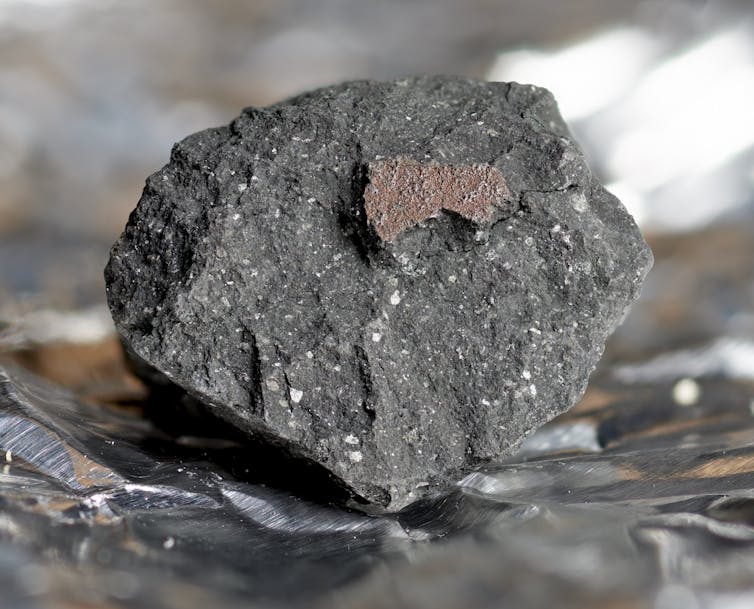
On 28 February 2021, for the first time in 30 years, a meteorite fell in the UK and was later recovered by scientists. Today, there’s an international effort to study this space rock and learn more about its place in the early solar system.
This meteorite is named after Winchcombe, the town in Gloucestershire where several fragments were recovered – including a piece that landed on the driveway of a family home.
The meteorite formed 4.5 billion years ago in the distant outer solar system, beyond the orbit of Jupiter. We refer to such objects as primitive because they contain some of the earliest solid material to form in our cosmic neighbourhood, offering insights into a time when our solar system was in its infancy.
Over time, much of this solid material merged to form larger objects, which eventually led to the emergence of planets. Some of the early building blocks that avoided being consumed in this process of planetary assembly are present today as asteroids or even smaller objects. The Winchcombe meteorite is just such a celestial body.
Some of these free-roaming planetary building blocks may have been responsible for delivering water to the early Earth. Therefore, Winchcombe can provide a glimpse into the activity of water on solid bodies in the ancient solar system.
Path Through Space
Winchcombe is a rare type of meteorite known as a CM chondrite. These meteorites are characterised by high concentrations of water and organic matter (molecules with chains of carbon atoms), both of which are essential ingredients for the emergence of life.
We know the path through space that the Winchcombe object took – its orbit – before it fell to Earth. It is one of only five primitive, water-bearing chondrites for which scientists have this information. Knowing its orbit means we can pinpoint where in the solar system it came from.
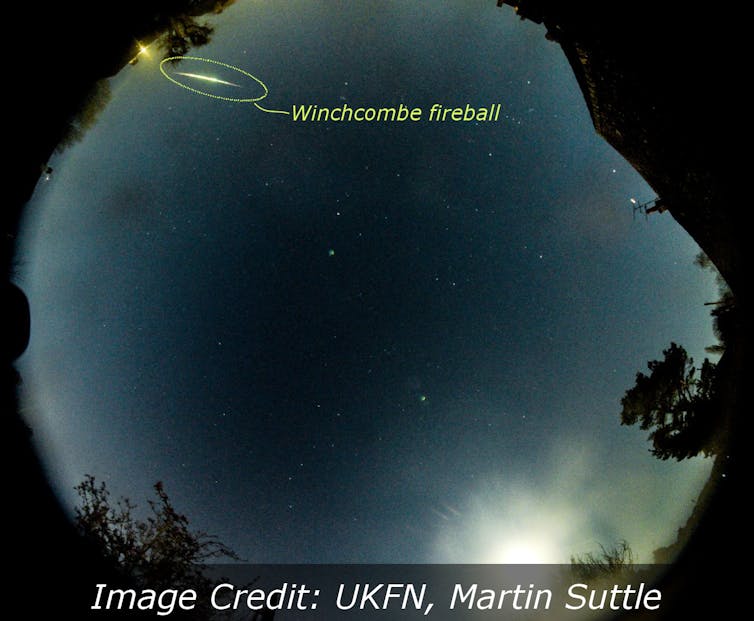
The pieces of this meteorite were recovered very rapidly – within 12 hours of arriving on Earth. This means there was little time for water from Earth’s atmosphere to react with and contaminate the meteorite. Taken together with the meteorite’s rarity, primitive characteristics and distant origin, its swift recovery makes the object an ideal candidate for studying the role of asteroids in the early solar system.
The meteorite was probably once part of a larger asteroid. But looking at pieces of the Winchcombe object under the microscope, it quickly became clear that it is not one rock but many –- a complex mix of fragments loosely held together. This structure is the result of collisions between larger asteroids in space.
The debris field created by the collision subsequently merged to form a new population of smaller second-generation asteroids referred to as rubble-pile objects because of their loose, blocky configuration. Winchcombe came from one of these rubble-pile bodies – fragmented remains of the diverse rocky objects that existed in the age before planets.
Space Mud
Each rock fragment that makes up the Winchcombe meteorite records a distinct history, revealing, for example, differences in the amount of water it interacted with, and implying that the parent asteroid had a complex structure.
These observations point to either variable amounts of water on that parent body, which condensed as ice as the asteroid grew, or the uneven flow of water through the asteroid. When space rocks come into contact with liquid water they begin to change, forming an unusual form of dark black, fine-grained “space mud”.
Researchers from across the world jump at the chance to study these minerals because they hold, inside their crystal structure, molecules of the original water that flowed on these asteroids.
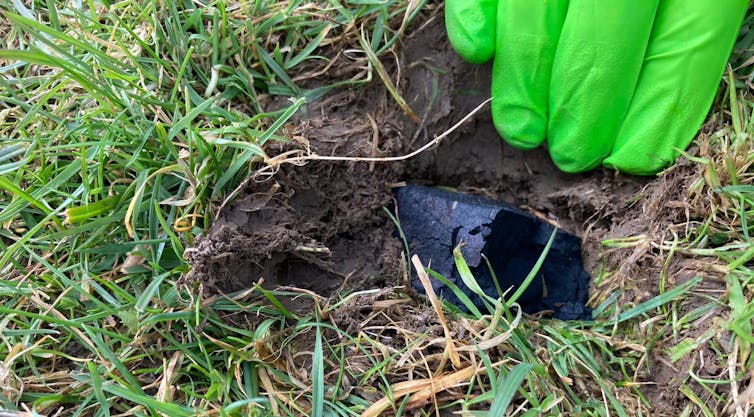
A group of scientists accurately measured the different isotopes (or chemical forms) of the hydrogen present in Winchcombe. Along with oxygen, hydrogen is one of the two chemical elements in water. The scientists’ findings demonstrated that water contained within the meteorite is very similar to the water on Earth.
This strengthens a theory that asteroids played a critical role in delivering water to the early Earth and thereby generating the oceans we see today.
Catastrophic Collision
At some point, chemical reactions between water and rock were halted by the catastrophic collision with another asteroid. This event shattered the meteorite’s parent body. Most of the rock fragments in the Winchcombe meteorite are very small, less than 1mm in size. This pattern of small pieces is evidence of the high-energy collision but also the signature of a weak asteroid.
As our understanding of planetary building blocks grows, we are increasingly recognising that the types of planetary bodies represented by the Winchcombe meteorite no longer exist in their original form.
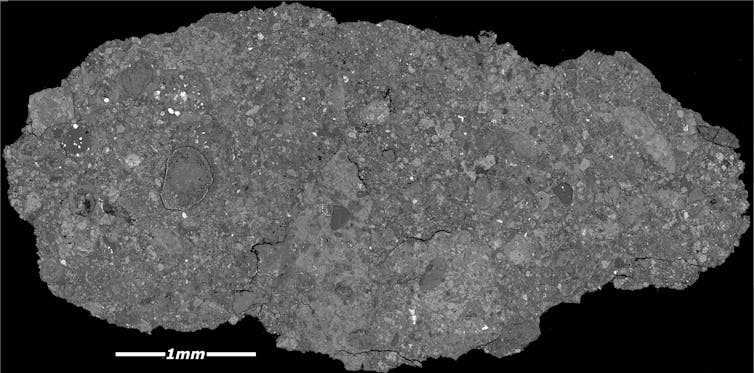
Most, if not all, small asteroids (those measuring less than 10km in diameter) are likely to be rubble-pile bodies. Winchcombe is a relic from that time and a testament to the fate of most asteroids. We can summarise their history in a few simple words: hot and wet, then smashed to rubble.
Studying Winchcombe has also helped us to understand how these types of meteorites break-up in the atmosphere and, therefore, why they are rarely found as large rocks.
Research on Winchcombe continues and there are many more science questions that we hope to answer. One particularly interesting study relates to the type and amount of organic matter within Winchcombe and whether organic matter delivered by meteorites played a role in the supply of nutrients – food, essentially – for the emerging life on Earth.![]()
Martin D. Suttle, Lecturer in Planetary Science, The Open University
This article is republished from The Conversation under a Creative Commons license. Read the original article.
Were there gladiators in Roman Britain? An expert reviews the evidence

In 1853, a Roman vase was found being used as a container for ashes in a grave outside Roman Colchester. Dating to the later second century AD, it depicted four gladiators with their names scratched into the surface of the vase.
Two of the gladiators, Memnon and Valentinus, were shown as the classic pairing of a lightly armed but nimble retiarius (net man) and heavily armed but cumbersome secutor (pursuer). The retiatius, Valentinus, has lost his weapon – a trident – and holds up his finger as a sign of submission.
Long thought to be an import, fabric analysis has now shown the vessel to be of local manufacture. The ashes the vessel contained were of a male of about 40 years of age and not of local origin. Could he have been a gladiator?
Gladiators are one of the emblematic images of the Roman world. Massive amphitheatres, depictions of gladiators in Roman art and literature and more recent portrayals such as Russell Crowe’s portrayal of the Roman general-turned-fighter, Maximus Decimus Meridius in the film Gladiator (2000) have all contributed to the perception of blood and gore, crowd frenzy, Christians and lions, the caprices of emperors.
The origins of gladiatorial spectacle go back to the Roman Republic (the ancient state centred on the city of Rome founded in 509BC), where it was originally associated with funeral games for prominent men. Gladiators represented a propitiatory blood offering, skirting close to being a form of human sacrifice.
By the second century BC, gladiators had become professionals, forming corporations under a lanista (trainer). Normally selected from prisoners of war, criminals and slaves, they had little if any social standing. Nevertheless, as the Colchester vase shows, they could become celebrities and could be awarded the rudis (a wooden sword signifying freedom).

Gladiatorial weapons training was introduced to the Roman army and thereafter there was a strong link between soldiers and gladiatorial games. Many amphitheatres in the European provinces were built at colonies of military veterans (coloniae), meaning they became part of the monumental equipment of Roman-style cities in the empire and beyond.
So the construction of amphitheatres and the staging of gladiatorial games in a province such as Britain shows the local populations buying into this aspect of Roman cultural values as sponsors and as spectators.
Most amphitheatres in Britain were not constructed in stone, but were instead large banks of earth carrying timber seating, a little like American “bleachers”, either side of an elliptical arena with entrances at either end. Large examples such as that at Cirencester could have sat several thousand people. They showed off the assimilation to Roman ways of the local nobles who financed their construction and the games.
Gladiatorial combat’s strong links with the army explains why the two major stone amphitheatres in Britain were at the legionary fortresses of Chester and Caerleon. Colchester was a colony for military veterans, so an amphitheatre there would be expected, though archaeologists have not yet located one.
Evidence Of Gladiators In Britain
More tangible evidence of the gladiators themselves in Britain is harder to come by. But some recent discoveries allow us to flesh out the picture.
There must have been an amphitheatre at the long-lived, legionary fortress of York, but it is yet to be discovered. Excavations between 2004 and 2005 at York’s Driffield Terrace uncovered 82 Roman burials and 14 cremations dating largely to the third century.
The sex and age profile of the buried bodies was very unusual. They were almost all males and aged from their late teens to their early forties.
These men were generally taller and more robust than the average male burial from Roman Britain. Evidence suggested that they had geographically more varied origins than men from Roman York in general.
Extraordinarily, more than half of the men had been decapitated, the skull placed in the grave with the corpse.
How to interpret them? Given that the age range is that for service in the Roman army, one hypothesis was that they were soldiers executed for serious offences. But further research has shown evidence that they suffered blunt force trauma, often to the head. Could they have been gladiators?
Intriguingly, the pelvis of one of the men has indentations consistent with the bite of a large carnivore. Perhaps an instance of the Roman capital punishment of damnatio ad bestias – being thrown to the beasts in the arena.
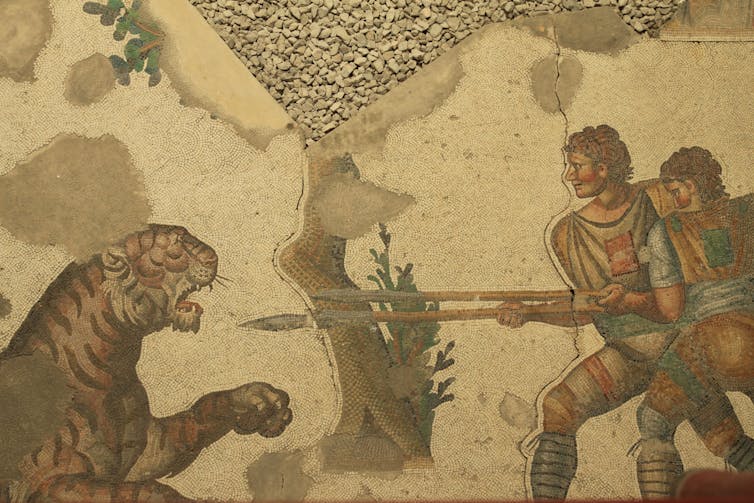
Occasionally, other finds suggest an interest in gladiatorial combat in Britain. Three mosaics from villas in Sussex, Kent and the Isle of Wight show gladiators, but since at one site this entailed cupids dressed as gladiators, these were probably just artistic conventions rather than representations of Roman British reality.
More convincingly, pieces of pottery with representations of gladiators have been recovered from both Chester and Cirencester – both places with amphitheatres. These were in red gloss pottery mass produced in present-day France. Perhaps they were imported as souvenirs for people attending gladiatorial spectacles.
Other objects show the hold of gladiators on the popular imagination, such as an ivory clasp knife handle showing a gladiator from the Roman fort at South Shields.
It seems that by the fourth century AD the amphitheatres in Roman Britain were falling into disuse as cultural tastes shifted. But as the Colchester vase has shown, people in Roman Britain – at least for a time – viewed gladiators as celebrities, not unlike modern day sports stars.![]()
Simon Esmonde Cleary, Emeritus Professor of Roman Archaeology, University of Birmingham
This article is republished from The Conversation under a Creative Commons license. Read the original article.
Back To Beechworth: The Ideal Town
Newtown Sydney
I helped write the Productivity Commission’s 5-year productivity review: here’s what I think Australia should do
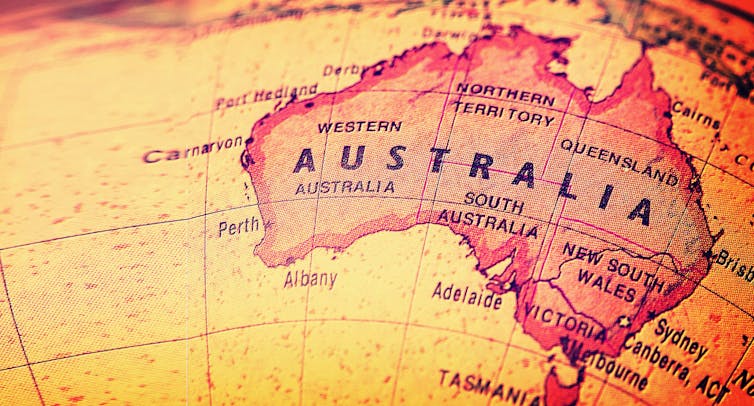
Australia is a living testament to the benefits of productivity growth.
An average worker today puts in 14 fewer hours per week and takes home a real wage six times that of the average worker in 1901 – all because we are producing more per hour worked.
And yet in the past decade that rate of improvement has slowed.
Over the 60 years to 2019-20, labour productivity (production per hour worked) grew at an average of 1.8% per year, which sounds small but compounds each year.
In the most recent of those decades, the decade to 2020, growth fell to just 1.1% – a drop of one-third.
If it remains that low we will be much worse off in decades to come than we would be if we could get back to the kind of growth we had.
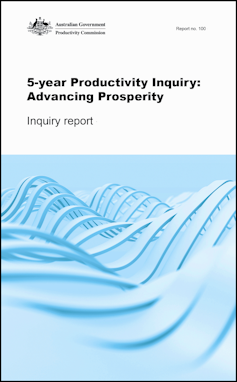
That’s one of the reasons I was excited to work on the Productivity Commission’s second five-yearly productivity report, released today by Treasurer Jim Chalmers.
Victims Of Our Own Success
In some ways, Australia has been a victim of its success. It has a robust and highly productive economy, especially in mining and agriculture where it is among the world’s leaders.
But, as productivity growth in mining and agriculture has made us wealthier, we have demanded more services, such as holidays, housecleaning, childcare and after-school care, gyms and home-delivered food.
Now employing 90% of our workers and accounting for 80% of our economy, services are harder to make more productive, and as our population ages they are likely to account for an even greater share of what we do.
In government-funded non-market services such as health, education and public administration, measured labour productivity growth has been close to zero since the turn of the century.
If we want to continue to improve our standard of living, we are going to have to tackle productivity in services as well as in goods, including in human services that are usually provided off market by the government.
How To Improve
Our report tackles the problem over nine volumes and 964 pages, coming up with 29 “reform directives” and 71 specific recommendations.
It focuses on five key themes:
building a skilled and adaptable workforce
harnessing data and digital technology and diffusing new ideas
creating a more dynamic economy
lifting productivity in the non-market sector
securing net zero carbon emissions at least cost
I’ll give you a taste of our recommendations across three of these themes.
The uptake of telehealth and video conferencing during the pandemic shows how technology can improve productivity and increase access to services. We will need to better leverage these digital technologies, particularly in non-market services such as education and public administration.

Digital services need a strong and ubiquitous internet, covering all of the population, including the population in regional Australia. But Infrastructure Australia has found 23 of the 48 regions in Australia have broadband and mobile connectivity gaps.
In health, better connections can save lives. We need to fill the gaps using the mix of technology that will best allow all Australians to benefit from the digital connectivity revolution.
Data is also crucial. We need better linking of data to improve government-funded services and better rules around cybersecurity to protect that data.
Focus On Outcomes Rather Than Inputs
Too often, government funding rules for health, education, public housing and other services focus on inputs (the funding delivered) rather than outcomes (the service delivered).
These rules limit innovations in service delivery that would boost productivity and benefit consumers. The rules need to be more flexible to allow increased innovation, working out what works and spreading best practice to all providers, while ensuring consumer safety.
A more productive economy will increasingly need a more adaptable and better-trained workforce. Most of the new jobs created in the next five years will require tertiary qualifications, particularly university qualifications.
To meet this demand we will need to both better “educate our own” and target our migration system to fill skills gaps.
A Road Map For Reform
This is the Productivity Commission’s second five-yearly productivity report.
The first made explicit that productivity was not about extracting more sweat from the brow of an already hard-working Australian, but was instead about
promoting better investment in workplaces
supporting the research and trialling of new ideas
removing outmoded regulations that prevent consumers and businesses obtaining better services
This report builds on the first to provide a road map, focusing first on the high-impact low-cost reforms. Some are quick and others will take time and planning.
All will face opposition. Vested interests benefit by exploiting economic inefficiencies for their own gain. Without reform, we will all be poorer.![]()
Stephen King, Professor, Monash University
This article is republished from The Conversation under a Creative Commons license. Read the original article.
Applications Now Open For Inaugural $10,000 Military History Prize
About The Warfarin Shortage 2023

Nazi orders for Jews to wear a star were hateful, but far from unique – a historian traces the long history of antisemitic badges

Growing up in Belgium, I’d hear the story of how my grandparents married during the Nazi occupation. It was not a time for celebrations, particularly for Jewish families like theirs. Naively, though, they thought marriage would protect them from being separated should they be deported. So in June 1942, they went to city hall with their loved ones – “decorated,” as my grandmother would say, with yellow stars.
Hearing that story as a child, I imagined them in dark clothes with shiny stars, each one a human Christmas tree – a celebratory image that only existed in my brain. Her most vivid memory of that day were the looks in people’s eyes: stares of curiosity, pity and contempt. The yellow star had transformed them, in onlookers’ eyes, from joyous newlyweds into miserable Jews.
Decades later, I completed a Ph.D. on the history of forcing Jewish people to wear a badge. My grandmother called to congratulate me – and, I soon understood, to unburden herself of a story she’d never told before.
When the Nazis issued the law forcing Jewish Belgians to wear a yellow star in May 1942, my grandmother’s future father-in-law declared that he would not wear it. The whole family tried to persuade him otherwise, fearing the consequences. But it was in vain, and in the end, my grandmother stitched the star on his coat.
I could hear her voice trembling on the phone as she told me she still could not forgive herself. Their wedding two weeks later would be the last time she saw him: He died in 1945 after being released from a transit camp and a detention home for elderly Jews, spending two years in terrible conditions.
Although the yellow badge has come to symbolize Nazi cruelty, it was not an original idea. For many centuries, communities throughout Europe had forced Jewish residents to mark themselves.
Yellow Wheels And Pointed Hats
In lands under Muslim rule, non-Muslims had been required to wear identifying marks since the Pact of Umar, a ruling attributed to a seventh-century caliph, though scholars believe it originated later. These were usually a yellow belt, called “zunnar,” or a yellow turban.
In Europe, forced markings for Jews and Muslims were introduced by Pope Innocent III at the Fourth Lateran Council in 1215. The pope explained that it was a means to prevent Christians from having sex with Jews and Muslims, thereby protecting society from “such prohibited intercourse.”
However, the pope did not specify how Jews’ or Muslims’ dress had to be different, resulting in various distinguishing signs. Ways to make Jews visible in the cities and towns of medieval Europe abounded: from yellow wheels in France, blue stripes in Sicily, yellow pointed hats in Germany and red capes in Hungary to white badges shaped like the Ten Commandments tablets in England. Since there were no large Muslim communities in Europe at the time, except for Spain, the regulation only applied to Jews in practice.

In northern Italy, Jews had to wear a yellow, round badge in the 15th century and a yellow hat in the 16th century. The reason typically given was that they were unrecognizable from the rest of the population. For Christian authorities, unmarked Jews were like gambling, drinking and prostitution: All represented the moral failings of Renaissance society and needed to be fixed.
Pretext For Persecution
However, as I explain in my book, Jews were often arrested for not wearing the yellow badge or hat, sometimes while traveling away from home in places where no one knew them.
Clearly, then, Jews were recognizable from Christians in other ways. The true aim of forcing Jews to wear emblems was not merely to “identify” them, as authorities claimed, but to target them.
My research showed that laws imposing a badge or hat functioned as means to threaten and extort Jewish communities. Jews were willing to pay considerable sums to retract such laws or soften their provisions. For example, Jews requested exemptions for women, children or travelers. When communal negotiations failed, wealthy individual Jews tried to negotiate for themselves and their families.

Badge laws were frequently reissued, which has led scholars to conclude that their enforcement was inconsistent; after all, a legal directive that is steadily applied does not need to be reimposed. But with the risk of arrest and extortion hanging over the heads of Jewish communities, and their willingness to pay or negotiate to avoid these consequences, badge laws had adverse effects on Jewish life even when not enforced.
In the Duchy of Piedmont in modern-day Italy, for example, Jewish communities banded together to pay additional taxes, sometimes several times in the same year, to receive exemptions from wearing the Jewish badge. Although the Jews’ cohesion was remarkable, it had a high cost, as these communities ended up ruined and leaving the duchy.
When Italian Jews asked authorities to cancel or at least amend badge laws, they were not primarily worried about being recognized as Jews. The problem was being mocked or attacked. Violence had accompanied badge laws since their inception: Just a few years later, Pope Innocent III wrote to French bishops that they needed to take every possible measure to ensure that the badge did not expose the Jews to the “danger of loss of life.”
Yet harassment continued. Sometime in the 1560s, for example, the governor of Milan received a a letter from Lazarino Pugieto and Moyses Fereves, bankers from Genoa, explaining that bandits had robbed them after recognizing them as Jews. In 1572, Raffaele Carmini and Lazaro Levi, representatives of the communities of Pavia and Cremona, wrote that when Jews wore the yellow hat, youngsters attacked and insulted them. And in 1595, David Sacerdote, a successful musician from Monferrato, complained that he could not play with other musicians when wearing a yellow hat.
‘In The Past, No One Noticed Me’
Centuries later, the yellow star had the same effect.
Max Jacob, a French-Jewish artist and poet, wrote of experiencing a vision of Christ, and he converted to Christianity in 1909. During the Nazi occupation of France, he was nonetheless classified as a Jew and forced to wear the yellow star.

In the prose poem “Love of the Neighbor,” he wrote about the deep shame he experienced.
“Who saw the toad cross the street?” he asked. No one had noticed it, despite his clownish, grimy appearance and weak leg. “In the past, no one noticed me in the street either,” Jacob added, “but now kids mock my yellow star. Happy toad! you do not have a yellow star.”
The Nazi context differed significantly from Renaissance Italy’s: There were no negotiations or exceptions, not even for large payments. But the mockery by children, the loss of status, and the shame remained.![]()
Flora Cassen, Chair and Associate Professor of Jewish, Islamic, and Middle Eastern Studies, Washington University in St Louis
This article is republished from The Conversation under a Creative Commons license. Read the original article.
The Village Chef By Meals On Wheels
How Gardening Can Uproot Dementia Stigma
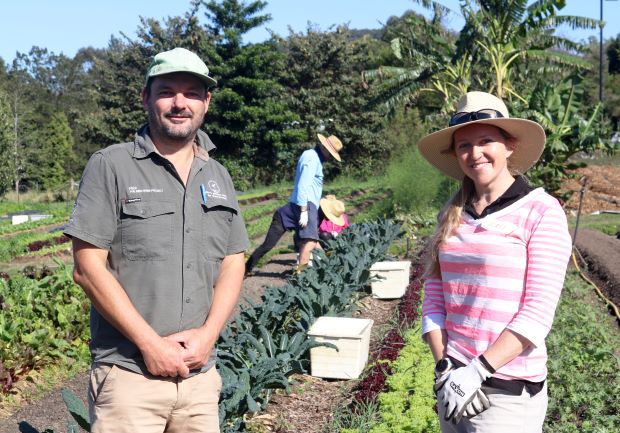
Are flu cases already 100 times higher than last year? Here’s what we really know about the 2023 flu season

Alarming headlines and media coverage have said we’ve had 100 times as many influenza cases in the first two months of 2023 compared with the same time the previous year.
The coverage suggested we’re in for a bumper flu season, starting early and your best protection was to get a flu vaccine, when available.
But that scary sounding 100 figure is misleading. Here’s what’s behind the figures and what we can really expect from the 2023 flu season.
Comparing Apples With Oranges
In the first two months of 2023, there were 8,474 laboratory-confirmed cases of influenza. In 2022, over the same period, there were 79 cases.
So it might seem this year’s figures are indeed more than 100 times higher than last year’s. But we shouldn’t be alarmed. That’s because in early 2022, influenza cases were artificially low.
Strict COVID measures almost eliminated influenza outbreaks in 2020 and 2021. Shutting international borders, quarantining, social distancing and mask-wearing stopped influenza coming into the country and spreading.
Many COVID restrictions weren’t relaxed until late February/March 2022. So, in January and February of that year there were fewer opportunities for us to mingle and spread the influenza virus. It’s hardly surprising there were few cases then.
In fact, the rate of flu in 2023 is actually very similar to pre-COVID years (that is before 2020).
As always, the reported cases represent just a fraction of the actual influenza cases. That’s because many people do not seek medical care when infected with influenza or their GP doesn’t always test them for it.
How About An Earlier Flu Season?
Every year, it seems, influenza throws a new curve ball making predictions tricky.
Flu rates in the northern hemisphere largely peaked in December 2022, two months earlier than usual.
But there has been some late-season influenza B activity in the northern hemisphere this year. This is one type of influenza that causes seasonal flu. So travellers arriving/returning from the northern hemisphere have been bringing influenza to Australia for several months.

So we expect more cases of influenza. Australia may even have an autumn surge. This occurred last year, where influenza cases rose sharply in May, and peaked by June. That’s two months earlier than the five-year average pre-COVID.
Before COVID, influenza cases usually began to rise in April/May. This progressed to a full epidemic from June to August, often extending into September, before waning in October.
So What Can We Expect In 2023?
The start, length and severity of influenza seasons vary and are often unpredictable.
Community immunity will be less than in pre-COVID times. That’s because of fewer influenza infections during COVID restrictions plus lower influenza vaccine uptake in recent years.
So the 2023 flu season may be at least moderately severe. This remains speculation. Flu routinely surprises us.
The severity of the coming Australian influenza season will be influenced by the types of influenza that circulate, when the surge starts and when the season peaks. The effectiveness, uptake and timing of vaccinations and the degree of remaining herd immunity will all be important.
Plan To Get Vaccinated
Only about 40% of those eligible were vaccinated against influenza in 2022, according to the Australian Immunisation Register database. Rates were highest in people aged 65 or older.
However, as we saw an early influenza season in 2022 (peaking in May/June) this meant many Australians were not vaccinated during the early stages of the epidemic.
With this knowledge, it’s important to be vaccinated in April/May before influenza becomes common.
Now is a good time to start preparing to get your flu vaccine. Ask your GP or pharmacist when you can book yourself in.
Vaccination is our best defence against influenza and is recommended from the age of 6 months. Younger infants receive protection if their mum was vaccinated during pregnancy.
The 2023 vaccine has been updated to protect against more recently circulating strains. There are also different types of influenza vaccine, some more effective in elderly people, some free under the National Immunisation Program, some not. Other vaccines are available for people with egg allergies and for small children. It’s best to discuss the vaccine options with your GP or pharmacist.![]()
Robert Booy, Hon Prof, Dept of Child & Adolescent Health, University of Sydney and Ian Barr, Deputy Director, WHO Collaborating Centre for Reference and Research on Influenza
This article is republished from The Conversation under a Creative Commons license. Read the original article.
Politics with Michelle Grattan: Chair of Retirement Income Review, Mike Callaghan, on reforming superannuation
Michelle Grattan, University of CanberraTreasurer Jim Chalmers sparked a political row when he announced a tax hike on superannuation concessions for accounts with balances over $3 million, from 15% to 30%, to begin in 2025. Polling indicates the move has broad support from the public, although any change to super is always controversial. Opposition leader Peter Dutton has promised the change would be reversed by a Coalition government.
Mike Callaghan, a former treasury official, chaired the Retirement Income Review that was handed to the Morrison government in 2020.
Callaghan sees the Chalmers’ change to super as “an important step”.
“I think one of the most encouraging things is the fact that this issue regarding equity and sustainability of superannuation, and the measure, has taken place now because it’s a very controversial topic […] The fact that we have seen movement is very encouraging.”
“There’s a lot more that needs to be done in terms of improving the equity and sustainability of the retirement income system and superannuation in particular.
"The unfortunate thing is, given the controversy around it, it might kerb enthusiasm […] towards some more significant changes for some time. That could be the downside of this.”
The superannuation tax concessions are skewed heavily towards higher income earners. Observers have noted that superannuation has become an inheritance vehicle in many cases. Ageing Australians are passing their assets to family rather than using the “nest egg” for their retirement. Callaghan sees this as a “significant issue”.
“It’s fine if people want to leave an inheritance to their children, but what we’re seeing now is that’s not generally a conscious decision of people. We’re seeing across the system now, people not drawing [superannuation savings] down to use them for the intended purpose, which was to support the standard of living in retirement.
"The problem is […] that people don’t know what to do to make the best use of the assets they have in retirement. A lot of it is ignorance, a lot of it is confusion, a lot of it is that having a savings mentality has been drummed into them. Build up your nest egg. Don’t spend your nest egg.”
People need advice to navigate the system “and they’re not getting the advice. The biggest deficiency we’ve seen that’s leading to this outcome, I think, is that people don’t get advice. I think it’s about only 10% of retirees actually get advice entering retirement.
"They need a positive push that they do need advice. When you see the surveys of why people don’t get advice, they say ‘it’s too costly’ and they say, ‘but I don’t have that big financial asset, so I’m not one that has that need for financial advice’. There’s the other one of lack of trust.”
Home ownership is a major factor in what life will be like for retirees. “If you own your own house, you don’t have to pay rent and you have a substantial asset […] that you can draw on to support your retirement.”
But Callaghan doesn’t think younger people should be able to access their super for a house deposit. “While [having a home is] important, solving the problem of helping first home owners get into housing is not going to be solved by tweaks to the superannuation system. It’s not going to achieve its objective at all, as many people say, it’s likely to just add extra pressure to house prices and there is a cost, this very significant cost to the individual of letting them access superannuation.”![]()
Michelle Grattan, Professorial Fellow, University of Canberra
This article is republished from The Conversation under a Creative Commons license. Read the original article.
Carers of older Australians need more support – but we found unpaid extended leave isn’t the best solution

Aged care is being hit both ways by the ageing of Australia’s population. While population ageing is increasing the number of Australians in need of formal care, it’s also reducing the proportion of working age people able to provide formal care.
To help bridge the gap, we are going to need to make it easier for working age Australians to provide informal care for parents and partners living at home.
The Royal Commission into Aged Care Quality and Safety suggested a way. In 2021, it asked the government to examine requiring employers to offer unpaid extended leave for carers of older Australians.
In February 2022 the government asked the Productivity Commission to conduct the examination. I was one of the two commissioners appointed to lead it, and last week we released our position paper.
Here’s what we found, and how you can have your say.
Growing Demand For Informal Care
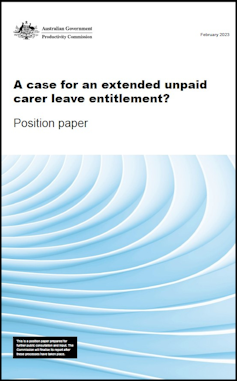
We discovered there’s a lot of informal care already. Most older Australians who require assistance get it through informal care – 62% according to the Australian Bureau of Statistics.
About half of this informal care is provided by partners, about 30% by daughters, and 24% by sons.
Calculations by Deloitte Access Economics suggest if this informal care was charged for, it would cost A$78 billion per year. But it is set to become more scarce.
As more people live longer, the needs of the oldest Australians will grow and become harder to manage without considerable support. And as families become smaller, there will be fewer family members to help.
Deloitte Access expects the need for informal care to grow by 23% to 2030, while the number of informal carers grows only 16%.
Examining Extended Unpaid Carer’s Leave
When my father was diagnosed with dementia, I was incredibly lucky to have ample leave balances, his wife as his primary carer, and the resources to privately pay for formal care while we waited for a government-provided home care package.
But many aren’t that lucky. Many carers state that they have unmet needs for leave, financial assistance, physical assistance and respite.
The National Employment Standards applying to workers covered by the Fair Work Act require employers to offer 10 days per year of paid carer leave, which is bundled with sick and personal leave and accumulates when not used, as well as “up to two days per episode” of unpaid leave.
In addition, workers can take up to two days of compassionate leave when an immediate member of the family or household dies or develops a life-threatening illness. This is paid for permanent employers and unpaid for casual workers.
Many employers offer more. But what’s missing from the legislative requirements is unpaid extended carers leave, available for months rather than days.
It is available for new parents. The legislative requirement is 12 months of unpaid leave, with the right to request an additional 12 months.
But after much investigation, we found that extending the option to the carers of older Australians would do little to close the care gap, little to help the majority of carers, and little to keep carers in the workforce.
Few People Would Use It
The model we developed based on parental and other leave standards (and the need to avoid undesirable consequences) provided three to 12 months of unpaid leave for carers of older people who have worked for at least 12 months for their current employer, after giving four weeks’ notice.
We found between 7,000 to 17,000 employees would use it each year, less than 0.1% of the workforce.
About half of those who used the entitlement would have provided care anyway, leaving their jobs if necessary.
We estimated it would produce only 4,000 to 8,000 extra informal carers.
And many don’t want unpaid extended leave. What they told us they want is workplace flexibility, with the income and relief from caring it offers.
That said, mandated extended unpaid leave would benefit the older people who would be cared for, and would benefit the carers who took it, reducing their costs of searching for a job after their extended absences.
But it would impose costs on employers: disrupting workplaces, requiring the recruitment of new temporary staff, and leaving employers uncertain about which of their workers would stay.
For businesses with high turnover of relatively unskilled labour, these costs would be low. In more specialised businesses, the limited evidence (mainly from parental leave) suggests these costs would be significant.
We Need Carers To Know Their New Rights
The good news for carers is that changes to the Fair Work Act due to begin in June will strengthen employees’ rights to request flexible work.
Under the amendments, employers will only be permitted to refuse requests for flexible work if they have:
discussed the request with the employee
genuinely tried to reach an arrangement
not been able to come to an agreement
considered the consequence to the employee of refusing the request for flexible work, and
a reasonable business grounds for refusing the request.
The government should ensure that carers are aware of these and other rights through its Carer Gateway.
It should also ensure informal carers get support from the formal sector, with formal carers available to provide care at times and in ways informal carers cannot.
Informal Care Needs Formal Support
Waiting lists for formal home care packages at one stage climbed to 15 months in some categories and have come down considerably, but there is more to be done in reducing waiting lists.
Carers also need access to respite care for the older Australians they care for, to give them a break, especially respite care in the home.
And they need support for a wider range of relationships.
Carers can usually only access leave to care for immediate family members or members of their households. This excludes broader kinship networks for Aboriginal and Torres Strait Islander people, care relationships in “families of choice” for LGBTI seniors, and care for aunties and close friends.
We can do more to support carers. I was personally lucky to get a good deal of support. We ought to make sure we are all that lucky.
You can make a written submission on the carer’s leave paper until March 28. You can also register here to watch online or attend the March 20 and 21 public hearings.![]()
Catherine de Fontenay, Honorary Fellow, Department of Economics, The University of Melbourne
This article is republished from The Conversation under a Creative Commons license. Read the original article.
Post apocalypse: the end of daily letter deliveries is in sight
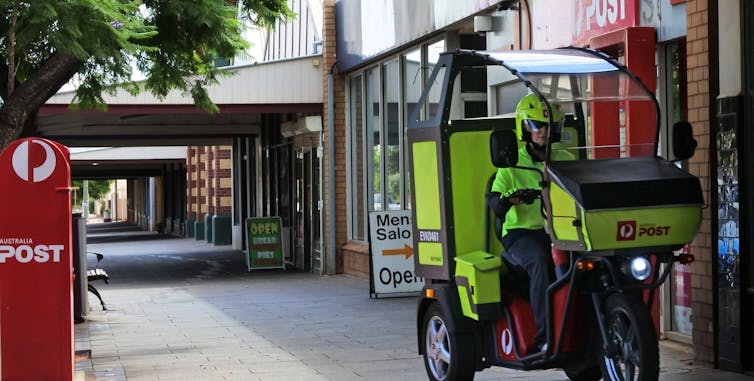
Australia Post is seeing red. A lot of it.
After posting a razor-thin profit of $23.6 million in the last six months of 2022, it anticipates a loss for the full 2022-23 financial year – only the second time since being corporatised in 1989.
The last loss was in 2014-15, following a $190 million investment in “transformational reform” of Australia Post’s letters business. At the time, it expressed confidence those efficiency improvements would allow it “to maintain a five-day-a-week delivery”. Now it is pessimistic. With the ongoing collapse in demand for letter delivery, it sees only more losses ahead.
That’s a huge problem, because Australia Post has two main obligations, enshrined in federal legislation. It is required to operate on commercial principles – that is, the federal government wants it to deliver a dividend – while also meeting strict community service obligations.
Those obligations – established in 1989 and last reviewed in 2019 – require delivering letters to 98% of all Australian addresses five days a week, and in more remote areas to 99.7% of addresses at least twice a week, generally within two days of posting.
The Morrison government temporarily relaxed those obligations between May 2020 and June 2021 so Australia Post could divert resources to its parcel delivery services as online shopping boomed during the pandemic. Now the organisation wants those community service obligations reduced permanently.
Cost Of Service Obligations
Meeting the obligations cost $348.5 million in 2021-22, says a federal government discussion paper on “postal services modernisation” published this month. It says they “are no longer financially sustainable and are not well targeted at the needs of Australians due to changes brought about by the digitisation of the economy”.
It’s hard to disagree. The numbers are incontrovertible. The hundreds of millions of dollars a year being lost on letter delivery will only get bigger. People just don’t need a daily postal service like they used to.
In The Red, And Dying
In the 2021-22 financial year, Australia Post made a slim profit of $55 million on revenues of $8.97 billion. That’s a 0.6% profit margin, far below the 8.5% average within the transport services sector.
The surplus was due only to its parcel-delivery business, which grew about 12% in 2021-22 after four years of growing at more than 20%. Letters now account for less than 20% of Australia Post’s revenue.
The discussion paper notes letter volumes in Australia is now less than half what they were in 2008. This is not as severe as countries such as New Zealand or Denmark, but worse than Germany, Japan, the United States and the United Kingdom.
Declines in postal organisation letter volumes
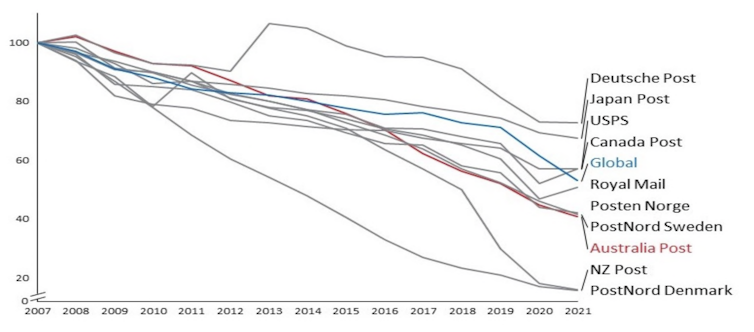
Government agencies and businesses now account for 97% of mail sent. Overall volume will decline as they move to cheaper, more efficient online methods. Even major postal events like election campaigns are likely to disappear, with postal voting replaced by digital technology.
What Can Be Done?
The discussion paper flags a range of possible responses.
One is to charge higher prices. Britain’s Royal Mail, for example, has raised postage prices by 64% over the past five years.
Australia Post increased the rate for standard letter delivery from A$1.10 to A$1.20 in January, which the discussion paper notes is significantly less than the average of $2.08 for OECD countries.
Higher prices may boost profit for a year or two, but in the longer term will just accelerate the transition to non-postal methods.
Another option is investing in more efficient sorting technology, particularly automation. The French and German postal services are doing this. But Australia Post has already made huge investments in efficiencies, and doing more will cost the federal government money – something it won’t want to do given the budget position.
What About Local Post Offices?
Another option is to reduce Australia Post’s network of post offices, of which there are more than 4,300. This number is tied to another community service obligation: that no one live further than 2.5km from a post office in a metropolitan area, or 7.5km in a non-metropolitan area.
The discussion paper notes Australia has more post offices than supermarkets. They cost $1.3 billion to operate in 2021-22.
These provide posting, pickup, banking, transaction and retail services. But their need is diminishing as all things are progressively digitised. An argument could be made that some, at least in metropolitan areas, could be replaced with smart lockers for parcel pick-up.
But that’s likely to be politically contentious, with less financial gain, than the most obvious choice – to scrap the community service obligation to deliver post five days a week.
New Zealand’s postal service did this in 2013, moving to delivery every other day. Sweden did so in 2020 as a trial, with the intention of making it permanent.
Some will miss the daily service. But most of us won’t. As the relaxation to deliveries every second day showed during the COVID period, it is likely most people won’t even notice.![]()
Paul Alexander, Adjunct Associate Professor of Supply Chain Management, Curtin University
This article is republished from The Conversation under a Creative Commons license. Read the original article.
CSIRO Study Uncovers Cystic Fibrosis Screening Limitations

Attracting Stem Cells And Facilitating Bone Regeneration By Adhesive Protein
Changing Landscapes Alter Disease-Scapes

Scientists Identify Substance That May Have Sparked Life On Earth

Dim Lights Before Bedtime To Reduce Risk Of Gestational Diabetes New Study Advises
Genes In Beans: Bean Genome Sequenced For Improved Nutrition

Mediterranean Diet The Best Prevention Against Prostate Cancer
Is menopause making me put on weight? No, but it’s complicated

It’s a question people ask often: does menopause cause weight gain?
Women commonly put on weight as they enter menopause. Research shows women aged 46-57 gain an average of 2.1kg over five years.
But like many things related to weight, all is not what it seems, and the relationship between menopause and weight gain is not straightforward.
Here’s everything you need to know about menopausal weight gain and what you can do about it.
What Typically Happens To Women’s Bodies During Menopause?
Menopause marks the natural end of the reproductive stage of a woman’s life. It officially starts when a woman has not menstruated for 12 months, and most women reach menopause between the ages of 45 and 55, but it can happen much earlier or later.
The transition to menopause, however, typically starts four years prior, with perimenopause marking the time when a woman’s ovaries start slowing down, producing less oestrogen and progesterone. Eventually, these hormone levels fall to a point at which the ovaries stop releasing eggs and menstruation stops.
The symptoms associated with the menopausal transition are many and varied, and can include irregular periods, breast pain, vaginal dryness, hot flashes, night sweats, fatigue, difficulty sleeping, and changes in mood and libido.
So Does Menopause Cause Weight Gain?
The short answer is no. But it’s complicated.
When it comes to menopause and weight, it’s weight redistribution – not weight gain – that is actually a symptom. Research has confirmed menopause is linked to an increase in belly fat but not an increase in overall weight.
This is because the hormonal changes experienced during menopause only prompt a change in where the body stores fat, making women’s stomachs and waists more prone to weight gain. Research shows visceral fat (deep belly fat) increases by nearly 50% in postmenopausal women, compared with premenopausal women.
It’s also important to recognise some menopause symptoms may indirectly contribute to weight gain:
sleep issues can lead to sleep deprivation, disturbing the body’s appetite hormones, increasing feelings of hunger and triggering food cravings
some mood changes can activate the body’s stress responses, increasing the production of the hormone cortisol, promoting fat storage and triggering unhealthy food cravings. Mood can also impact the motivation to exercise
fatigue, breast pain and hot flushes can make physical activity challenging or uncomfortable, also impacting the ability to exercise.

The Truth? Ageing Is The Real Cause Of Menopausal Weight Gain
You read that right – the weight gain often associated with menopause is a byproduct of ageing.
As the body ages, it stops working as efficiently. It experiences an involuntary loss of muscle mass – referred to as sarcopenia – and fat levels begin to increase.
Because muscle mass helps determine the body’s metabolic rate (how much energy the body burns at rest), when we lose muscle, the body starts to burn fewer calories at rest.
Ageing also means dealing with other health issues that can make weight management more complex. For example, medications can impact how the body functions, and arthritis and general aches and pains can impact mobility and the ability to exercise.
In short – the body’s ageing process and changing physicality is the real reason women experience menopause weight gain.
It’s Not Just Weight Gain
While menopause doesn’t make you put on weight, it can increase a woman’s risk of other serious health conditions.
The redistributed weight that leads to more fat being carried in the belly can have long-term effects. Belly fat that lies deep within the abdominal cavity (visceral fat) is an especially unhealthy fat because it’s stored close to the organs. People with a high amount of visceral fat have a higher risk of stroke, type 2 diabetes and heart disease than people who hold body fat around their hips.
The reduction in the amount of oestrogen produced by the ovaries during menopause also increases a woman’s risk of heart disease and stroke. This is because oestrogen helps keep blood vessels dilated – relaxed and open – to help keep cholesterol down. Without it, bad cholesterol can start to build up in the arteries.
Lower oestrogen can also result in a loss of bone mass, putting women at greater risk of osteoporosis and more prone to bone fractures and breaks.

The Bottom Line: Can We Prevent Weight Gain During Menopause?
Menopause itself does not cause weight gain; it unfortunately just occurs during a stage of life when other factors are likely to. The good news is weight gain associated with ageing is not inevitable, and there are many things women can do to avoid weight gain and health risks as they age and experience menopause.
Start with these six steps:
incorporate daily exercise into your routine, with a mixture of intensities and variety of exercises, including body-strengthening exercises twice a week
stop dieting. Dieting drives up the weight your body will strive to return to (your “set point”), so you’ll end up heavier than before you began. You’ll also slow down your metabolism with each diet you follow
curb your sugar cravings naturally. Every time you feel an urge to eat something sugary or fatty, reach for nature first – fruits, honey, nuts, seeds and avocado are a few suitable examples. These foods release the same feelgood chemicals in the brain as processed and fast food do, and leave us feeling full
create positive habits to minimise comfort-eating. Instead of unwinding in the afternoon or evening on the couch, go for a walk, work on a hobby or try something new
eat slowly and away from distractions to reduce the quantity of food consumed mindlessly. Use an oyster fork, a child’s fork or chopsticks to slow down your eating
switch off your technology for a minimum of one hour before bed to improve sleep quality.

Nick Fuller, Charles Perkins Centre Research Program Leader, University of Sydney
This article is republished from The Conversation under a Creative Commons license. Read the original article.
Disclaimer: These articles are not intended to provide medical advice, diagnosis or treatment. Views expressed here do not necessarily reflect those of Pittwater Online News or its staff.